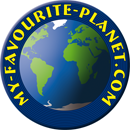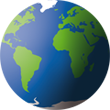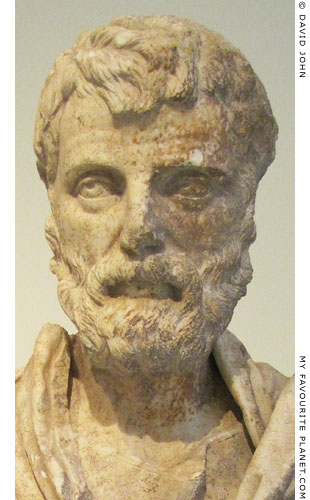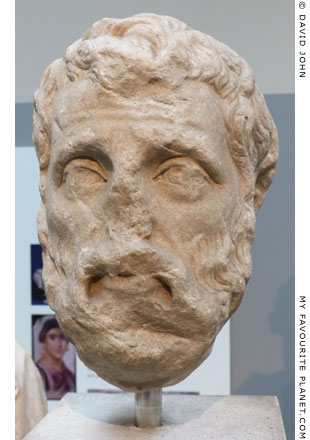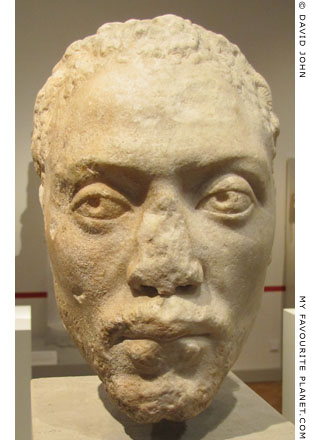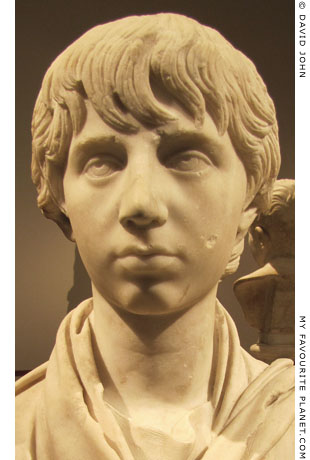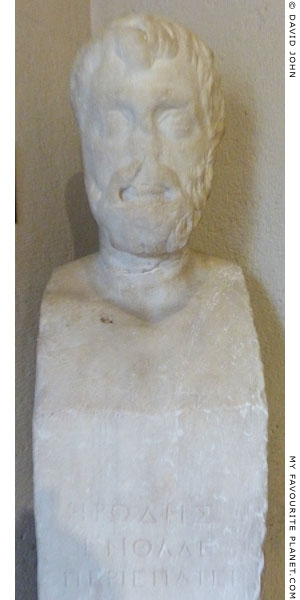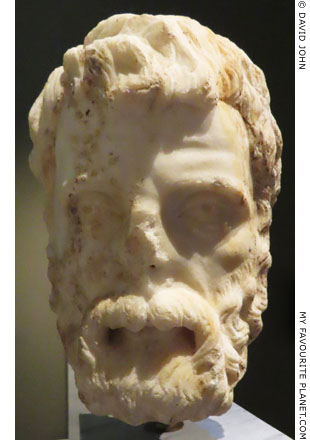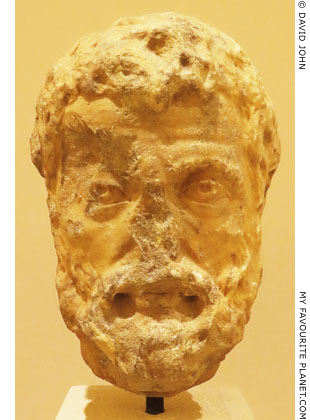|
| |
| 101-103 |
|
Herodes Atticus born at Marathon |
|
| |
| 122-125 |
|
Agoranomos of Athens (overseer of the market) |
|
| |
| 126/127 |
|
Archon of Athens |
|
| |
| 133 |
|
Praetor in Rome |
|
| |
| 134/135 |
|
Corrector of the Province of Asia under Proconsul Antoninus Pius (later emperor);
Dedication in Alexandria Troas |
|
| |
| 139/140 |
|
Agnothetes (manager) of the Panathenaic Games in Athens;
Start of construction of the Panathenaic Stadium |
|
| |
| 140-142 |
|
In Rome: Teacher of rhetoric to Marcus Aurelius;
Marries Annia Regilla;
Trial of the Athenians against Herodes in Rome concerning his father's will |
|
| |
| 143 |
|
Consul Ordinarius;
Birth and death of Claudius, his first child;
Birth of Elpinike, his second child |
|
| |
| 143-144 |
|
Building of the exedra in Delphi with statues of his family members |
|
| |
| 145-146 |
|
Teacher of rhetoric to Lucius Verus, adoptive brother and co-regent with Marcus Aurelius;
Birth of Athenais, his third child;
Birth of Regillus, his fourth child |
|
| |
| 152-153 |
|
Birth of Atticus Bradua, his fifth child (died after 209 AD) |
|
| |
| 153-161 |
|
Completion and dedication of the Nymphaeum in Olympia;
Professor of rhetoric in Athens;
Death of Regillus;
Death of Athenais;
Death of Annia Regilla and their sixth child;
Building of the Odeion in Athens;
Trial in Rome for the murder of Regilla;
Building of the Triopion in Rome |
|
| |
| 165 |
|
Death of Elpinike, leaving Atticus Bradua as Herodes' last surviving child;
Suicide of the Cynic philosopher Peregrinos Proteus near Olympia (see below) |
|
| |
| 167 |
|
Work on the stadium at Delphi |
|
| |
| 170-174 |
|
Quintilii brothers (Sextus Quintilius Condianus and Sextus Quintilius Valerius Maximus) governors in Greece (correctores Achaeae);
Emperor Marcus Aurelius reconstructs the Telesterion (temple of Demeter and Persephone) at Eleusis |
|
| |
| 174-175 |
|
Trial of the Athenians against Herodes at Sirmium, Pannonia before Marcus Aurelius;
Death of Polydeukes;
Return to Athens following a stay at Orikon, Epirus, due to exile or illness (see below) |
|
| |
| 176 |
|
Herodes may have been mystagogue to Marcus Aurelius, preparing him for initiation into the Mysteries at Eleusis (Philostratus, section 563, page 175 [see note 3]) |
|
| |
| 177-179 |
|
Death of Herodes at Marathon. Despite his wish to be buried there, Athenians take his body for burial at the Panathenaic Stadium. |
|
|
| |
Herodes
Atticus |
Aspasia Annia Regilla |
|
 |
|
Appia (or Aspasia) Annia Regilla Atilia Caucidia Tertulla (circa 125 - 158/160 AD; known in Greek as Ἀππία or Ἀσπασία Ἄννια Ῥήγιλλα, Aspasia Annia Regilla), Herodes Atticus' wife, was a member of an influential Roman aristocratic family and distantly related to the imperial line. She was married to Atticus around 140 AD, when she was about 14 and he was about 40. Of the six children they are known to have had, only three survived into adulthood (see below).
She was the priestess of Demeter at Olympia, the only woman allowed to attend the Olympic Games (see below), and built the Nymphaeum, a monumental fountain, also known as the Fountain or Exedra of Herodes Atticus, decorated with statues of Zeus, members of her and Atticus' families and the imperial family. The fountain also featured a marble statue of a bull, now in the Olympia Museum (see photo below), on the side of which a Greek inscription proclaims: "Regilla, priestess of Demeter, dedicated the water and the fixtures to Zeus."
Among her other distinctions, Annia Regilla was also the first priestess of Tyche (Τύχη; Latin, Fortuna) in Athens, probably at the temple of Tyche built by Atticus near the Panathenaic Stadium (see below). A statue of her stood in front of the sanctuary of Tyche in Corinth (see photo, right), and another was dedicated by the traders of Piraeus at the request of the Areopagus. No surviving sculpture head or bust can be definitely identified as a portrait of Regilla, although a now headless statue from the Nymphaeum in Olympia is thought to have depicted her (see photo below).
During the reign of Marcus Aurelius, Atticus was accused of murdering Regilla by her brother Appius Annius Atilius Bradua, who was at the time Consul. At the trial in Rome, around 160 AD, it was alleged that she died in premature childbirth after being kicked in the stomach by a freedman of Atticus while she was eight months pregnant with her sixth child (Philostratus, pages 159-163 [see note 3]). It is thought that the child also died, either at the same time or shortly after. Atticus was acquitted, and went on to erect monuments to her, including the Odeion of Herodes Atticus in Athens. The question of whether he was motivated by genuine grief or a sense of guilt continues to be debated by modern scholars.
Herodes Atticus built a temple-like tomb for her on the couple's estate, the Pagus Triopius, just outside Rome ( see photo below). See:
Sarah B. Pomeroy, The Murder of Regilla: A Case of Domestic Violence in Antiquity. Harvard University Press, Cambridge, MA, 2007.
Maud W. Gleason, Making Space for Bicultural Identity: Herodes Atticus Commemorates Regilla, Version 1.0, July 2008. Princeton/Stanford Working Papers in Classics, Stanford University.
Helen McClees, A Study of Women in Attic Inscriptions. Columbia University Press, New York, 1920. At the Internet Archive. |
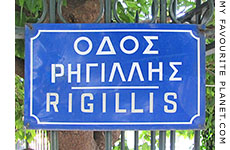
Rigillis Street (Οδός Ρηγίλλης), Athens,
named after Aspasia Annia Regilla.
Rigillis Street is the location
of Aristotle's Lyceum.
See Digging Aristotle
at The Cheshire Cat Blog. |
| |
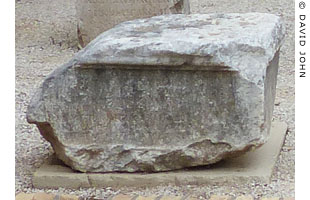
A base of a statue of Annia Regilla, found
in 1935 on the west side of the Forum of
Ancient Corinth. Dated around 143-160 AD.
The inscription on the base refers to a
statue, perhaps made during her lifetime,
dedicated by Herodes Atticus and set up
in front of the sanctuary of Tyche by the
boule (βουλή, city council) of Corinth. [9]
Corinth Archaeological Museum.
Inv. No. I 1658. |
| |
| |
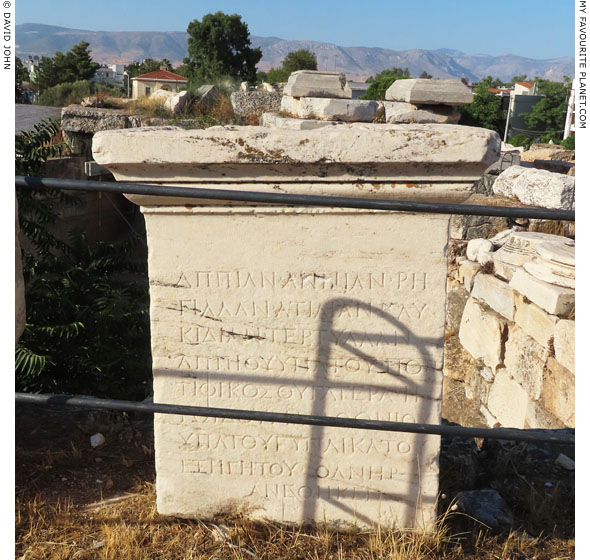
An inscribed marble base of a statue set up at Eleusis by
Herodes Atticus to honour his deceased wife, Annia Appia Regilla.
Circa 161 AD. Found in the court of the Telesterion,
the temple of Demeter and Persephone at Eleusis.
Ἀππίαν Ἀννίαν Ῥή-
γιλλαν Ἀτιλίαν Καυ-
κιδίαν Τερτύλλαν,
Ἀππίου ὑπάτου πον-
τίφικος θυγατέρα, Ἡ-
ρώιδου Μαραθωνίου
ὑπάτου γυναῖκα τοῦ
ἐξηγητοῦ ὁ ἀνὴρ
ἀνέθηκεν. |
Appia Annia
Regilla Atilia
Caucidia Tertulla,
daughter of Appius
consul and pontifex,
wife of Herodes of Marathon
consul and
interpreter. Her husband
dedicated [this statue]. |
Inscription IG II² 4072 (= I Eleusis 476)
Eleusis Archaeological Site. Inv. No. E1002. |
| |
Herodes
Atticus |
Children of Herodes Atticus and Annia Regilla |
|
 |
|
| |
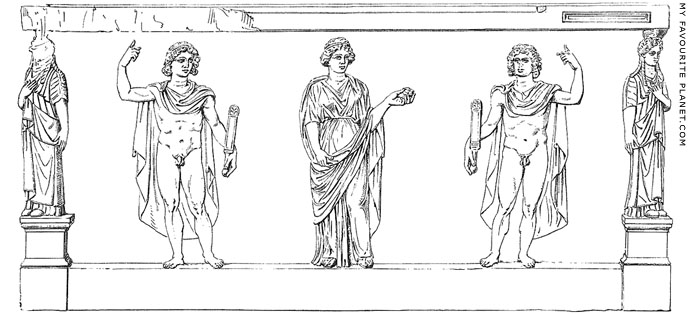
A relief of the Dioskouroi and their sister Helen of Troy on the front of the "Leda sarcophagus",
a marble sarcophagus in Kifissia, northeast of Athens. One of four sarcophagi in a marble tomb
discovered in Kifissia in September 1866, on what is thought to have been part of the estate of
Herodes Atticus and Annia Regilla. The sarcophagi are believed to be the graves of four of their
six children who died at a young age (see below). This sarcophagus may have been made for
Elpinike (Ἐλπινίκη), their second child and first daughter.
See further information about the "Leda sarcophagus" below. |
| |
According to available evidence, Herodes Atticus and Annia Regilla had six children.
For the conjectural dates of the births and deaths of the children, see the chronology above and note 8.
|
| 1. |
Son, unnamed (Claudius?), died in infancy (around 141-143 AD). Known only from a reference to Herodes grief over his death in a letter of Marcus Aurelius to Marcus Cornelius Fronto (Fronto, Epistulae, 1.6.10 [10]).
|
| 2. |
Daughter, Elpinike (Appia Annia Atilia Regilla Agrippina Elpinice Atria Polla [see note 1], around 143-165 AD). Perhaps named after the daughter of the Athenian general and statesman Miltiades (hero of the Battle of Marathon in 490 BC, from whom Herodes claimed descent), and stepsister and lover of the statesman Kimon.
|
| 3. |
Daughter, Athenais (Marcia Annia Claudia Alcia Athenais Gavidia Latiaria, around 145-161 AD). Perhaps buried within the city walls of Athens (Philostratus, The lives of the Sophists, Book II, section 558, see quote below).
|
| 4. |
Son, Regillus (Tiberius Claudius Herodes Lucius Vibullius Regillus, around 146-161 AD).
|
| 5. |
Son, Atticus Bradua (Tiberius Claudius Marcus Appius Atilius Bradua Regillus Atticus, around 152 - after 209 AD). The only child to outlive his parents, he was consul ordinarius in 185 AD, an archon of Athens in 187 AD and some time after proconsul of a Roman Province, perhaps Africa. He was honoured as a herald by the Athenian boule in 209 AD.
|
| 6. |
Unnamed child, thought to have been a son born prematurely, and to have died with Regilla or 3 months later, around 160 AD (see below). |
| |
Herodes Atticus' three known adopted sons (dates unknown):
Achilles (Ἀχιλλεύς, Achilleus) see below;
Memnon (Mέμνων), an African ("an Ethiopian"), see photo above;
Polydeukion (Πολυδευκίων), also referred to as Polydeukes (Πολυδεύκης), see below.
Lucius Vibullius, illegitimate son of Rufus see below. |
|
| |
Herodes
Atticus |
The Triopion estate, Rome |
|
 |
|
| |
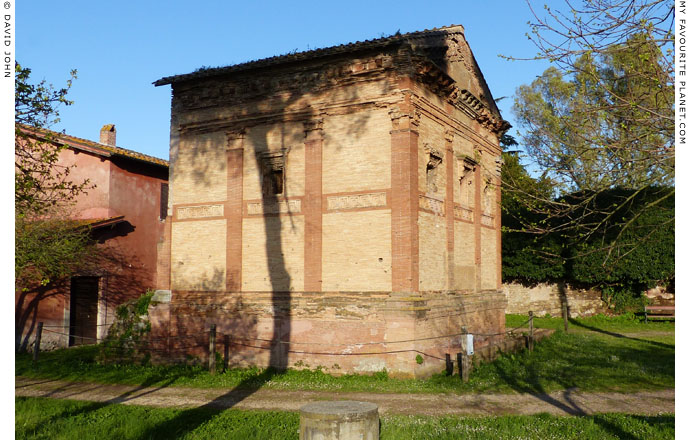
The "Tomb of Annia Regilla" in Caffarella Park, near the Via Appia, southeast of Rome city centre.
|
The tomb was built by Herodes Atticus for his deceased wife on his estate, known as the Pagus Triopius (Triopius Farm), in the Valle della Caffarella, between the Via Appia and the Almone river, outside the Aurelian Wall. Since Annia Regilla is thought to have been buried near Athens (although her tomb has not yet been found, see below), this may have been a cenotaph (κενοτάφιον, kenotaphion, symbolic empty grave) or shrine to her, unless her remains had been returned to Rome.
The area around the tomb is open to the public
on Saturdays and Sundays, 10 am - 4 pm (6 pm in summer).
It is thought that the estate, on the left side of the Via Appia between the second and third milestones, may have originally belonged to the family of Annia Regilla, and have been part of her dowry when she married Herodes Atticus. As part of his efforts to proclaim his grief over her death, Herodes renamed the estate Triopion (Τριόπιον, perhaps after the mythical hero Triopas [11]), dedicated to the gods of the underworld and the funeral cult of Regilla. The area included a temple dedicated to Demeter and Persephone and the "new Demeter", the deified Faustina Major (Annia Galeria Faustina, circa 100-140 AD), wife of Emperor Antoninus Pius. A statue of Annia Regilla, "neither god nor mortal", stood in the temple (see below).
Much of the area of the Triopion was later taken over by the palace of Emperor Maxentius (reigned 306-312 AD). The temple of Demeter was converted in the 9th - 10th century into the church of Sant' Urbano alla Caffarella (see below), an oratory dedicated to Saint Urban who was Pope 222-230 AD. |
|
| |
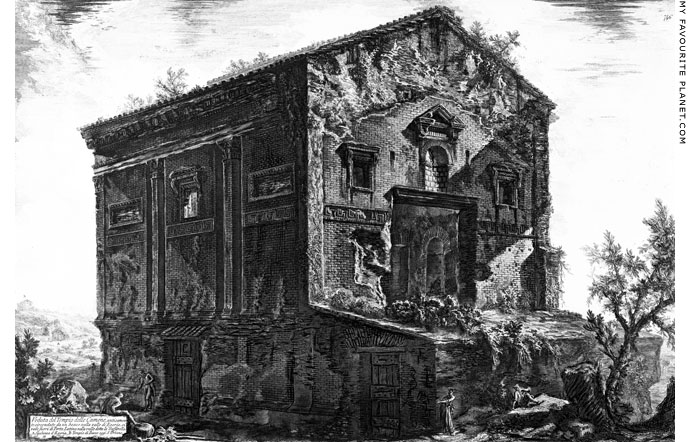
An etching of the tomb of Annia Regilla made 1748-1774 by Giambattista Piranesi (1720-1778).
The view shows the front (east) and south side of the tomb, labelled by Piranesi as the "Tempio
delle Camene". It is surrounded by a number of small imaginery figures, which give the impression
that the building is much larger than actually is. In the background, at the extreme left of the image
is the church of Sant' Urbano, the ancient temple of Demeter and Persephone (see below).
Source: Giovanni Battista Piranesi, Francesco Piranesi and others, Vedute di Roma, Tomo I
(Volume 1 of 2), tavolo 62. Presso l'Autore a strada Felice..., Rome, 1779. At the Internet Archive. |
| |

An etching of the church of Sant' Urbano alla Caffarella by Giambattista Piranesi.
Source: Giovanni Battista Piranesi, Francesco Piranesi and others, Vedute di Roma, Tomo I
(Volume 1 of 2), tavolo 60. Presso l'Autore a strada Felice..., Rome, 1779. At the Internet Archive.
|
| |
The temple of Demeter and Persephone on the Triopion estate of Herodes Atticus near the Via Appia, southeast of Rome. The ruined building was restored by Pope Urban VIII Barberini in 1634, when it was stabilized by massive buttresses, and the spaces between the four Corinthian columns of the front porch (pronaos) were bricked up.
It was believed at the time to have been the Tempio di Bacco (temple of Bacchus), because of an inscribed cylindrical altar found inside (see image, right) that had been dedicated to Dionysus in the second half of the 2nd century by the hierophant Apronianus, a high priest of Demeter at Eleusis.
The barrel vaulted ceiling was decorated with octagonal panels with stucco reliefs, most of which have not survived. The central panel still has part of a relief showing a male and female, thought to represent Herodes Atticus and Annia Regilla, walking in a procession bringing offerings to the deity (or deities). Along the base of the ceiling is a frieze with a coat of arms (see Piranesi's etching of the church interior below). In the 11th century the upper walls of the building's interior were covered by paintings with Christian themes, scenes from the New Testament and the martyrdom of Saint Urban and Saint Cecilia, which were restored by the Barberini family in 1637. |
|
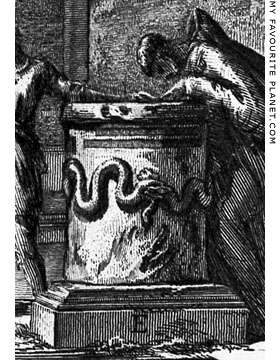
The cylindrical altar inside the church,
decorated with a relief of a snake
coiled around the shaft and inscribed
with a dedication to Dionysus
by the hierophant Apronianus.
Detail of Piranesi's etching of the
interior of the church of Sant' Urbano
alla Caffarella (see below). |
|
| |

An etching of the interior of the church of Sant' Urbano alla Caffarella, by Giambattista Piranesi.
Unfortunately, the picture of the dark interior does not include the stucco relief on the ceiling.
Source: Giovanni Battista Piranesi, Francesco Piranesi and others, Vedute di Roma, Tomo I, tavolo 61. |
| |
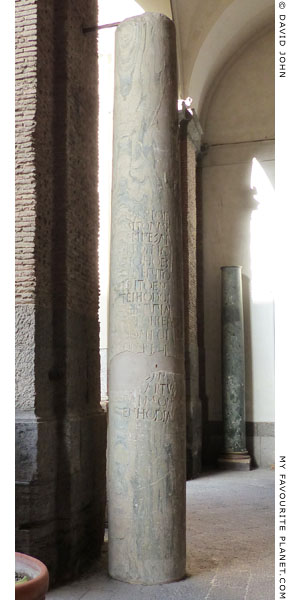 |
|
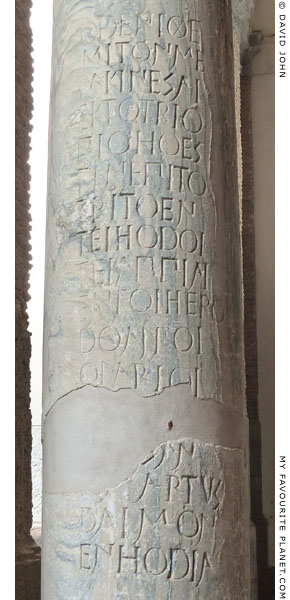 |
One of two inscribed marble columns from the temple of Demeter and Persephone in the Triopion.
Circa 138-161 AD. Found in 1607 near the
Tomb of Caecilia Metella on the Via Appia, Rome.
National Archaeological Museum, Naples.
Inv. Nos. 2400 and 2401. From the Farnese Collection.
|
|
The Greek inscriptions on the two columns as well as those on two marble steles (see below) found at the site of the Triopion are unsurprisingly known as the "Triopian inscriptions". As with other dedications and memorials set up by Herodes Atticus, the dedications include curse texts (see below), threatening thieves and vandals with the wrath of the underworld deities:
καὶ ℎοι κίονες Δέμετρος καὶ Κόρες ἀνάθεμα καὶ χθονίον θεο͂ν· καὶ ὀδενὶ θεμιτὸν μετακινε͂σαι ἐκ το͂ Τριοπίο ℎό ἐστιν ἐπὶ το͂ τρίτο ἐν τε͂ι ℎοδο͂ι τε͂ι Ἀππίαι ἐν το͂ι ℎερόδο ἀγρο͂ι. ὀ γὰρ λο͂ιον το͂ι κινέσαντι· μάρτυς δαίμον Ἐνℎοδία
And these columns are an offering to Demeter, Kore, and the chthonic deity. No one is permitted to remove anything from the Triopion which is at the third [milestone] of the Appian Way in the land of Herodes. No good will come to him who moves it: Enhodia the [underworld] daimon is witness.
Inscription IG XIV 1390 (IGUR II 339a and IGUR II 339b at The Packard Humanities Institute (PHI).
Source of drawings, right:
August Boeckh (editor), Corpus Inscriptionum Graecarum, Volume I, No. 26, pages 42-46. Officina Academica, Berlin, 1828. At Googlebooks.
Two marble marble steles, found at the site of the Triopion around the same time as the columns, are inscribed with an epitaph for the heroized Annia Regilla, written in Greek hexameter verse. Stele B was discovered in 1607 and stele A around 1616. They were acquired by Cardinal Scipione Borghese for his collection in the Villa Borghese on the Pincian Hill, Rome, and they remained there until 1808, when they were taken to Paris by Napoleon, and are now in the Louvre.
The first and main part of the epitaph is the fifty nine line poem on stele A, which is 122 cm tall. At the top, written in letters larger than the rest of the text, is the signature of Marcellus (Μαρκέλλου, genitive), believed to be the poet Marcellus of Side (Μάρκελλος Σιδήτης, Markellos Sidetes), otherwise known for long poems on medical remedies, werewolves and fish.
The text, dense with ancient literary allusions to deities, heroes and mythological events, refers to a shrine surrounding a seated statue of Regilla in the sanctuary, "the sacred image of the well-girt wife" dedicated to the New Deo (Faustina Major) and the Old (Demeter). Roman women, addressed as "daughters of the Tiber", are invited to bring her sacred offerings. She is praised as "she of the beautiful ankles", "descended from Aeneas and was of the race of Ganymede". She had been an attendant to Faustina in her youth and a priestess of her cult.
Being "neither mortal, nor divine", Regilla "has neither sacred temple nor tomb, neither honours for mortals, nor honours like those for the divine". This seems to indicate that the nearby "Tomb of Annia Regilla" (see above) had not yet been built. The poem also states that she is buried in Attica: "In a deme of Athens is a tomb for her like a temple". Frustratingly for historians and archaeologists, the name of the deme is not given, and the tomb has yet to be found.
Herodes is described on one hand as a proud descendant of Kekrops, Keryx and Theseus. "In Greece there is no family or reputation more royal than Herodes'. They call him the voice of Athens." On the other hand he is portrayed as a pitiable "grieving spouse lying in the middle of his widower's bed in harsh old age", mourning the loss of his wife and children, who have been snatched from his "blameless house". We are told that "half of his many children" had already died at the time the dedication was made and that "two young children are still left", probably Elpinike and Atticus Bradua, who is also alluded to in the text.
The thirty nine line inscription on the 117 cm high stele B calls upon the goddesses Athena and Nemesis to protect "this fruitful estate of the Triopeion sacred to Deo [Demeter], a place friendly to strangers, in order that the Triopeion goddesses be honoured among immortals". Addressing the reader, the poem continues: "For you Herodes sanctified the land and built a rounded wall encircling it not to be moved or violated, for the benefit of future generations." The last part contains a curse text, threatening divine retribution on anyone who disturbs the sanctity of the estate.
Inscription IG XIV 1389 (= IGUR III 1155 at The Packard Humanities Institute (PHI).
See: Malcolm Davies and Sarah B. Pomeroy, Marcellus of Side’s epitaph on Regilla (IG XIV 1389): an historical and literary commentary. In: Prometheus, Volume 38, pages 3-34. Firenze University Press, 2012. PDF at Firenze University Press Open Journal Systems. The article includes the Greek texts of the inscriptions, English translations and commentary, as well as photos of the two steles. |
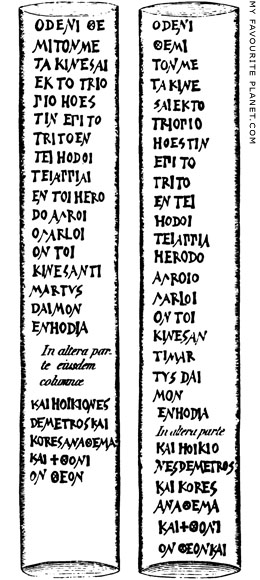
Drawings of the inscriptions
on the Triopion columns. |
| |
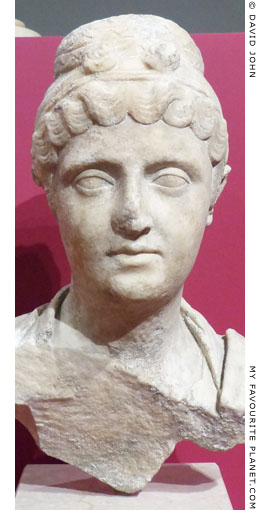
Detail of a marble portrait bust of
Faustina Major (circa 100-140 AD),
wife of Emperor Antoninus Pius.
Portrait of the Dresden type.
Around 150 AD.
Museum für Kunst und Gewerbe
Hamburg.
Inv. No. 11992.337 / St. 3934.
Property of the Stiftung für die
Hamburger Kunstsammlung. |
| |
| |
Another inscription from the Triopion is a bilingual dedication to Annia Regilla, in Greek and Latin, on a 198 cm high grey marble column, thought to have been a base for a statue or bust (see drawing, right). Around 309 AD the other side of the column was reinscribed as a milestone (the seventh from the Porta Capena), during repair works to the Via Appia by Emperor Maxentius. In the Middle Ages it was moved to the Sant' Eusebio monastery on the Esquiline Hill, Rome, where it was found in 1698. It was later seen in the monastery garden by Cardinal Alessandro Albani who purchased it for his collection. It is now in the Capitoline Museums. Inv. No. NCE 2532.
Ἀννία · Ῥηγίλλα
Ἡρῴδου γυνή, τὸ φῶς
τῆς οἰκίας, τίνος ταῦ-
τα τὰ χωρία γέγοναν
Annia · Regilla
Herodis uxor
lumen domus
cuius haec
praedia
fuerunt
Annia Regilla, wife of Herodes, the light of the house, to whom these lands once belonged.
Inscription IG XIV 1391 (= CIG 6184 and IGUR II 340 at The Packard Humanities Institute).
The wording is similar to a dedication on an inscribed altar found in the mid 19th century at a ruined church between Kifissia and modern Marousi.
Ἀππία Ἀννία Ῥηγίλλα Ἡρῴδου γυνή, τὸ φῶς τῆς οἰκίας
Appia Annia Regilla, wife of Herodes, the light of the house.
Inscription IG II² 13200 at The Packard Humanities Institute.
It has been suggested that the altar may be associated with Regilla's tomb, the location of which remains unknown. |
|
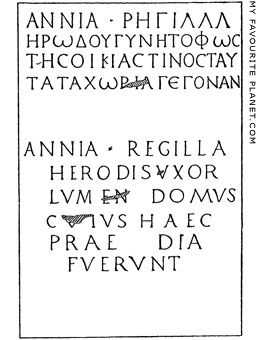
Drawing of the bilingual dedication
to Annia Regilla on a marble column
from Rome.
Inscription IG XIV 1391.
Capitoline Museums, Rome.
Inv. No. NCE 2532.
Source: Christian Hülsen, Zu den
Inschriften des Herodes Atticus.
In: Rheinisches Museum für
Philologie, Band 45 (1890), pages
284-287. PDF at Rheinisches
Museum für Philologie. |
|
| |
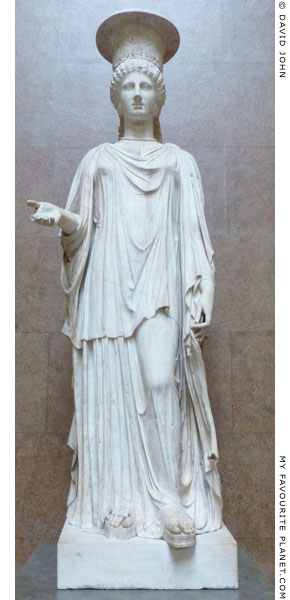 |
|
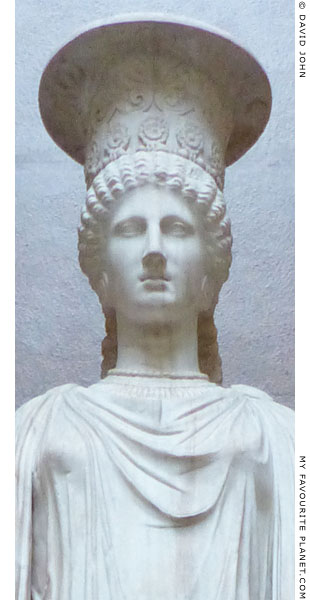 |
The "Townley Caryatid" from the Triopion.
Circa 140-170 AD. Classicist Neo-Attic style. Found 1585-1590 near the Via Appia.
Pentelic marble. Over lifesize, height 220 cm (237 cm with restored plinth).
British Museum. Inv. No. GR 1805.7-3.44 (Sculpture 1746).
Acquired in 1805 from the Townley Collection. |
|
| |
The restored frontal figure wears a tall, tapering kalathos (a headdress particularly associated with the cult of Demeter), decorated with a row of palmettes and lotus buds, a row of rosettes and a bead-and-reel rim; rosette earrings, a bead necklace above a strap necklace with seed-shaped pendants; a peplos and a himation, fastened at the shoulders by large round buttons; and platform sandals. She has a melon hairstyle, with corkscrew locks falling over her back. The head faces forward, the fnely-carved face is expressionless, the lips slightly parted. Her raised right forearm is extended forwards with her open hand palm upwards. Her left arm is at her side. Her bent left leg is visible through the thin peplos, the left foot advanced. The right leg is obscured by the vertical folds of the peplos, beneath which the front of the foot can be seen.
The figure is one of six caryatids, differing in several details, found at the Triopion site. They formed a colonnade in a religious sanctuary, probably of the temple of Demeter and Persephone built by Herodus Atticus. This is one of two caryatids found 1585-1590 at the Triopion site, the other is in the Vatican Museums, Inv. No. 2270. In an 1812 catalogue of the British Museum (see image and citation, right) the findspot was described as "amongst some ancient ruins in the Villa Strozzi, situated on the Appian Road, about a mile and a half beyond the tomb of Caecilia Metella, commonly called Capo di Bove."
Another three were discovered there in 1765/1766 and are now in the Villa Albani-Torlonia, Rome (see Antinous), including a fragmentary caryatid, the head of which is attached to part of a pilaster signed by two unknown Athenian sculptors, Kriton and Nikolaos:
ΚΡΙΤΟΝ ΚΑΙ ΝΙΚΟΛΑΟΣ ΑΘΗΝΑΙΟΙ ΕΠΟΙΟΥΝ
Also found there at this time was a statue identified as Dionysus, prompting Giambattista Piranesi (1720-1778), who was present at the excavation, to believe that the caryatids were part of a temple to the wine god. [12]
A sixth fragmentary caryatid was discovered during excavations in 2003-2005.
The "Townley Caryatid" was acquired by Pope Sixtus V (Felice Peretti di Montalto, 1521-1590) and kept at the Villa Peretti Montalto, which was sold in 1696 to Cardinal Giovanni Francesco Negroni and became known as Villa Negroni. Antiquities in the collection of the villa were sold in 1785 to the art dealer Thomas Jenkins (1724-1798). The caryatid was among a number of artworks from the collection purchased from him in 1786 by the British collector Charles Townley, who believed it to be a statue of Isis.
Professor Olga Palagia has recently reported suggestions that the head of one of three caryatids found in 1882 in central Athens (now in the National Archaeological Museum, Athens, not on display) is a duplicate of that of the Townley Caryatid, and that the three figures may have originally decorated a now lost propylon of the City Eleusinion near the Athenian Agora [13]. These suggestions may strengthen the association of the Triopion caryatids with the temple of Demeter there.
See also:
The caryatids of the Erechtheion on the Athens Acropolis.
A caryatid from Tralles, Ionia |
|
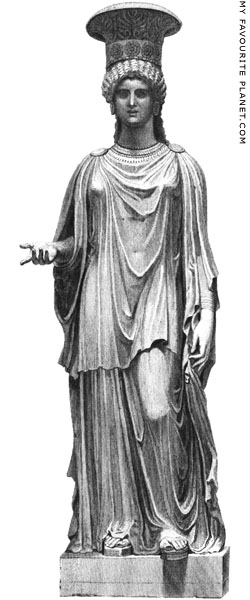
An engraving of the Townley Caryatid
in an early catalogue of the British
Museum, in which it is described as
"a female statue, larger than life,
with a modius on the head."
Taylor Combe (editor), A description
of the collection of ancient marbles
in the British Museum, Part 1,
Plate IV. Longman, Hurst, Rees,
Orme and Co., London, 1812. |
|
| |
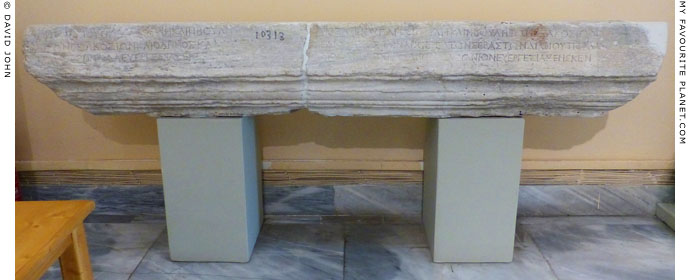
A marble epistyle from a building in Athens with two dedicatory inscriptions
for Herodes Atticus and his second daughter Claudia Athenais by the Council
of the Areopagus, Council (βουλὴ, Boule) of the 600 and the Assembly of the
People (δῆμος, demos). Before 150 AD.
|
ἡ είου πάλὴ καὶ ἡ βουλὴ τῶν ἑξακοσίων καὶ ὁ δῆμος Κλαυδίαν Ἀθηναΐδα εὐεργεσίας ἕνεκεν.
ἡ ἐξ Ἀρείου πάγουλὴ καὶ ἡ βουλὴ τῶν ἑξακοσίων καὶ ὁ δῆμος τὸν ἀρχιερέα τῶν Σεβαστῶν διὰ
βίου Τιβ Κλαύδιον Ἀττικὸν Ἡρώδην Μαραθώνιον εὐεργεσίας ἕνεκεν.
Athens Epigraphical Museum. Inv. No. EM 10313.
Inscription IG II² 3594 / 5 (IG III 664 and IG III 665 [14]).
Marcia Annia Claudia Alcia Athenais Gavidia Latiaria (circa 143-161 AD), usually referred to
as Athenais (Άθηναΐς) or Athenaides (Ἀθηναΐδες), was the third child of Herodes Atticus
and Annia Regilla, and their second daughter (see photo below). |
|
| |
Herodes
Atticus |
The Nymphaeum of Herodes Atticus in Olympia |
|
 |
|
| |
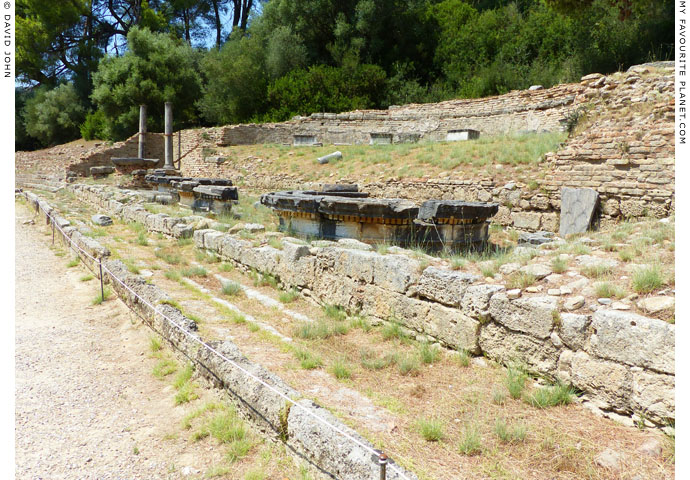
The remains of the Nymphaeum of Herodes Atticus in the Sanctuary of Zeus, Olympia.
|
The Nymphaeum (Greek, νυμφαῖον, nymphaion) was an monumental fountain on the lower slope of the Kronion (Κρόνιον, Kronos Hill), on the north side of the Altis, the sacred area of the Sanctuary of Zeus at Olympia. It stood between the Heraion (Ἥραιον, Temple of Hera) and the terrace of treasuries set up by Greek cities. Supplied with water by a 4 kilometre long aqueduct fed by local springs, it is thought to have been the first construction to provide the sanctuary with running, fresh water in its long history. Previously water was taken from wells and the Kladeos river (Κλάδεος), which was a winter torrent and sometimes dry in summer. Fresh water had often been in short supply during the Olympic Games, which were held in the hottest months July and August. [15]
The 33 metre wide fountain was at least 13 metres tall, perhaps as high as 18 metres, and because of its hillside position at the highest part of the Altis, it stood above the level of the sanctuary's centre. It thus dominated the area, and only the 23.5 metre tall Temple of Zeus was taller.
Built of brick and clad in marble, the Nymphaeum consisted of a semicircular basin with a diameter of 16.8 metres into which water poured through a row of bronze spouts decorated with stone lion head reliefs. In turn water from spouts in the front wall of the basin flowed into a 21.9 metre long and 3.43 metre wide rectangular pool 2.5 metres below it. From the front wall of this lower pool spouts fed a long channel which ran along the front of the monument and around the sanctuary. At either end of the long pool stood a monopteros (μονόπτερος, an open, circular, temple-like building [16]) with a conical marble roof supported by a ring of eight Corinthian columns, in which stood a statue, probably of an emperor. Parts of the two monopteroi stand on the site (see photos, right).
Over and around the curved rear edge of the top basin was a three-storey exedra (semicircular recess) supported at the rear by buttresses, designed as the decorative crown of the monument. The spouts along the front wall of the lowest storey fed water from the aqueduct into the basin below. Each of the two top storeys had a row of 12 arched niches framed by double Corinthian columns, in which stood statues of Herodes Atticus, Regilla, the emperors Antoninus Pius, Hadrian and Marcus Aurelius as well as members of their respective families. In a central niche on each storey (probably the sixth niche from the left) stood a statue of Zeus (see photo below).
Regilla's inscribed bull statue (see below) is thought to have stood on top of the centre of the wall of the top basin. According to the inscription on its side the fountain was dedicated by Aspasia Annia Regilla to Zeus. It is thought that she initiated and paid for the building of the Nymphaeum, while her husband Herodes Atticus financed the construction of the aqueduct.
"He [Herodes] also dedicated the stadium at Pytho to the Pythian god, and the aqueduct at Olympia to Zeus..."
Philostratus, The lives of the Sophists, section 551, page 149 [see note 3].
It has been suggested that the fountain should properly be called the Nymphaeum of Annia Regilla, although some scholars believe that Herodes may have been responsible for its construction and dedicated it in his wife's name.
It was for long generally agreed by scholars that the Nymphaeum was built between 149 and 153 AD, particularly since it is thought that Regilla was the priestess of Demeter Chamyne during the 233rd Olympiad in 153 AD and that the building was completed by the opening of the games. However, some scholars believe that it may have been completed around 160 AD or even later, after Regilla's death. It is not mentioned by Pausanias, who visited Olympia around 155 AD. This makes the dating of the various statues more difficult to estimate.
A number of bases of the statues from the Nymphaeum, many in fragments, were found by archaeologists in 1880-1888 in or near the Nymphaeum, and others were discovered in 1877-1878 built into the floor of an early Christian church. Inscriptions on the surviving bases state that the statues of the emperors' and their family members were dedicated by Herodes Atticus, while the statues of Herodes, Regilla and their family members were dedicated by the citizens of the city of Elis (Ἦλις), in whose territory Olympia stood and who controlled the Olympic Games.
Some of the surviving statue bases now stand in front of the remains curved back wall of the Nymphaeum, and can be seen in the photo above. Unfortunately, they are too high and far away from the footpath to read the inscriptions.
Many of the statues (mostly headless), displaced heads and other fragments from the Nymphaeum are now in the Olympia Archaeological Museum, while some are currently in the nearby Museum of the History of the Ancient Olympic Games. Other statues were taken to Berlin by the German archaeologists, as part of an agreement with the Greek government. See photos below.
Attempts have been made to match heads and other fragments to statues, and statues to the inscribed bases in order to identify the individual figures. Several identifications remain subjects of debate. So far we have included below only photos of a few of these statues. |
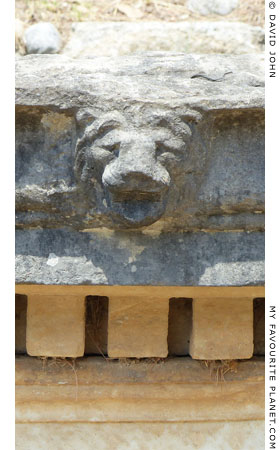
One of the row of lion head reliefs which
decorated the top of the entablature
of each monopteros of the Nymphaeum
of Herodes Atticus, Olympia. They had
no function but imitated the lion head
spouts of the fountain. |
| |
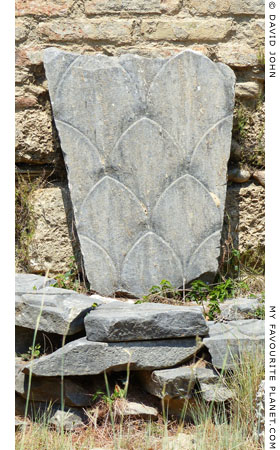
A fragment of a carved marble roof
tile of one of the monopteroi.
Another fragment is in now the
Antikensammlung of the Berlin State
Museums (SMB). Inv. No. SK 1441.
See www.smb-digital.de/... at the
SMB website Collections database. |
| |
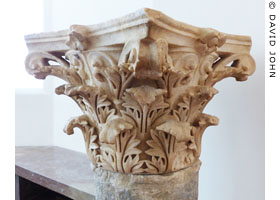
A marble Corinthian pilaster capital
from one of the monopteroi.
Olympia Archaeological Museum. |
| |
| |
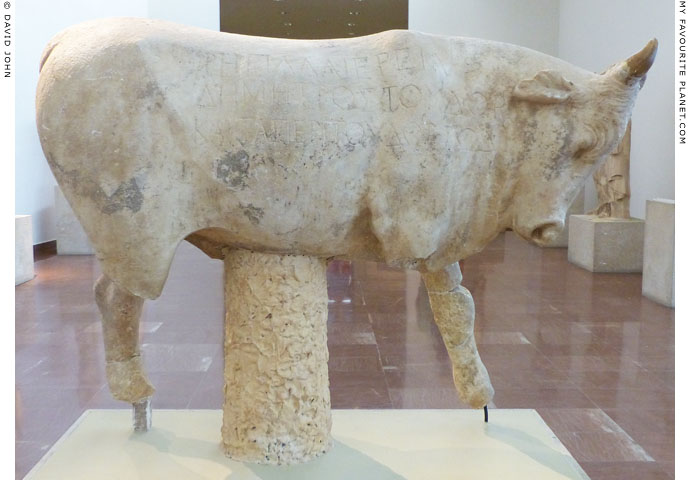
A marble statue of a bull from the Nymphaeum of Herodes Atticus in Olympia,
inscribed on the right side with a votive dedication of Aspasia Annia Regilla
as the priestess of Demeter Chamyne (see below):
Ῥήγιλλα, ἱέρεια Δήμητρος, τὸ ὕδωρ καὶ τὰ περὶ τὸ ὕδωρ τῷ Διί
Regilla, priestess of Demeter, dedicated the water and the fixtures to Zeus.
Inscription IvO 610. Wilhelm Dittenberger and Karl Purgold,
Die Inschriften von Olympia (IvO), in Olympia, 5. Berlin 1896.
Around 149-153 AD. Height 105 cm, width 160 cm.
Olympia Archaeological Museum. Inv. No. Λ 164.
|
Regilla also dedicated a statue in the sanctuary of the health goddess Hygieia (see Asklepios) in the Altis at Olympia. The surviving marble statue base is inscribed simply:
Ῥήγιλλα Ὑγείαι
Regilla to Hygieia
Inscription IvO 288. |
|
| |
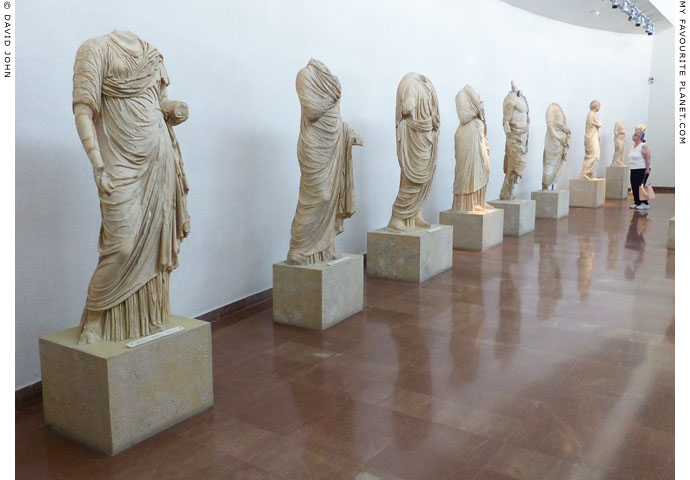
A row of marble statues, now nearly all headless,
from the Nymphaeum of Herodes Atticus in Olympia.
Mid 2nd century AD.
Olympia Archaeological Museum. |
| |
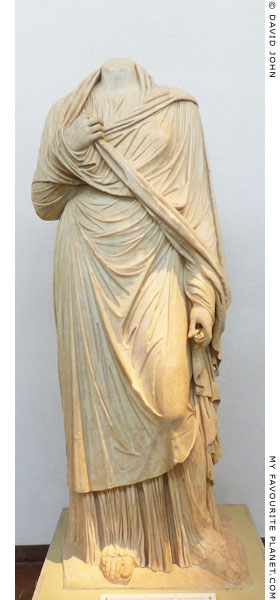
Marble statue of the "Large Herculaneum
Woman" type, now headless, thought
to depict Aspasia Annia Regilla.
From the Nymphaeum in Olympia.
Mid 2nd century AD. Height 183 cm.
Olympia Archaeological Museum.
Inv. No. Λ 156. |
|
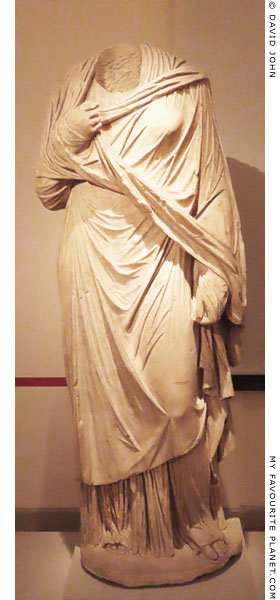
Headless marble statue of the "Large
Herculaneum Woman" type, believed
to depict an empress, perhaps Sabina,
wife of Emperor Hadrian.
From the Nymphaeum in Olympia.
Mid 2nd century AD. Height 180 cm.
Altes Museum, Berlin. Inv. No. 1398.
Acquired in 1889 from the
excavations at Olympia.
|
The two statue bodies are remarkably similar, even to the individual folds on the garments.
See also two statue bodies from Patras below.
Another similar, unrelated headless statue in Olympia, found in the pronaos of the Heraion
and dated 2nd half of the 1st century AD, is thought to depict a distinguished Eleian woman.
Inv. No. Λ 139 (currently exhibited in the Museum of the History of the Ancient Olympic Games). |
|
| |
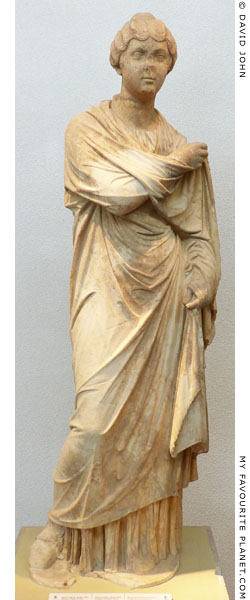
Marble statue of the "Small Herculaneum
Woman" type, thought to depict Athenais,
third child and second daughter of
Herodes Atticus and Annia Regilla.
From the Nymphaeum in Olympia.
Mid 2nd century AD. Height 180 cm.
The features of the portrait head are
those of an adolescent, although it has
been estimated that Athinais may have
been around ten years old at the time
the Nymphaeum was completed.
Olympia Archaeological Museum.
Inv. No. Λ 159. |
|
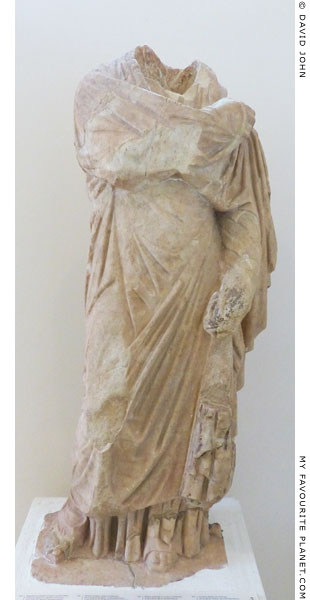
Headless "Small Herculaneum Woman" type
marble statue, thought to depict Athenais,
the second daughter of Herodes Atticus
and Annia Regilla.
Found in the Altis, Olympia.
Mid 2nd century AD.
Olympia Archaeological Museum.
Inv. No. Λ 161.
Currently exhibited in the Museum of the History
of the Ancient Olympic Games, Olympia. |
|
| |
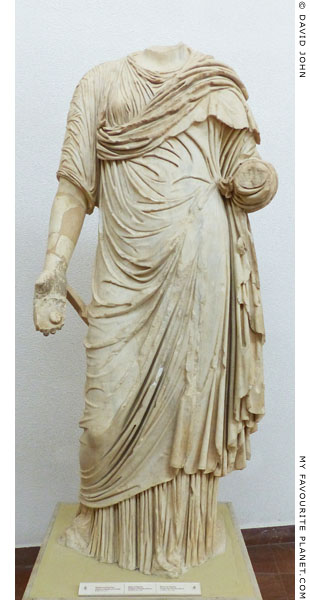
Headless marble statue of a woman,
believed to depict Elpinike, second child
and first daughter of Herodes Atticus
and Annia Regilla. The figure holds a phiale
(libation bowl) in her lowered right hand.
From the Nymphaeum of Herodes Atticus,
Olympia. Mid 2nd century AD.
Olympia Archaeological Museum. |
|

Headless marble statue of a yound male
in a toga, believed to depict Regillus, fifth
chlid and third son of Herodes Atticus
and Annia Regilla.
From the Nymphaeum of Herodes Atticus,
Olympia. Mid 2nd century AD.
Olympia Archaeological Museum. |
|
| |
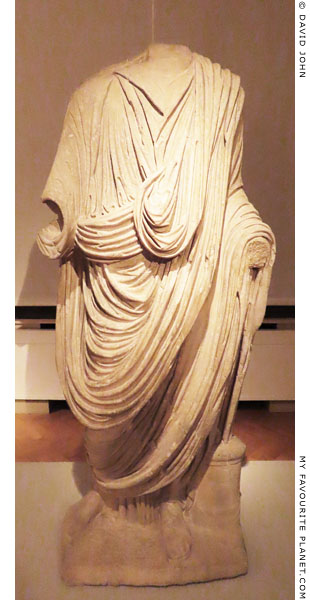
Headless marble statue of a man in a toga,
believed to depict Herodes Atticus.
From the Nymphaeum of Herodes Atticus,
Olympia. Mid 2nd century AD.
Altes Museum, Berlin. Inv. No. 1399.
Acquired in 1889 from the
excavations at Olympia. |
|
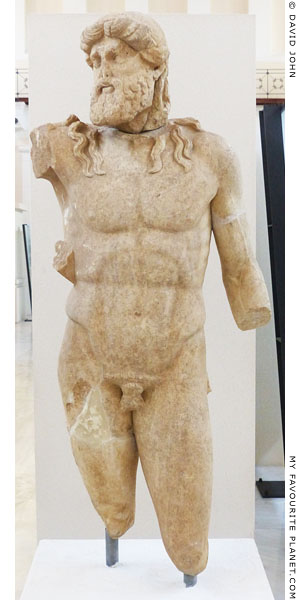
Marble statue of a nude Zeus from the
Nymphaeum of Herodes Atticus, Olympia.
Mid 2nd century AD. Thought to by a copy
of a work by Myron, around 460 BC.
Pentelic marble. Height 167 cm.
The torso, parts of the head and other
fragments were found over many years
at the Nymphaeum and various places
around Olympia, some built into later
walls of buildings. The fragments were
first reassembled in 1972.
Olympia Archaeological Museum.
Inv. No. Λ 109.
(The torso was originally numbered
Λ 170 and the head Λ 109.)
Currently exhibited in the Museum
of the History of the Ancient Olympic
Games, Olympia.
The headless torso and several fragments
of the other statue of Zeus from the
Nymphaeum were found in 1878, built into
a wall between the Gymnasium and the
north gateway of the Altis. The god is
shown wearing a himation. Inv. No. Λ 108. |
|
| |
Herodes
Atticus |
The stadium of Olympia |
|
 |
|
| |
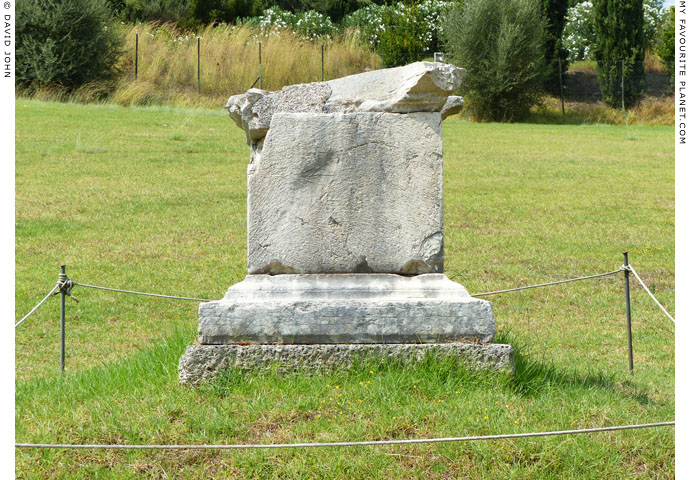
The altar of Demeter Chamyne on the low hill north of the stadium of Olympia. 2nd century AD.
|
Built of white stone blocks reused from an equestrian monument, the altar has been dated to the 2nd century AD. It has been suggested that it may have been set up for Regilla when she was priestess of Demeter in 153 AD, or even financed by her.
According to Pausanias, the epiphet of Demeter in the ancient Peloponnesian district of Elis (Ἦλις) was Chamyne (Χαμύνη), and there was a sanctuary of the goddess on the low hill north of the Olympic stadium (race track). At the time of his visit to Olympia, around 155 AD, new Pentelic marble statues of Demeter and Persephone (the Maid) in the sanctuary had been donated by Herodes Atticus.
In 2006 the remains of what are thought to be the sanctuary of Demeter Chamyne were discovered by chance during the digging of a water supply project, around 150 metres northeast of the stadium. They include a large building, dubbed Building A, built of local limestone, oriented east-west and divided into four rooms. Dated to the early 5th century BC, it is thought to have served a cult function, and in one of the rooms was a stone feature, perhaps an altar, surrounded by votive objects.
Objects discovered during the ensuing archaeological excavations of 2007 and 2008 include 34 bronze coins of the 5th - 4th century BC, several terracotta figures, most depicting human female subjects, but also animals, particularly bovines and goats, as well as silens and masks. One depicts a two-headed Kerberos with sacrificial cakes in its mouth, and another Kerberos figure is inscribed [Δά]ματρι, Κόρ[αι], [Βα]σιλεῖ, dedicated to Demeter, Persephone (Kore) and Plouton (Basileus, king of Hades). Part of a Roman period baths was also discovered on the site.
The office of cult priestess of Demeter Chamyne, appointed or "bestowed" (awarded) by the Elians "from time to time", which indicates that it was an honorary and temporary position for the duration of an Olympiad. She was the only woman allowed to attend the Olympic Games, and watched the competitions while seated on the altar of Demeter Chamyne, halfway along the length of the race course, directly opposite the stand of the competition judges (Ἑλλανοδίκαι, Hellanodikai). "Maidens" (παρθένοι, parthenoi, virgins), girls or unmarried young women, were admitted to Olympia, and there were also games for girls, a series of foot races known as the Heraia (Ἡραῖα, in honour of Hera; Pausanias, Description of Greece, Book 5, chapter 16, sections 2-8).
"Now the stadium is an embankment of earth, and on it is a seat for the presidents of the games. Opposite the umpires is an altar of white marble. Seated on this altar a woman looks on at the Olympic games, the priestess of Demeter Chamyne, which office the Eleans bestow from time to time on different women. Maidens are not debarred from looking on at the games."
Pausanias, Description of Greece, Book 6, chapter 20, sections 8-9.
"The other side of the course is not a bank of earth but a low hill. At the foot of the hill has been built a sanctuary to Demeter surnamed Chamyne. Some are of the opinion that the name is old, signifying that here the earth gaped for the chariot of Hades and then closed up once more. Others say that Chamynus was a man of Pisa who opposed Pantaleon, the son of Omphalion and despot at Pisa, when he plotted to revolt from Elis; Pantaleon, they say, put him to death, and from his property was built the sanctuary to Demeter.
In place of the old images of the Maid and of Demeter new ones of Pentelic marble were dedicated by Herodes the Athenian."
Pausanias, Description of Greece, Book 6, chapter 21, sections 1-2.
Pausanias also tells us that only one woman was known to have illegally entered Olympia during the games (see the Pausanias page). |
|
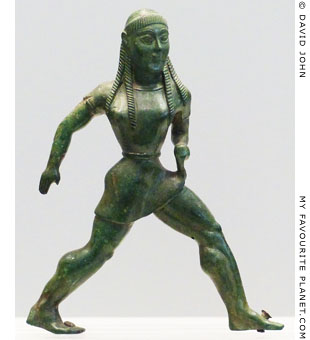
A bronze figurine of a running girl,
thought to be a Spartan female
athlete taking part in the maiden's
races (Heraia) held at Olympia.
From the decoration of a krater (mixing
vase) or cauldron. Made in a Laconian
workshop, 550-540 BC.
Found in 1875 in the Sanctuary of Zeus
at Dodona, northwestern Greece, during
excavations by Konstantinos Karapanos
(see note in Homer part 3).
National Archaeological Museum,
Athens. Inv. No. Καρ. 24. From the
Konstantinos Karapanos Collection. |
|
| |
Herodes
Atticus |
The estates of Herodes and Annia Regilla at Marathon |
|
 |
|
| |

Remains of the monumental arched "Gateway of Immortal Harmony" from the
estates of Herodes Atticus and Annia Regilla at Marathon, East Attica, Greece.
The keystone of an arch between two marble statues of enthroned figures:
left, Annia Regilla (Inv. No. 159); right Herodes Atticus (Inv. No. 158).
Mid 2nd century AD.
Marathon Archaeological Museum. |
| |
Herodes Atticus owned extensive areas of land at several locations around Greece, including Astros in Arcadia, Kifissia, and particularly at his ancestoral deme of Marthon, East Attica. The remains of his country estate are around 3 kilometres west of Marathon, just south of Oinoe, the location of the ancient Cave of Pan. He gave part of this property to his wife Annia Regilla, an area containing various buildings and other structures enclosed by a 3,300 metre long perimeter wall of rubble masonry, known today as Mandra tis Grias (Μάντρα της Γριάς), the Old Woman's Sheepfold. After her death this probably became his residence in the area.
The entrance to the estate was a monumental arched gateway, with inscriptions on both sides of the arch. Although several parts and fragments of the gateway have been found, only the three pieces shown above are currently exhibited in the Marathon Museum.
One side of the archway's keystone was inscribed:
Ὁμονοίας ἀθανάτ[ου].
πύλη.
Ἡρώδου ὁ χῶρος
εἰς ὃν εἰσέρχε[ι].
Gateway of Immortal Harmony. The place you enter belongs to Herodes.
Inscription IG II² 5189 (also C.I.G. 537).
The insciption on the other side was identical, except for the name of the owner:
Ὁμονοίας ἀθανάτου.
πύλη.
Ῥηγίλλης ὁ χῶρος
εἰς ὃν εἰσέρχει.
Gateway of Immortal Harmony. The place you enter belongs to Regilla. (see photo below)
Inscription IG II² 5189a.
In front of each of the pillars supporting the arch and acting as jambs for the gate was a statue of an enthroned figure (there is said to have originally been three statues). Though now badly worn and damaged, the two are thought to have been portraits of Herodes and Annia Regilla (Inv. Nos. 158 and 159 respectively) On the right hand pillar, above the statue, is an epigram of three couplets, the first referring to the couple:
"O happy is he who built a new city, naming it after Regilla; his life is full of joy."
The other two couplets beneath this are thought to have been inscribed later, as Herodes' reply to the early euphoria, following the death of his wife and most of his children:
"My life is full of sorrow as I contemplate my existence without my beloved wife, and my house that has remained without heir.
Truly, when the gods mix the mortal cup of life they put in joys and sorrows mingled."
See: Daniel J. Geagan, Mitteilungen des Deutschen Archäologischen Instituts, Athenische Abteilung, Band 79, 1964, pages 149-156. S.E.G., XXIII, No. 121.
The English traveller Doctor Richard Chandler (1738-1810) wrote the first modern report concerning the gateway and an explanation of the name "the Old Woman's Sheepfold". He visited Marathon in May 1776, accompanied by some local people, who told him of the local folktale which had grown around the ruined gate and the single statue then still visible. He noted the tale, but later regretted not having inspected the ruins more closely.
"In the vale, which we entered, near the vestiges of a small building, probably a sepulchre. was a headless statue of a woman sedent, lying on the ground. This, my companions informed me, was once endued with life, being an aged lady possessed of a numerous flock, which was folded near that spot. Her riches were great, and her prosperity was uninterrupted. She was elated by her good fortune. The winter was gone by, and even the rude month of March had spared her sheep and goats. She now defied Heaven, as unapprehensive for the future, and as secure from all mishap. But Providence, to correct her impiety and ingratitude, commanded a fierce and penetrating frost to be its avenging minister; and she, her fold, and flocks were hardened into stone. This story, which is current, was also related to me at Athens. ... I regretted afterwards my inattention to it on the spot; for I was assured that the rocky crags afford at a certain point of view the similitude of sheep and goats within an enclosure or fold."
Richard Chandler, Travels in Greece, or an account of a tour made at the expense of the Society of Dilettanti, chapter 36, pages 166-167. Clarendon Press, Oxford, 1776. At the Internet Archive.
It has been suggested that the local name of the walled area may be much older than the folktale, since the Greek word mandra can mean any enclosed space, not necessarily connected with livestock. The idea of "the rocky crags" resembling sheep and goats in the mind's eye of local people is widespread throughout history. Compare this, for example, with Pausanias' description of the nearby Cave of Pan, or even Osbert Lancaster's reaction to the rocks of Meteora.
In 1892 Louis-François-Sebastien Fauvel (1753-1838), the French painter, diplomat and archaeologist who was very active digging up and taking away ancient artefacts in the area of Marathon over a number of years, recorded the inscription on the arch referring to Herodes Atticus, so that at the latest by then it was evident that the fallen stones were the remains of a gateway. Over the next two centuries the remains were visited and inspected by a number of scholars, and one, Philippe Le Bas even brought with him an artist with whom he attempted to restore the original appearance of the gate in 1843-1844 (see image, right). However, remarkably it was not until 1926 that the Greek archaeologist George Sotiriadis came along and turned the keystone over to find the inscription on the other side. The pillar with the epigram was found by Daniel J. Geagan during excavation work in 1964, when Alfred Mallwitz reexamined the remains and made a new restoration of the portal.
See: George Sotiriadis, The New Discoveries at Marathon. In: The Classical Weekly, Volume 20, No. 11 (January 10, 1927), pages 83-84. At jstor.org.
As has often been pointed out, the inscriptions on the gateway's arch appear to be in imitation of those on Hadrian's Gate (also known as Hadrian's Arch) in Athens, built by the Athenians in honour of Emperor Hadrian, probably in 131/132 AD. He built the Olympieion (Temple of Olympian Zeus) and a new quarter of Athens, beyond the ancient confines of the city around the Acropolis. His new quarter spread over an area between the southeast of the Acropolis and the Ilissos River, on the other side of which, around a decade later, Herodes Atticus built the new Panathenaic Stadium. The gate, built of Pentelic marble in the form of a Roman triumphal arch of the Corinthian order, 18 metres high and 13.5 metres wide, marked the boundary between the old and the new parts of the city. Inscriptions placed above the arch on either side of the gatweway made it clear in which part of town readers found themselves.
On the northwest side, facing the Acropolis and the old town, was inscribed:
αἵδ’ εἴσ’ Ἀθῆναι Θησέως ἡ πρὶν πόλις.
This is the Athens of Theseus, the old city.
On the southeast side of the gate, facing Hadrian's new quarter:
αἵδ’ εἴσ’ Ἁδριανοῦ καὶ οὐχὶ Θησέως πόλις.
This is the city of Hadrian and not of Theseus.
Inscription IG II² 5185.
Many Athenians will have been aware of the legendary or mythical pillar set up on the Isthmus at Corinth, mentioned by Strabo (circa 64-24 AD) and Plutarch (circa 46-120 AD), similarly marking the border between the Ionian Greek mainland of central Greece and the peninsula of the Peloponnese.
"Besides, the Peloponnesians and Ionians having had frequent disputes respecting their boundaries, on which Crommyonia also was situated, assembled and agreed upon a spot of the Isthmus itself, on which they erected a pillar having an inscription on the part towards Peloponnesus:
'This is Peloponnesus, not Ionia';
And on the side towards Megara:
'This is not Peloponnesus, but Ionia'."
Strabo, Geography, Book 9, chapter 1, section 6. At Perseus Digital Library.
The repective inscriptions in Greek:
On the Peloponnesian (west) side of the pillar: "τάδ᾽ ἐστὶ Πελοπόννησος οὐκ Ἰωνία."
On the Ionian (east) side of the pillar: "τάδ᾽ οὐχὶ Πελοπόννησος ἀλλ᾽ Ἰωνία."
He repeated the anecdote in Geography, Book 3, chapter 5, section 5. At Perseus Digital Library.
In Plutarch's version of the story, it was the legendary king of Athens and Minotaur-slayer, Theseus himself who set up the boundary pillar:
"Having attached the territory of Megara securely to Attica, he set up that famous pillar on the Isthmus, and carved upon it the inscription giving the territorial boundaries. It consisted of two trimeters, of which the one towards the east declared:
'Here is not Peloponnesus, but Ionia';
and the one towards the west:
'Here is the Peloponnesus, not Ionia'."
Plutarch, The Parallel Lives, Theseus, chapter 25, section 3. At Bill Thayer's LacusCurtius website, University of Chicago.
In the case of the Mandra tis Grias gateway, it is not known which inscription faced the outside of the enclosure and which the inside, and apparently there is no physical or technical evidence to indicate the solution. It has been argued, citing the examples of Hadrian's Gate and the Isthmus pillar as evidence of "ancient practice", that the Regilla text must have been on her side of the gate, that is inside the enclosure, and the Herodes text on his side. However, neither of the texts state "This belongs to..." Regilla or Herodes; both inform the reader that they are entering the property of the respective owner, which suggests that the Regilla text must have been on the outside, and that of Herodes on the inside.
See: Eugene Vanderpool, Some Attic inscriptions: Regilla's estate at Marathon. In: Hesperia 39, 1970, pages 43-45, plate 14a. |
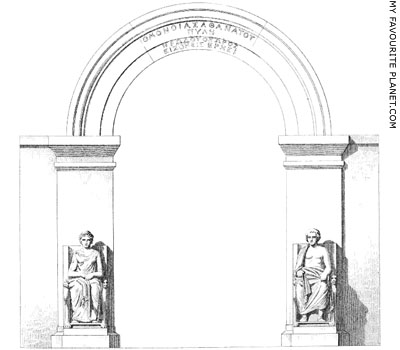
An early reconstruction drawing of the "Gateway of
Immortal Harmony", Marathon by Philippe Le Bas.
Salomon Reinach, Voyage archelologique en Grece et
en Asie Mineure sous la direction de M. Philippe Le Bas
(1842-1844), plate 90. Paris, 1888. |
| |
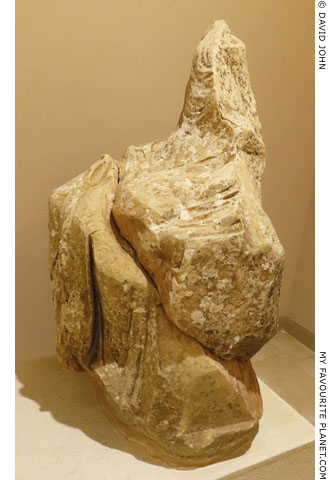
The reassembled fragments of the statue
of Annia Regilla from the "Gateway of
Immortal Harmony" near Marathon.
Marathon Archaeological Museum. Inv. No. 159. |
| |
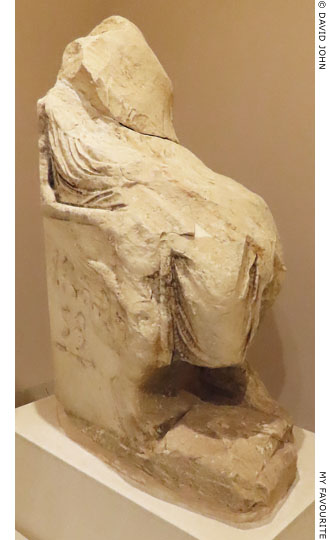
The reassembled fragments of the statue
of Herodes Atticus from the "Gateway of
Immortal Harmony" near Marathon.
Marathon Archaeological Museum. Inv. No. 158. |
| |
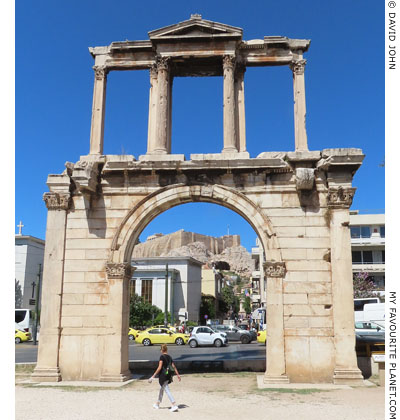
The southeast side of Hadrian's Gate, Athens,
built around 131/132 AD. The southeast corner
of the Acropolis can be seen through the arch.
The inscription "This is the city of Hadrian and
not of Theseus", still visible on the architrave,
is difficult to read, as much of it is blackened
by age and environmental pollution. |
| |
| |

Fragments of the keystone from the arched gateway to the Marathon
estate Herodes Atticus and Annia Regilla. On this side is the inscription:
Ὁμονοίας ἀθανάτου.
πύλη.
Ῥηγίλλης ὁ χῶρος
εἰς ὃν εἰσέρχει.
"Gateway of Immortal Harmony. The place you enter belongs to Regilla." |
| |
Herodes
Atticus |
The Sanctuary of the Egyptian Gods at Brexiza |
|
 |
|
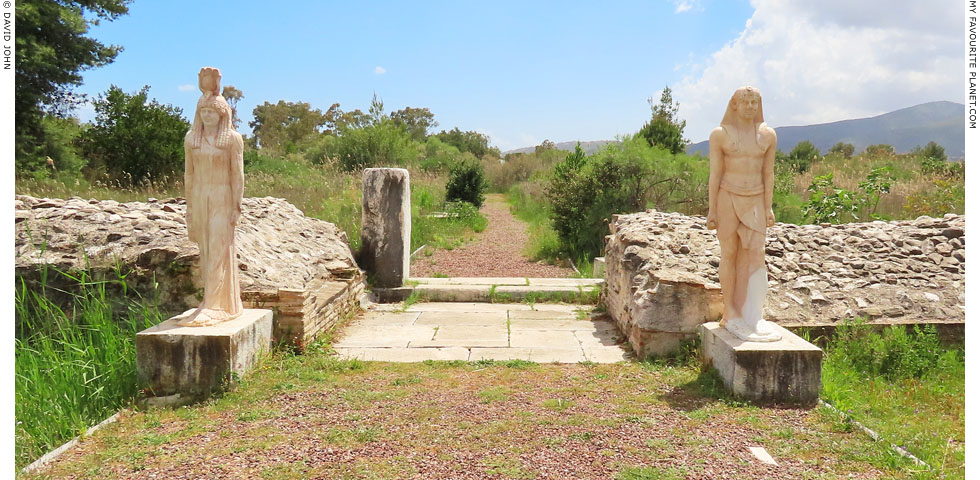
Copies of statues set up in the archaeological site of the Sanctuary of the Egyptian Gods
at Brexiza (Αιγυπτιακό ιερό στην Μπρεξίζα), built by Herodes Atticus around 160 AD on a
man-made islet in the Mikro Elos (Μίκρο Ἐλος, Small Marsh), southeast of Marathon, Attica. |
| |

Some of the sculptures from the Sanctuary of the Egyptian Gods
at Brexiza now in the Marathon Archaeological Museum. |
| |
The plain of Marathon in northeast coast of the Attic peninsula, lies along the Bay of Marathon, opposite the island of Euboea. To the west, a range of low mountains, including Mount Pendeli (source of Pentelic marble) separates the plain from Athens and west Attica. The modern small town (or large village) of Marathon itself is a the north of the plain, a little inland. At the southern edge of the plain is the modern settlement of Nea Makri. In antiquity the area was a fertile and wealthy deme of Athens. Today it is a seaside resort popular with Athenians at weekends and vactions, and many have a holiday home there.
Around 2 kilometres north of Nea Makri, near the beach where the Battle of Marathon was fought between Greek and invading Persians in 490 BC, is the famous Soros (Σορός) or Tomb of the Athenians, the large funeral mound constructed for the 190 Athenian soldiers who died in the battle.
At Brexiza, just to the south of the Soros, was a marsh known as Mikro Elos (Μίκρο Ἐλος, Small Marsh), which was drained in the mid 20th century. The Egyptian sanctuary was built on an artificial island on this marshland by Herodes Atticus, probably around 160 AD. The building complex included a temple and adjoining courtyard, a large elliptical pool and a bath installation known as a balneum. It is the largest known Egyptian sanctuary in Greece.
Louis-François-Sébastien Fauvel (1753-1838), the French painter, diplomat and archaeologist, who conducted excavations around Marathon in the late 18th century (see above), was the first person in modern times to record the location of the sanctuary. He discovered the site by chance in 1789 when he visited the area in order to investigate the tombs from the Battle of Marathon. During his subsequent excavations of the ruins he found three portrait busts, which were sent to France. The busts of Herodes Atticus and Emperor Marcus Aurelius are now in the Louvre Museum, while a bust of Emperor Lucius Verus eventually ended up in the Ashmolean Museum, Oxford [see note 7].
More recently, small excavations were undertaken in 1926 and 1968. Systematic excavation of the sanctuary began in 2001 and continued for several years. It was during these latter digs that most of the artifacts now in the Marathon museum were found.
According to Philostratos and the inscriptions found during the recent excavations, the sanctuary was named Canopus (Κάνωπος, Kanopos, or Κάνωβος, Kanobos) [17], after the Egyptian island at the west of the Nile Delta, near Aboukir and 25 kilometres east of Alexandria. King Ptolemy III Euergetes is said to have founded the Sarapeion of Canopus, which became famous as a place of pilgrimage and healing centre. It is thus thought that the Brexiza sanctuary may also have been dedicated to Serapis. Emperor Hadrian also built a sanctuary of Canopus in the grounds of his villa at Tivoli near Rome (see Antinous), which Herodes Atticus may have been attempting to emulate. He had a drainage ditch dug around the sanctuary to create an artificial island, in imitation of the Egyptian original.
The Sanctuary was surrounded by an almost square peribolos (περίβολος, perimeter wall) within which was a temple with four entrances in the form of Egyptian pylons, one at each of the cardinal points of the compass. Each entranceway was flanked by a statue of Isis and one of Antinous as Osiris. Three of the Antinous statues have so far been found. The first was discovered in 1843 and is now in the National Archaeological Museum, Athens. The other two are in the Marathon Archaeological Museum (see photos, right and below). Three of the Isis statues have also been recovered (see below), one depicting her as Isis-Aphrodite and the other as Isis-Demeter. Of the third only a fragment, the feet and legs below the knees, has survived.
All the surviving statues from the entrances are made of Pentelic marble and are joined at the back to one the pillars that framed the entrance. The backs of the statues were evidently not meant to be seen as they are more roughly finished. They are all depicted in the same hieratic pose, characteristic of ancient Egyptian statues: they stand stiffly erect with their hands at their sides, with the left leg placed forewards, as if they are stepping towards the viewer.
A third statue of Isis, also in a hieratic pose, but sculpted in more detail (see below) was found in a room of the sanctuary dubbed by archaeologists "the Room of the Lamps" after the around 70 large ritual lamps found there. A marble sphinx was also discovered here (see below). It is thought that the artifacts were brought here from their original places for protection.
To the east of the temple was a rectangular courtyard with a stoa (colonnade) running around three of its four sides. |
|
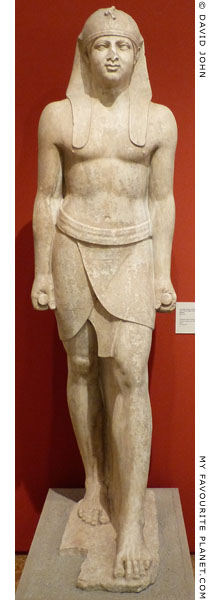
Larger than lifesize marble
statue of Antinous as the
Egyptian god Osiris, from
one of the entrances to the
temple in the Sanctuary of
the Egyptian Gods, Brexiza.
Marble, 2nd century AD.
Found in 1843 at Marathon.
National Archaeological
Museum, Athens. Egyptian
Collection. Inv. No. 1. |
|
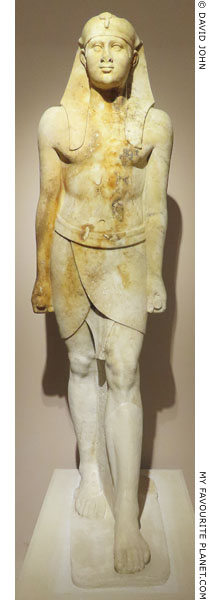
Larger than lifesize marble
statue of Antinous-Osiris,
from the west porch of the
Egyptian temple, Brexiza.
2nd century AD. Found in
1968. Height 240 cm.
Marathon Archaeological
Museum. Inv. No. 1. |
|
| |
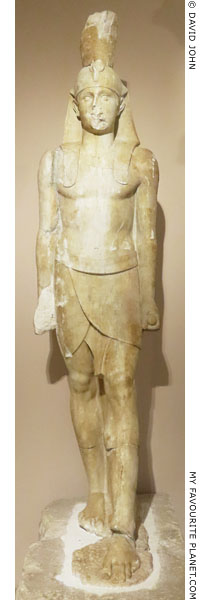
Larger than lifesize marble
statue of Antinous-Osiris
from the north porch of
the Egyptian sanctuary,
Brexiza. The figure wears
the double crown of Upper
and Lower Egypt in the
form of a tall polos.
2nd century AD.
Marathon Archaeological
Museum. |
|
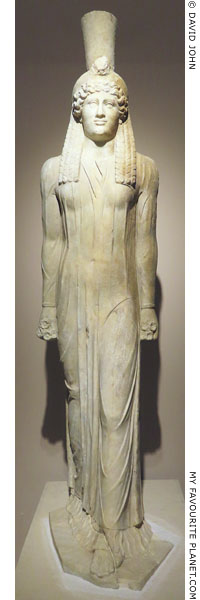
A larger than lifesize marble
statue of Isis-Aphrodite
from the west porch. In
each hand she holds three
dog roses, considered the
flower of Aphrodite. Like
the Antinous-Osiris statue
from the north porch
(photo, left) she wears
a tall polos.
2nd century AD. Pentelic
marble. Height 239 cm. Marathon Archaeological
Museum. |
|
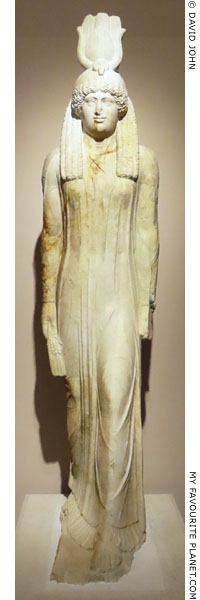
Larger than lifesize marble
statue of Isis-Demeter from
the south porch. She wears
a basileion, a solar disk with
three feathers between the
horns, and above the fore-
head it is decorated with a
uraeus with a twisted tail.
She holds ears of wheat in
her right hand, but most of
the left hand is now missing.
2nd century AD. Pentelic
marble. Height 231 cm.
Marathon Archaeological Museum. |
|
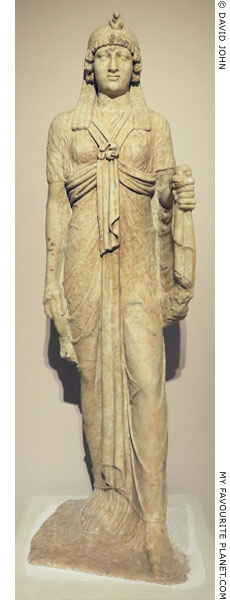
Larger than lifesize marble
statue of Isis, found in the
"room of the lamps".
This statue is sculpted in
greater detail and is dressed
quite differently. Her headwear
includes a uraeus with a twisted
tail, though part of the head is
now missing. She wears a long
chiton with short sleeves, over
which is a fringed himation,
tied between her breasts with
the Isiac knot. With her left
hand she holds out the end of
the himation in a way unknown
from any other statue of Isis.
In her lowered right hand she
holds a folded ribbon, the ends
of which fall to either side of her
hand. Such ribbons, symbols of
strength and eternal life, are
usually held by male figures.
2nd century AD. Pentelic
marble. Height 183 cm.
Marathon Archaeological
Museum. |
|
| |
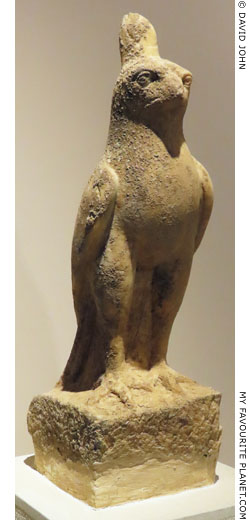
Larger than lifesize marble statue
of Horus as a falcon wearing the
crown of Upper Egypt. From the
Sanctuary of the Egyptian Gods.
2nd century AD.
Marathon Archaeological Museum. |
|
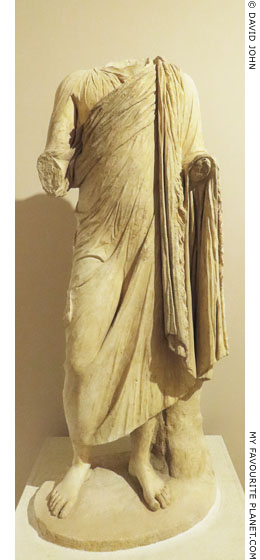
Headless marble statue of a young
man, probably an orator, wearing
a himation (woollen mantle) over a
chiton (tunic). From the Sanctuary
of the Egyptian Gods.
2nd century AD.
Marathon Archaeological Museum. |
|
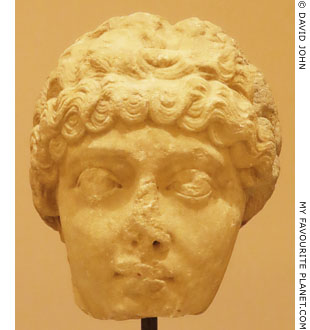
Marble head of Empress Faustina the
Younger, wife of Emperor Marcus Aurelius.
Found in the vicinity of the Tumulus of the
Athenians, but thought to have originally
been set up by Herodes Atticus in the
Egyptian sanctuary.
2nd century AD.
Marathon Archaeological Museum.
Inv. No. 16. |
|
| |
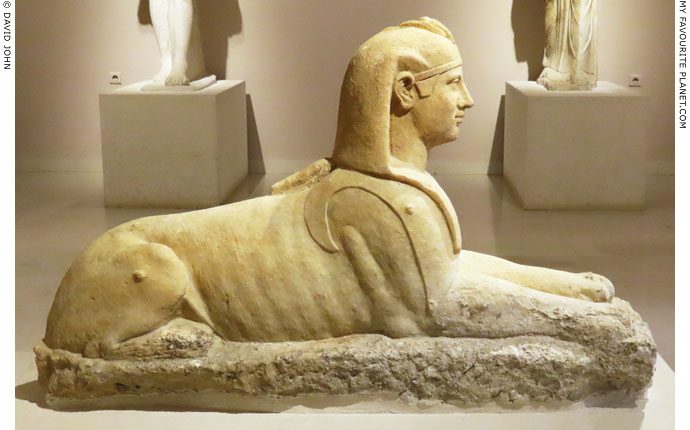 |
|
 |
A marble statue of a Sphinx found in the "Room of the Lamps"
in the Sanctuary of the Egyptian Gods at Brexiza.
Marathon Archaeological Museum. |
|
| |
Herodes
Atticus |
Polydeukes |
|
 |
|
| |
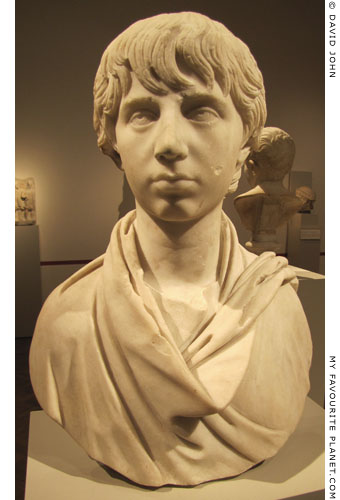
Marble bust of Polydeukes.
Mid 2nd century AD. Purchased in Athens
in 1844, probably by Ludwig Ross.
Height 54.5 cm, width 40 cm, depth 24 cm.
Altes Museum, Berlin. Inv. No. Sk 413. |
|
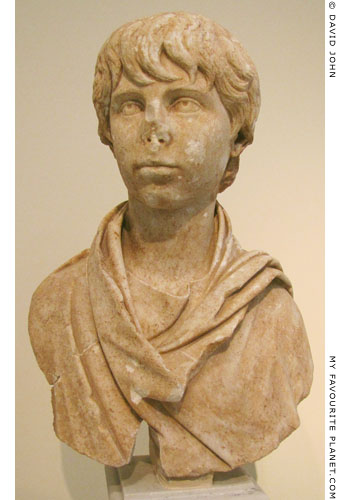
Bust of Polydeukes from Herodes Atticus'
villa in Kifissia (Κηφισιά), Attica.
Mid 2nd century AD. Found in Rangavi Street,
Kifissia in February 1961, together with the
bust of Herodus Atticus at the top of the page.
Parian marble. Height 56 cm.
National Archaeological Museum,
Athens. Inv. No. 4811. |
|
| |
There are twelve portraits of Polydeukes in various Athens museums, including two portrait heads found on the South Slope of the Athens Acropolis:
Acropolis Museum. Inv. No. 2377.
National Archaeological Museum, Athens. Inv. No. 3468. Height 28.8 cm.
They are not in such a good condition as those above, and are not usually on display.
This foster son of Herodes Atticus is named in inscriptions as Vibullius Polydeukion (Βιβούλλιος Πολυδευκίων), but Philostratus and Lucian [18] refer to him as Polydeukes (Πολυδεύκης, much sweet wine), perhaps a diminutive or nickname and an allusion to Polydeukes (Latin, Pollux), one of the Dioskouroi. Some scholars believe that the nomen Vibullius indicates that he may have been a blood relative of Herodes. There are around thirty four known ancient portraits of the youth who was first recognized as Polydeukes by the German archaeologist Karl Anton Neugebauer in 1931, when only eight ancient examples were known [19].
The statues and monuments for Polydeukes and those of Herodes Atticus' two other adopted sons Memnon and Achilles are thought to have been set up after they died at a young age. It is not known when each of them died, how old they were, or even when Herodes adopted them, although various dates have been suggested [see note 8]. Some museum labelling and literature date the portraits of Polydeukes to around 140-150 AD, but this is probably far too early.
Philostratus reported on Herodes Atticus' grief on the death of two of his daughters, Athenais (he calls her Panathenais, Παναθηναίδι) and Elpinice (Elpinike), on his relationship with his son Atticus (Atticus Bradua) and the statues he set up of his three adopted sons.
"Thus, then, his grief for Regilla was quenched, while his grief for his daughter Panathenais was mitigated by the Athenians, who buried her in the city, and decreed that the day on which she died should be taken out of the year. But when his other daughter, whom he called Elpinice, died also, he lay on the floor, beating the earth and crying aloud: 'O my daughter, what offerings shall I consecrate to thee? What shall I bury with thee?' Then Sextus the philosopher who chanced to be present said: 'No small gift will you give your daughter if you control your grief for her.'
He mourned his daughters with this excessive grief because he was offended with his son Atticus. He had been misrepresented to him as foolish, bad at his letters, and of a dull memory. At any rate, when he could not master his alphabet, the idea occurred to Herodes to bring up with him twenty four boys of the same age named after the letters of the alphabet, so that he would be obliged to learn his letters at the same time as the names of the boys. He saw too that he was a drunkard and given to senseless amours, and hence in his lifetime he used to utter a prophecy over his own house, adapting a famous verse as follows:
'One fool methinks is still left in the wide house.' *
And when he died he handed over to him his mother's estate, but transferred his own patrimony to other heirs. The Athenians, however, thought this inhuman, and they did not take into consideration his foster sons Achilles, Polydeuces and Memnon, and that he mourned them as though they had been his own children, since they were highly honourable youths, noble-minded and fond of study, a credit to their upbringing in his house.
Accordingly he put up statues of them hunting, having hunted, and about to hunt, some in his shrubberies, others in the fields, others by springs or in the shade of plane trees, not hidden away, but inscribed with execrations on any one who should pull down or move them. Nor would he have exalted them thus, had he not known them to be worthy of his praises. And when the Quintilii during their proconsulship of Greece censured him for putting up the statues of these youths on the ground that they were an extravagance, he retorted: 'What business is it of yours if I amuse myself with my poor marbles?'"
* Paraphrase of Homer, The Odyssey, Book 4, line 498, with "house" substituted for "deep".
Philostratus, The lives of the Sophists, Book 2, sections 557-559 (pages 162-167,
see note 3). |
|
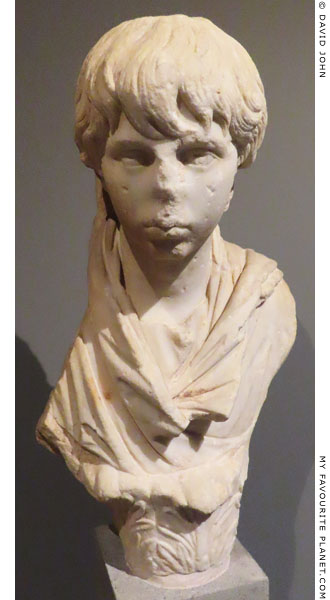
A marble high relief with a bust of Polydeukes
wearing a himation. The bust appears to have
grown from the cluster of acanthus leaves
which acts as a base. The broken flat back of
the relief suggests that it was part of a larger
monument, perhaps set in a wall.
Around 150 AD. From an unknown location
on the island of Euboea, central Greece.
New Archaeological Museum "Arethousa",
Chalkis. Inv. No. MX 2179.
Formerly in the Archaeological Museum of
Chalkis (now referred to as the "old museum"). |
|
| |
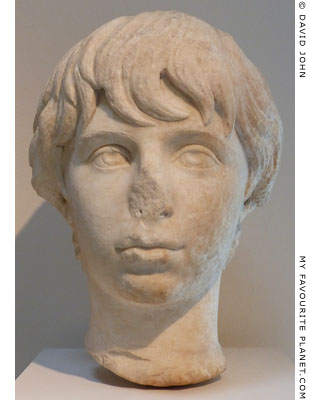
Lifesize marble portrait head of Polydeukes
from the Roman baths at Isthmia.
Mid 2nd century AD.
Isthmia Archaeological Museum.
Inv. No. IS 78-12.
Found in spring 1978 during excavations
directed by American archaeologist
P. A. Clement. One of two heads of
Polydeukes (the other Inv. No. IS 437,
not on display) found in the area of the
2nd century AD bath complex at Isthmia
(Ισθμία), 16 km east of Ancient Corinth.
It has been suggested that the baths,
which included a large mosaic floor with
depictions of Poseidon (the patron deity
of Isthmia) and Amphitrite, may have
been built by Herodes Atticus as
a dedication to Polydeukes.
Pausanias and Philostratus [see note 3]
mentioned that Herodes donated statues
to the Temple of Poseidon at Isthmia. [20] |
|
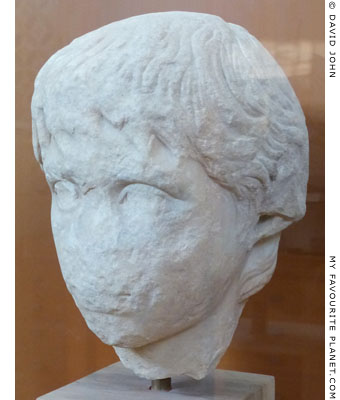
Marble portrait head of Polydeukes
from Corinth.
Mid 2nd century AD. Found 6 April 1964 at
Alonia Ayiannotika, east of the ampitheatre,
1.2 km northeast of Ancient Corinth. Perhaps
from the area of the Kraneion (see above).
It was stolen along with a large number of
antiquities during a violent burglary of the
museum on 12 April 1990. It was recovered
by police and returned to the museum on 25
January 2001. Height 28 cm, height of head
24 cm, width 22 cm, depth 21.5 cm.
Corinth Archaeological Museum.
Inv. No. S 2734.
Herodes Atticus financed monumental
building projects at Corinth, including the
renovation of the Odeion and perhaps
the Peirene Fountain (see below). |
|

Marble portrait head of Polydeukes
from Marathon, Attica, Greece.
2nd century AD.
Found in 1955, along with a head
of Herodes Atticus (see above),
at Marathon, near the tumulus for
the 192 Athenians who died during
the Battle of Marathon in 490 BC.
Marathon Archaeological Museum.
Inv. No. BE 12.
Formerly in the National Archaeological
Museum, Athens, Inv. No. 934. |
|
| |
 |
|
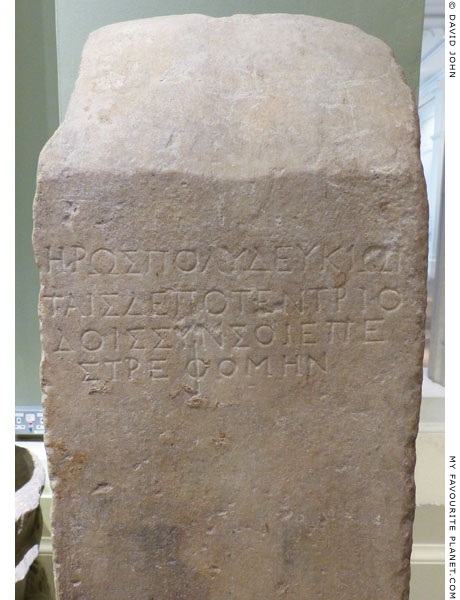 |
A headless herm with an inscription dedicated to the
"hero Polydeukion", probably by Herodes Atticus.
Mid 2nd century AD. Found in the ruins of a chapel in Kifissia, northeast of Athens,
where Herodes Atticus had a villa (see above). Pentelic marble. Height 155 cm.
Ashmolean Museum, Oxford. Inv. No. ANMichaelis 177.
Donated in 1759 by R. M. Dawkins.
|
|
The Greek inscription on the chest of the herm shaft:
Ἥρως Πολυδευκίων
ταῖσδέ ποτ’ ἐν τριό-
δοις σύν σοι ἐπε-
στρεφόμην
Hero Polydeukion, once I walked here with you at this crossroads.
Inscription IG II² 13194.
The longer inscription at the bottom of the herm shaft includes a curse text: the threat of a curse on vandals and thieves, as with the statues "inscribed with execrations on any one who should pull down or move them" mentioned by Philostratus (see above), and the columns from the Triopion in Rome (see above).
For the Greek text of the longer inscription, see:
IG II² 13194 at The Packard Humanities Institute.
The English traveller Richard Chandler (1737-1810), who visited Kifissia on 5th May 1766 on his way from Athens to Marathon (see above), reported on the herm and Herodus Atticus' habit of placing protective inscriptions on memorial sculptures:
"We soon arrived at Cephisia, a village situated on an eminence by a stream near the western extremity of mount Pentele. It was once noted for plenty of clear water and for pleasant shade suited to mitigate the heat of summer. It has a mosque [the old Agia Paraskevi church, see above], and is still frequented, chiefly by Turks of Athens, who retire at that season to their houses in the country. The famous comic poet Menander was of this place.
Atticus Herodes, after his enemies accused him to the emperor Marcus Aurelius as guilty of oppression, resided here and at Marathon; the youth in general following him for the benefit of his instruction. Among his pupils was Pausanias of Caesarea, the author, it has been affirmed, of the description of Greece. *
Atticus Herodes had three favourites, whose loss he lamented, as if they had been his children. He placed statues of them in the dress of hunters, in the fields and woods, by the fountains, and beneath the plane-trees; adding execrations, if any person should ever presume to mutilate or remove them.
One of the hermae or Mercuries was found in a ruinous church at Cephisia, and is among the marbles given by Mr. Dawkins to the university of Oxford. This represented Pollux, but the head is wanting. It is inscribed with an affectionate address to him; after which the possessor of the spot is required, as he respects the gods and heroes, to protect from violation and to preserve clean and entire, the images and their bases; and if he failed, severe vengeance is imprecated on him, that the earth might prove barren to him, the sea not navigable, and that perdition might overtake both him and his offspring; but if he complied, that every blessing might await him and his posterity. Another stone with a like formulary, was seen there by Mr. Wood; and a third near Marathon."
Richard Chandler, Travels in Greece, chapter 34, page 160. Clarendon Press, Oxford, 1776. At the Internet Archive.
* "Pausanias of Caesarea" is a reference to the travel writer Pausanias.
Other inscribed herm shafts with dedications to Polydeukes, Memnon and Achilles have been found, usually in rural locations and mentioning hunting or deities associated with hunting and rural occupations, such as Artemis (the huntress) and Hermes as "the protector of shepherds". The inscription on another herm of Polydeukes found at the village of Kato Souli (Κάτω Σούλι), 7 km east of Marathon, states that it was set up by Herodes where he used to hunt with the youth. A longer inscription below this dedication threatens a curse on anyone who disturbs the memorial.
Πολυδευ-
κίωνα, ὃν ἀν-
θ’ υ[ἱ]οῦ ἔστε-
<ρξ>εν καὶ ἐνθά-
δε Ἡρώδης <ἀν>-
έθηκεν ὅτι ἐν-
θάδε καὶ περὶ
θήραν εἶχον. |
|
Here too Herodes dedicated
Polydeukion, whom he loved
as a son, because here too
they hunted together. |
Inscription IG II² 3970 (dedication to Polydeukes) at The Packard Humanities Institute.
Below the dedication is a longer interdictory curse.
π]ρὸς θεῶ[ν καὶ ἡρώω]ν ὅ[στις]
[εἶ ὁ ἔ]χων [τὸν χῶρον], μήπο[τε μετ]-
ακεινήσ[ῃς τούτω]ν τ[ι· καὶ τὰς τ]-
ούτω[ν τῶν ἀγαλμάτων εἰκόν]-
ας κα[ὶ τειμὰς ὅστις ἢ καθέλοι ἢ]
μετακεινοίη, [τούτῳ μήτε γῆν κ]-
αρπὸν [φέρειν μήτε θάλασσαν πλ]-
[ω]τὴ[ν εἶναι, κακῶς τε ἀπολέ]-
σθαι αὐτο[ὺς κ]α[ὶ γένος. ὅστις δὲ]
κατὰ χώ[ραν φυλάττοι καὶ τειμῶν]
[τ]ὰ εἰωθό[τ]α [καὶ αὔξων διαμέ]-
[ν]οι, πολ[λὰ καὶ ἀγαθὰ εἶναι τ]-
[ούτ]ῳ κα[ὶ] αὐ[τῷ καὶ ἐκγόνοι]-
[ς]· λ[υμήν]ασ[θαι δὲ μηδὲ λωβή]-
[σα]σ[θαι μηδὲν ἢ ἀποκροῦσαι]
ἢ συν[θραῦσαι ἢ συνχέ]αι [τ]ῆ-
[ς] μορφῆ[ς] κ[αὶ τοῦ σχή]ματος· [εἰ]
[δέ] τις [οὕ]τ[ω] ποιήσει, ἡ αὐτὴ
[κα]ὶ ἐπὶ τού[τ]οις ἀρά. ἀλλ ἐ-
[ᾶ]ν τά τε [ἐπιθέματα τῶν]
μορφ[ῶν ἀσινῆ καὶ ἀκέραια]
[κ]αὶ [τὰ] ὑποστήματ[α, τὰς βάσ]-
εις, ὡς ἐπ[οιήθησαν]. [κ]αὶ ἐπὶ πρώτῳ γε καὶ ἐπὶ π[ρώ]-
[τ]οις ὅστις ἢ προστάξειεν
ἑτέρ[ῳ ἢ] γνώ[μης ἄρ]ξειεν [ἢ]
γνώμη[ι] συμ[βάλ]οιτο π[ερ]-
[ὶ] τοῦ τούτων [τι ἢ κειν]ηθῆν-
αι ἢ συνχυθῆναι. |
|
In the name of the gods and heroes;
whoever you may be master of the
place, never move any of these here; and whoever takes down or moves
these portraits and ornaments, may
his earth bear no fruit, nor his sea
be navigable and may he and his
line be destroyed in a terrible way.
But whoever leaves them in their
place and cares for them and
maintains them as appropriate,
may he and his descendants see
many good things |
Inscription IG II² 13190 (also SEG 21:1092) at The Packard Humanities Institute.
Two headless herms of Achilles have been found at Oinoe and Varnavas in the area of Marathon. The Oinoe herm bears the inscription Ἀχιλλεύς (Achilleus) and a 29-line imprecation (curse) by Herodes Atticus (inscription IG II² 13195). In the inscription on the herm from Varnavas, Herodes expressed his friendship with Achilles:
Ἡρώδης Ἀχιλλεῖ·
ὃς βλέπειν σε ἔχοιμι
καὶ ἐν τούτῳ τῷ
νάπει· αὐτός τε
καὶ εἴ τις γ’ ἕτερος,
κἀκεῖνοί [γ’, ἔ]σῃ με-
μνημένο[ς τῆ]ς ἡ-
μετέρας φιλίας ὅ-
ση ἡμεῖν ἐγένετο·
ἱερὸν δέ σε Ἑρμοῦ ἐ-
φόρου καὶ νομίου
ποιοῦμαι. |
|
Herodes to Achilles,
in order to see you
I put you in this wood.
I myself and anyone else,
and all will remember
how great was our friendship.
I make you a dedication to
Hermes, the overseer and pastor. |
Inscription IG II² 3977.
See also an inscribed herm bust of Memnon from Marathon below. |
|
| |
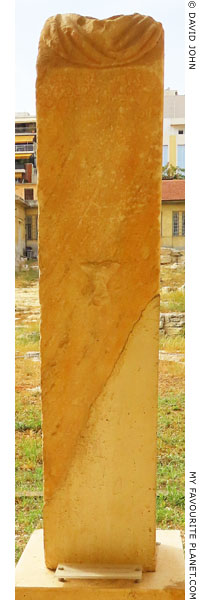 |
|
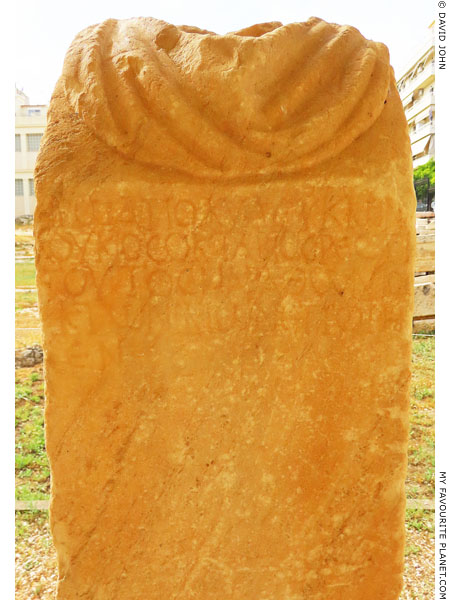 |
A headless herm (it really is quite orange) inscribed
with a dedication to "hero Polydeukion", sculpted at
the expense of Lucius Octavius Restitutus of Marathon.
ἥρωα Πολυδευκίωνα
Λούκιος Ὀκτάβιος Ῥεστι-
τοῦτος Μαραθώνιος
ἐκ τῶν ἰδίων ἐποίη-
σεν.
Inscription IG II² 3974.
Mid 2nd century AD. From Kifissia.
Piraeus Archaeological Museum. Inv. No. 10208. |
|
| |
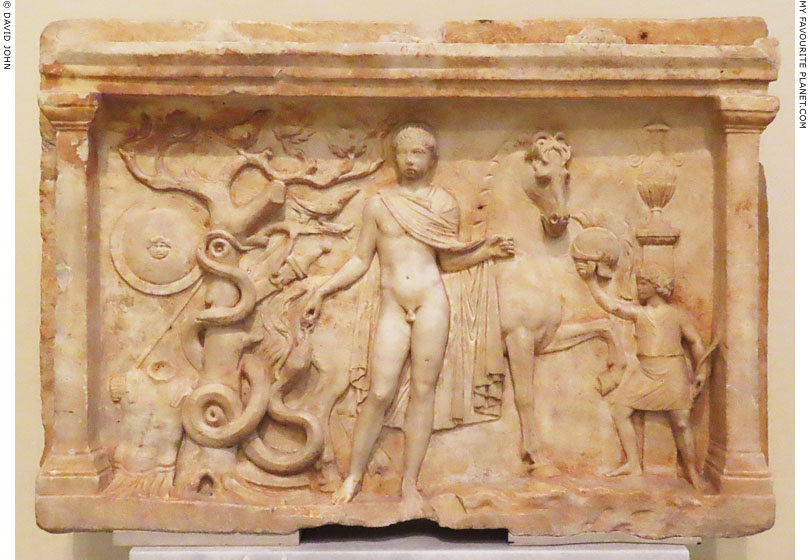
Marble hero relief in the form of a naiskos (ναΐσκος, small temple), depicting a naked youth,
identified as the heroized Polydeukes, adopted son of Herodes Atticus (see above).
After the middle of the 2nd century AD. Found near the Monastery of Loukou (Λουκού),
4 km northwest of Astros, Arkadia (see below), near the site of the Villa of Herodes
Atticus (see below). Pentelic marble. Height 68 cm, width 97 cm, depth 12-16 cm.
National Archaeological Museum, Athens. Inv. No. 1450.
|
Typical of such hero reliefs, the deceased is shown with a horse. He stands facing forwards, wearing only a chlamys (riding cloak). To the left is a tree, with two birds perched on branches, and a snake, which appears to be feeding from the youth's right hand, entwined around the trunk. Around the tree are a cuirass, greaves (under the snake), a sword, a spear and a round shield with a Gorgoneion (see Medusa) at its centre. On the right is a slave, depicted at a smaller scale, holding out a crested Attic helmet in his raised right hand. Behind him a loutrophos (a tall vase) with a conical lid stands on a pedestal. Loutrophoi were often used in Greece as grave markers, particularly for unmarried men.
The heroically nude figure with a horse has been compared to depictions of the Dioskouroi, and it has been suggested that Polydeukes may have had family connections with Sparta and even claimed descent from the divine twins (Ellen E. Perry, 2001, pages 269-470, see above).
It has also been argued that the relief may depict Achilles (Ἀχιλλεύς, Achilleus), another of Herodes Atticus' three adopted sons, rather than Polydeukes. Two of the main arguments appear to be that only Achilles was mentioned as being heroized, and that the figure on the relief does not resemble other depictions of Polydeukes. However, as can be seen from the inscribed herm above, Polydeukes was certainly referred to as a "hero". The facial features and hairstyle of the main figure on the relief are very similar to those on several extant heads and busts identified as portraits of Polydeukes, although on this relief he appears younger. No known sculpture yet found has been definitely identified as a portrait of Achilles, making comparison impossible. [21]
Herodes Atticus' villa at Loukou (ancient Eua, Εύα) contained a large art collection. Over 100 sculptures, several inscriptions, mosaics and other works from the villa are now in the nearby Archaeological Museum of Astros. Unfortunately, the museum has been closed for many years (see below).
Read more about hero reliefs:
Pergamon gallery 2, page 10 and Pella gallery page 17. |
|
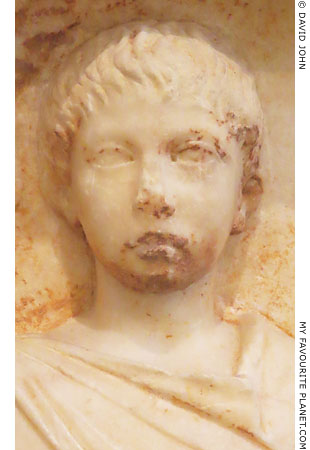
Detail of the main figure
on the relief from Loukou. |
|
| |
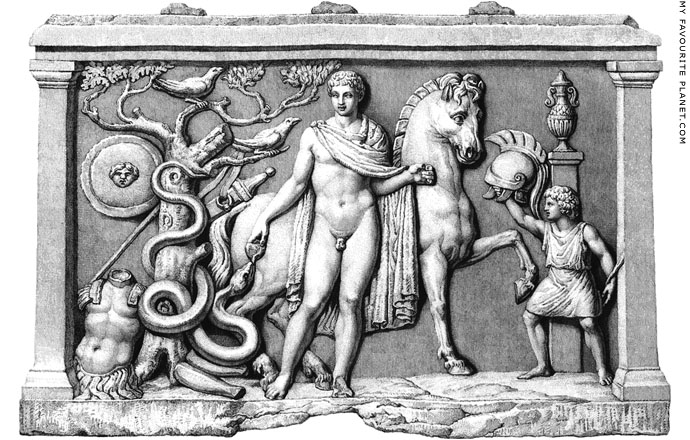
An engraving of the Polydeukes hero relief from Loukou (see photo above)
after a drawing by a member of the French Morea Expedition, 1829-1833.
|
The relief was found at the monastery in Loukou, and taken on 13th April 1831 to the museum on Aegina, where it remained for many years. It was first recorded and published by the French architect Guillaume Abel Blouet (1795-1853), head of the architecture and sculpture team of the Institut de France's Morea Expedition 1829-1833, in which antiquarians (including architects, a sculptor and a philologist), geologists and topographers accompanied a French military expedition to the Peloponnese and Attica during the Greek War of Independence (1821-1832).
Image source: Guillaume Abel Blouet, Expédition scientifique de Morée, ordonnée par le gouvernement français: Architecture, sculptures, inscriptions et vues du Péloponèse, des Cyclades et de l'Attique, Volume 3 (of 3), planche 91, text on pages 55-57. Firmin Didot, Paris, 1838. At the Internet Archive.
The members of the scientific expedition arrived by ship at Navarino (today Pylos, Πύλος), southwestern Peloponnese, on 3rd March 1829, following the defeat of Ottoman and Egyptian forces at the Battle of Navarino on 20 October 1827, and the landing of French troops there in August 1828. Blouet published his report on the expedition in three volumes 1831-1838.
See: Blouet, Expédition scientifique de Morée..., Volume 1, page 1. At the Internet Archive. |
|
| |
Herodes
Atticus |
Memnon |
|
 |
|
| |
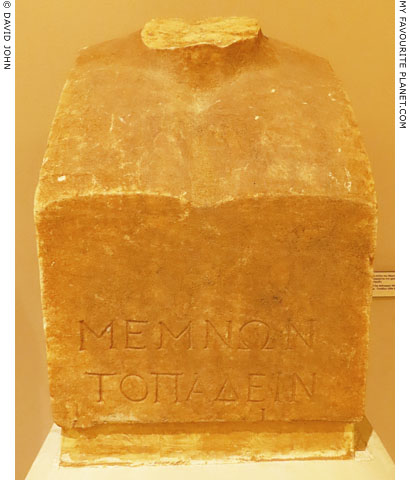
A now headless herm bust of the Ethiopian Memnon, one of
Herodes’ favourite pupils. On the front is the inscription:
Μέμνων Τοπάδειν
Memnon Little Topaz
Inscription SEG 35:210.
Found near Skorpio Potami (Skorpios River), Marathon.
Marathon Archaeological Museum. Inv. No. Λ 214.
|
According to Philostratus Memnon was an Ethiopian, meaning from the area of Africa to the south of Egypt. [22]
"Memnon, pupil of Herodes the sophist, was from Ethiopia."
Philostratus, The Life of Apollonius of Tyana, III, 11.
The word Τοπάδειν (Topadein) means little topaz, after the semi-precious stone, and is thought to have been a nickname or pet name for Memnon, perhaps an allusion to his skin colour. A hand of black marble found in Kifissia, along with busts of Herodes Atticus and Polydeukes (see top of page), is thought to be from a statue of Memnon.
A headless herm stele of Memnon, found in the area of the church of the Panagia, Mesosporitissa church, near Marathon, also refers to him as Topadein, and calls him friend (or beloved) of Artemis. This is believed to refer to his love of hunting.
Μέμνων
Τοπάδειν
Ἀρτέμιδος φίλος
Memnon Little Topaz, friend of Artemis (or beloved by Artemis).
(Followed by a 25-line curse.)
Inscription IG II² 13196 (also SEG 32:325) at The Packard Humanities Institute (PHI).
Mesosporitissa was the location of the mass grave of the Persians killed at the Battle of Marathon, according to Herodotus around 6,400 men (Histories, Book 6, chapter 117). To commemorate their victory, the Athenians set up a trophy monument near to where the church was later built, and made an annual mass sacrifce of goats to Artemis Agrotera (Αρτέμιδος Αγροτέρας, Artemis the Huntress, Artemis of the wildland, or Artemis of the Fields).
See: George Steinhauer, Marathon and the archaeological museum, page 312. (From the "Museums Cycle" book series.) John S. Latsis Public Benefit Foundation and EFG Eurobank Ergasias S.A., Athens, 2009. |
|
| |
Herodes
Atticus |
Other members of Herodes' family |
|
 |
|
| |
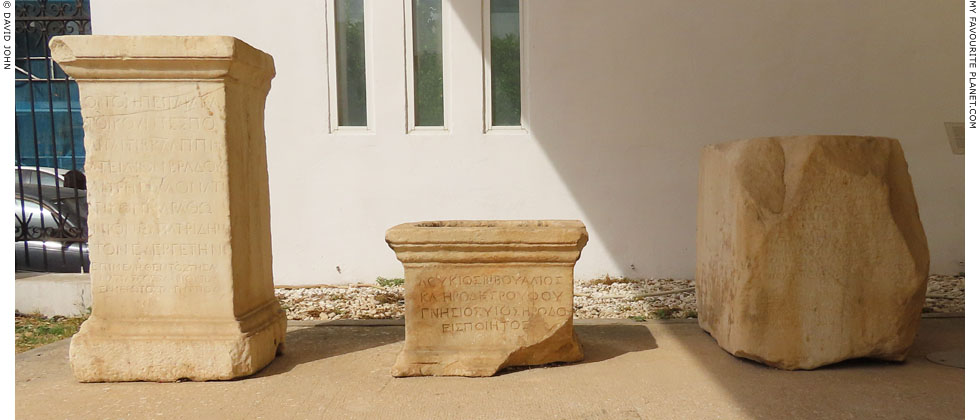
Three marble pedestals related to Herodes Atticus and his family, now in
the open-air exhibition area behind the Piraeus Archaeological Museum.
2nd century AD.
Piraeus Archaeological Museum. Inventory numbers, left to right: 3607, 10209, 10210.
See photos and details below. |
| |
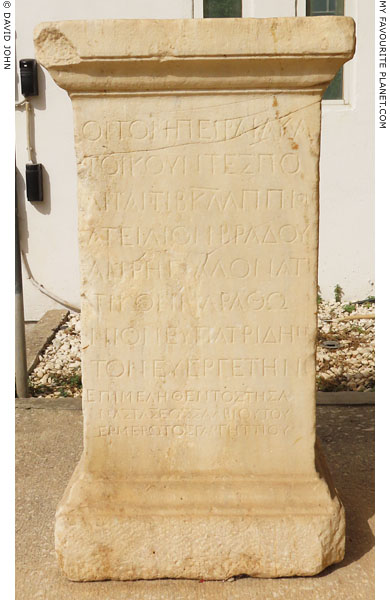
Inscribed marble pedestal for a statue of Atticus Bradua
(Αττικός Βραδούα, around 152 - after 209 AD), third son
of Herodes Atticus (see children above), his fifth child
and the only one to live to maturity. It was erected
in his honour by the foreign resident colony at Piraeus.
οἱ τὸν Πειραιᾶ κα-
τοικοῦντες πο-
λῖται ) Τιβ ) Κλ ) Ἄππιον
Ἀτείλιον Βραδού-
αν Ῥήγιλλον Ἀτ-
τικὸν Μαραθώ-
νιον Εὐπατρίδην
τὸν εὐεργέτην
ἐπιμεληθέντος τῆς ἀ-
ναστάσεως Σαλβίου τοῦ
Ἑρμέρωτος Γαργηττίου.
Inscription IG II² 3978.
Mid 2nd century AD. Found in the area
of the Great Harbour of Piraeus.
Piraeus Archaeological Museum. Inv. No. 3607. |
|
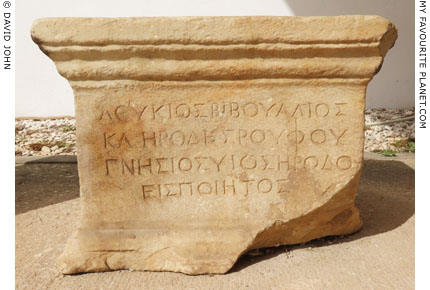
A marble pedestal for a statue of Lucius Vibullius,
illegitimate son of Rufus, adopted by Herodes Atticus.
Λούκιος Βιβούλλιος
Κλ Ἡρώδης Ῥούφου
γνήσιος υἱός, Ἡρώδου
εἰσποιητός.
Inscription IG II² 3979.
2nd century AD.
Piraeus Archaeological Museum. Inv. No. 10209. |
|
| |
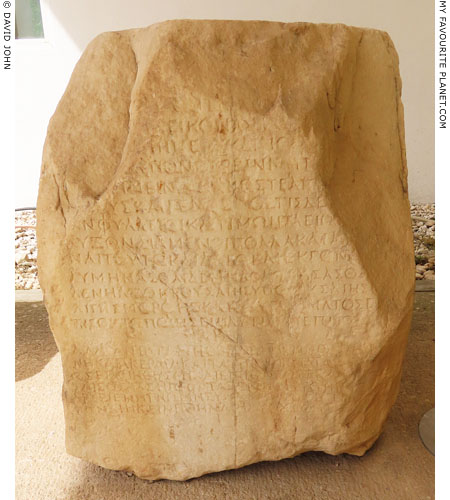
A marble pedestal set up by Herodes Atticus inscribed with
curses against would-be destroyers of his dedications.
2nd century AD.
Piraeus Archaeological Museum. Inv. No. 10210. |
|
|
| |
 |
|
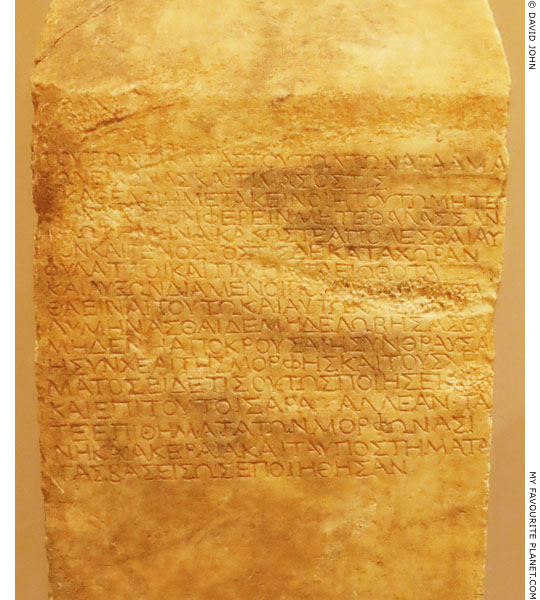 |
A headless herm stele inscribed with an imprecation (curse) by Herodes Atticus,
threatening terrible consequences for any future owner of the land who dared
to move or disturb the memorial and blessings on those who respected them.
2nd century AD. From the area of Marathon, Attica, Greece.
Marathon Archaeological Museum. Inv. No. Λ 213.
Inscription SEG 35:209 at The Packard Humanities Institute (PHI). |
|
| |
Herodes
Atticus |
The Villa of Herodes Atticus at Loukou, Arkadia
and the Astros Archaeological Museum |
|
 |
|
| |
The site of the Villa of Herodes Atticus (η Έπαυλη του Ηρώδη του Αττικού) at Loukou (Λουκού, ancient Eua, Εύα), 2.3 km south of Kato Dolia village (Κάτω Δολιανά), and around 4 km northwest (uphill) of Astros (Άστρος), Arcadia, Peloponnese. It is next to the Byzantine Monastery of Loukou (Ιερά Μονή Λουκούς), built in the 10th century AD around an early Christian basilica with stone from Herodes Atticus' estate, over a sanctuary of the heroized physician Polemokratis (Πολεμοκράτης), dated to the late Classical - early Hellenistic period. An early 4th century BC marble votive relief dedicated to Asklepios has been found at the monastery (National Archaeological Museum, Athens, Inv. No. 1402). The sanctuary, probably an Asklepieion healing centre, was mentioned by Pausanias, who visited Eua in the mid 2nd century AD, although he did not mention the villa.
"As you go from these common graves you come to Athene, where Aeginetans once made their home, another village Neris, and a third Eua, the largest of the villages, in which there is a sanctuary of Polemocrates. This Polemocrates is one of the sons of Machaon, and the brother of Alexanor; he cures the people of the district, and receives honors from the neighbours.
Above the villages extends Mount Parnon, on which the Lacedaemonian border meets the borders of the Argives and Tegeatae. On the borders stand stone figures of Hermes, from which the name of the place is derived. A river called Tanaus, which is the only one descending from Mount Parnon, flows through the Argive territory and empties itself into the Gulf of Thyrea."
Pausanias, Description of Greece, Book 2, chapter 38, sections 6-7.
Stretching across an area of over 20,000 square metres, Herodes' estate, in which the villa stood, contains a large complex of buildings, including the villa itself, a baths, an aqueduct with two arches, a sanctuary of the Nymphs and a heroon dedicated to Antinous. Finds include over 100 sculptures, several inscriptions, architectural members, mosaics and other artworks.
The English traveller William Martin Leake visited the Loukou monastery in March 1806, and noted that a large number of high quality sculptures found there were being shipped off elsewhere, used as building material or destroyed (Travels in the Morea, Volume II, chapter XXII, pages 485-494. John Murray, London, 1830). Subsequently other travellers and archaeologists visited the monastery, including members of the French Morea Expedition in 1831, who took ancient artefacts to Aegina (see above). The site of the villa was identified in 1906 by the Greek archaeologist Konstantinos Rhomaios (Κωνσταντίνο Ρωμαίο, 1874-1966) from two inscriptions relating to Herodes Atticus discovered there.
It was first excavated in 1977-1978 by Georgios Steinhauer (Γεώργιος Σταϊνχάουερ) and Panagiotis Faklaris (Παναγιώτης Β. Φάκλαρης), who published the first findings. Since then excavations have been undertaken by Dr Theodoros Spyropoulos 1979-2002, Alkmini Stavridis 1984-1987 and 1989, and Dr George Spyropoulos 1990-2002.
Archaeological excavations at Loukou have been continuing over recent years, although with limited resources. The continuation of the work there is largely thanks to the commitment and enthusiasm of Theodoros Spyropoulos, head of archaeological services in the Peloponnese, and local people.
See an excellent short video in English about the Villa of Herodes Atticus and the Archaeological Museum of Astros, including an interview with archaeologist Theodoros Spyropoulos. Miracle in Arcadia, Carmen Films, 2014:
www.youtube.com/watch?v=jqQFyaLRWEY at YouTube. 8 minutes 46 seconds.
Finds from the site are now in the Archaeological Museum of Astros (Αρχαιολογικό Μουσείο Άστρους), many are in a storeroom at the site itself, and others are in the Tripolis Archaeological Museum and the National Archaeological Museum, Athens.
Although closed for several years, the Astros museum and the archaeological site at Loukou can be visited by prior appointment with the Ephorate of Antiquities of Arkadia in Tripoli. For contact e-mail address and telephone number, see:
Archaeological Museum of Astros at odysseus.culture.gr, the Greek Ministry of Culture website.
Two short catalogues of locally found sculptures in the Astros museum were written in Greek the 1990s by the archaeologist Alkmini Datsoulis-Stavridis (Αλκμήνη Ντατσούλη-Σταυρίδη). The contents and illustrations of the two books are about the same, and they include only a small selection of the works in the Astros museum's collection (some now in Tripolis and Athens), but they provide a good introduction to the archaeology of the area, particularly with reference to finds connected with Herodes Atticus.
PDFs of the the catalogues (in Greek) can be downloaded from the Βιβλιοθήκη (Library) page of the website of the Zafeiris Foundation of Astros: www.zafeiris.gr/zafeiris_003.htm.
Αλκμήνη Ντατσούλη-Σταυρίδη, Γλυπτά από την Θυρεάτιδα Κυνουρίας (Alkmini Datsoulis-Stavridis, Sculptures from Thyreatida Kinouria). Athens, 1993.
Αλκμήνη Ντατσούλη-Σταυρίδη, Αρχαιολογικό Μουσείο Αστρους: Κατάλογος Γλυπτών (Alkmini Datsoulis-Stavridis, Astros Archaeological Museum: Catalogue of sculptures). Athens, 1999. |
|
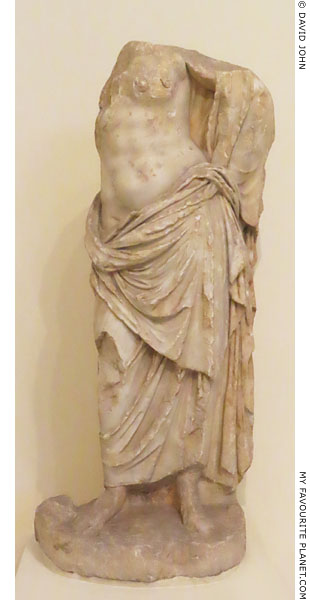
A marble statue of a goddess, naked to
below the waist, probably Aphrodite.
Found near the Monastery of Loukou,
probably from the villa of Herodes Atticus.
Mid 2nd century AD. Parian marble.
National Archaeological Museum,
Athens. Inv. No. 706. |
|
| |
Herodes Atticus and Ephesus?
The two sculptures form Loukou (photos, right) suggest a cultural link between the family of Herodes Atticus and Ephesus. It has been suggested that the Amazon-Caryatid relief may be an adaptation of the Mattei type of Amazon statue, although this idea has been challenged. It was first mentioned by the Scottish historian and philhellene George Finlay (1799-1875), who visited Astros and the Monastery of Loukou in 1827 and 1828. In a note for 18 July 1827 he wrote:
"Near this Monastery amidst some ruins is a statue of an Amazon with a base on which is represented a shield. The head is surmounted by a capital of acanthus. It has been a pilaster and is 7 1/2 feet high. Near is another draped and mutilated statue and beyond 2 columns of grey granite 2 ft 6 in diameter and 10 ft long 2. Others were it is said destroyed by orders of Veli Pasha and remains of them scattered about. Another is said to be buried to preserve it."
See: Guy D. R. Sanders, George Finlay in Lakonia and Arkadia. In: Jan Motyka Sanders (editor), Φιλολακων: Lakonian studies in honour of Hector Catling, pages 195-204. British School at Athens, London, 1992. Article at academia.edu.
When Guillaume Abel Blouet of the French Morea Expedition (see above) arrived at Loukou a few years later in 1831, the Amazon was found near the monastery, armless and broken into four fragments:
"Cariatide en marbre, trouvée dans le voisinage du monastère de Loukou. Ce fragment, d’un très-beau caractère et auquel manquent les bras, est brisé en quatre morceaux."
Guillaume Abel Blouet, Expédition scientifique de Morée, ordonnée par le gouvernement français: Architecture, sculptures, inscriptions et vues du Péloponèse, des Cyclades et de l'Attique, Volume 3 (of 3), planche 88, text on pages 55-57. Firmin Didot, Paris, 1838. At the Internet Archive.
Blouet appears to have been so impressed by the sculpture that he used it to illustrate the frontispiece of the first volume of his book on the Morea expedition. In the text he refers to more than one caryatid: "des cariatides romaines de Loucos près d’Astros".
Guillaume Abel Blouet, Expédition scientifique de Morée, ordonnée par le gouvernement français: Architecture, sculptures, inscriptions et vues du Péloponèse, des Cyclades et de l'Attique, Volume 1 (of 3), frontispiece, text on page 3. Firmin Didot, Paris, 1831. At the Internet Archive.
Presumably, like the Polydeukes relief (see above), it was first taken to Aegina and later to Athens.
I have not yet found any information about the statuette of Artemis Ephesia, one of many Roman period copies of the cult statue at the Temple of Artemis in Ephesus. The most famous example, "the Beautiful Artemis Ephesia", now in the Ephesus Museum, Selçuk, was made 125-175 AD, during Herodus Atticus' lifetime, and possibly during his time as prefect in Asia Minor. It is tempting to think that this small statuette found at his villa at Louka was a memento from a stay at Ephesus, where he may have purchased it or received it as a gift.
A fragment of a statue base found among the ruins of the aqueduct at Ephesus is inscribed with the name [Κλαύδιο]ν Άττικός Ήρώδην ([Klaudio]n Attikos Herodon). Inscription CIG 2978 (also SEG 13 501). It is thought that this may refer to Herodes Atticus or his father, one of whom may have given financial or other assistance to Ephesus, perhaps following an earthquake. |
|
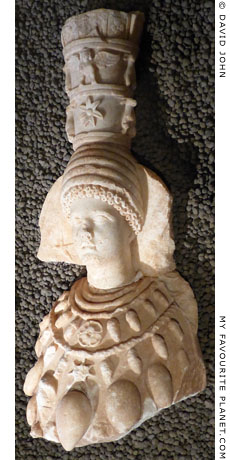
Statuette of Artemis Ephesia,
patron goddess of Ephesus.
Part of the large art collection
found at the Villa of Herodes
Atticus Eua (Loukou), Arkadia
in the Peloponnese.
Astros Archaeological Museum. |
|

A marble Amazon-Caryatid relief
on a pilaster from a gatepost at
Herodes Atticus' villa at Eua. The
figure was inspired by one of the
statues of Wounded Amazons
in the Temple of Artemis in
Ephesus (see Polykleitos).
The pilaster is topped by a
Corinthian-type capital with
acanthus leaves, and on the
front of the base is a relief
of a pelte (πέλτη), the type of
shield used by the Amazons.
2nd century AD. Found in the
Monastery of Loukou in Kynouria,
Arkadia. Height 190 cm.
National Archaeological Museum,
Athens. Inv. No. 705. |
|
| |
Herodes
Atticus |
Polemon of Laodicea |
|
 |
|
| |

A marble bust believed to be a portrait of the Greek Sophist
philosopher Polemon of Laodicea, a teacher of Herodes Atticus.
Around 140 AD. Found in 1888 in the Olympieion, Athens.
Pentelic marble. Height 64 cm.
National Archaeological Museum, Athens. Inv. No. 427.
Marcus Antonius Polemon (Μάρκος Ἀντώνιος Πολέμων, circa 90-144 AD), also known as Polemon of Laodicea (Πολέμων ὁ Λαοδικεύς) or Polemon of Smyrna, was from a prominent East Greek family of Roman consular rank. He was born in Laodicea on the Lycus (Λαοδίκεια πρὸς τοῦ Λύκου; Latin, Laodicea ad Lycum), southwestern Anatolia, in the area of Caria and Lydia, which became the Roman Province of Phrygia Pacatiana. [23]
Polemon was a master of rhetoric and, like Herodes Atticus, a prominent member of the Second Sophistic. He spent much of his life in the Ionian city of Smyrna (Σμύρνα; today Izmir, Turkey), where he became a much-honoured citizen. He was also a friend of Emperor Hadrian, and in 131/132 AD he gave the dedicatory oration for the enormous Temple of Olympian Zeus (the Olympieion) in Athens, the building of which was first begun around 174 BC but was finally completed by Hadrian.
Philostratus dedicated a chapter to Polemon in The lives of the Sophists, Book I, section 25, pages 106-137 (in the Loeb edition, see note 3). He described Herodes Atticus' first meeting with Polemon when he sought him out as a teacher on a visit to Smyrna during his period as prefect of Asia Minor. Philostratus also quoted Herodes' own impressions of Polemon. The account of Polemon's oration at the dedication of the Olympieion is on pages 110-113.
The bust was found during excavations in 1888 near the northern peribolos (περίβολος, perimeter wall) of the Sanctuary of Olympian Zeus in Athens, buried among 86 sculptures and fragments. Although many of the finds are now thought to have been taken from other sanctuaries and contexts, this bust was assumed to be from the Olympieion and identified as a portrait of Polemon. The identification is purely conjectural, apparently first suggested by the Hungarian archaeologist and art historian Anton Hekler (Antal Hekler, 1882-1940). There is no other known portrait of Polemon.
See: Anton Hekler, Philosophen- und Gelehrtenbildnisse der mittleren Kaiserzeit (Portraits of philosophers and scholars of the middle Imperial period). In: Antike 16, 1940, page 125, figs. 6-7. |
|
| |
Herodes
Atticus |
The Panathenaic Stadium, Athens |
|
 |
|
| |
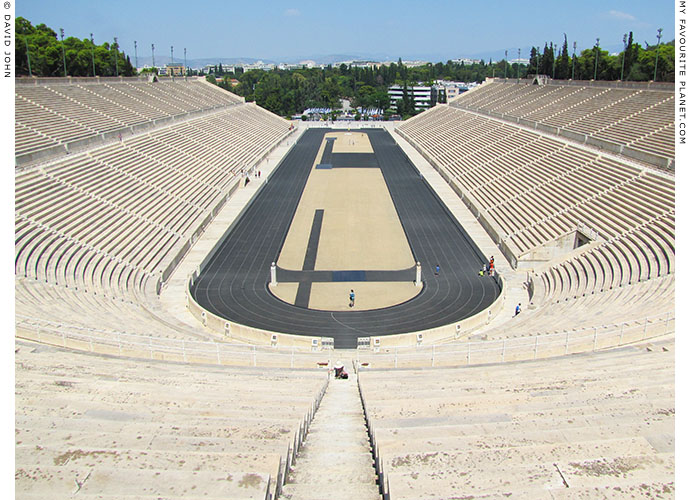
The restored Panathenaic Stadium, originally built by Herodes Atticus
before 143 AD, south of the National Gardens in the centre of Athens.
|
The Panathenaic Stadium (Παναθηναϊκό Στάδιο, Panathenaiko Stadio), nicknamed the Kallimarmaro (Καλλιμάρμαρο, Beautiful Marble), is the only stadium in the world built entirely of marble. The U-shaped, 50,000-seat racecourse replaced the first stadium here, built around 330 BC, during the administration of Lycurgus (Λυκοῦργος, Lykourgos; circa 390-324 BC), on the site of the old Panathenaic racecourse, between the hills Agra (Άγρα) and Ardettos (Αρδηττού), south of the Ilissos river. It was the location of the games of the Great Panathenaea festival, held every four years in honour of Athena.
It is thought that the theatrical and athletic contests of the festival were previouly held in the Agora. Lycurgus' ambitious building projects in Athens also included the rebuilding of the Theatre of Dionysos, as well as the construction of the naval arsenal in Piraeus (designed by the architect Philon of Eleusis) and the Lyceum gymnasium (on the site of the ancient sanctuary of Apollo Lykeios and the location of Aristotle's Lyceum). Not much has survived of this first stadium but it is thought to have been similar to others built in Greece around this time, with one end curved and closed, and the other end open, much like it appears today. The audience probably sat on the surrounding hillsides.
Its construction was financed by Eudemos of Plataia who had previously promised to donate a large sum of money to the city for the anticipated war against Philip II of Macedonia. After Philip decisively defeated the combined Theban and Athenian army at Chaironeia in 338 BC, effectively ending the war before it could begin, Eudemos' contribution was not required, and he used his wealth to construct the stadium. He was honoured in a decree of 329 BC:
Resolved by the people; Lykourgos, son of Lykophron of Boutadai proposed it. Since Eudemos in former times announced to the people a gift of 4,000 drachmas for the war if needed, and now has provided for the construction of the stadium and the Panathenaic theatre a thousand pairs of draft animals and arranged all things for the procession before the Panathenaia as he promised; resolved by the people to praise Eudemos ...
Inscription IG II² 351.
Around 470 years later, according to Philostratus, Herodes Atticus was put in charge of the organization of the Panathenaic Festival, and built the stadium, which was completed within four years. Philostratus also wrote that there was a temple of the goddess Tyche near the stadium.
"Furthermore he held the office of archon eponymus at Athens, and the curatorship of the pan-Hellenic festival; and when he was offered the crowning honour of the charge of the Panathenaic festival he made this announcement:
'I shall welcome you, O Athenians, and those Hellenes that shall attend, and the athletes who are to compete, in a stadium of pure white marble.'
In accordance with this promise he completed within four years the stadium on the other side of the Ilissus, and thus constructed a monument that is beyond all other marvels, for there is no theatre that can rival it.
Moreover, I have been told the following facts concerning this Panathenaic festival. The robe of Athene that was hung on the ship was more charming than any painting, with folds that swelled before the breeze, and the ship, as it took its course, was not hauled by animals, but slid forward by means of underground machinery. Setting sail at the Cerameicus with a thousand rowers, it arrived at the Eleusinium, and after circling it, passed by the Pelasgicum: and thus escorted came by the Pythium, to where it is now moored. The other end of the stadium is occupied by a temple of Fortune [Tyche] with her statue in ivory to show that she directs all contests.
Herodes also changed the dress of the Athenian youths [ephebes] to its present form, and was the first to dress them in white cloaks, for before that time they had worn black cloaks whenever they sat in a group at public meetings, or marched in festal processions, in token of the public mourning of the Athenians for the herald Copreus, whom they themselves had slain when he was trying to drag the sons of Heracles from the altar."
As with other extravagant buildings in Athens, including the Parthenon, the stadium was not universally popular. Herodes' father had promised in his will to pay every Athenian citizen one mina in cash every year, with an initial payment of 5 minae. However, according to Philostratus, his freedmen, who had somehow made themselves executors of his will, refused to pay most of the money out, using various legalistic pretexts. Many Athenians blamed Herodes for this, leading to hatred of their would-be benefactor and accusations that the stadium had been built at their expense. Charges laid by the Athenians against Herodes concerning the will led to a trial in Rome around 140-142 AD.
"When the will had been read, the Athenians made a compact with Herodes that by paying them each five minae down he should redeem his obligation to keep up continued payments. But when they came to the banks to get the sum that had been agreed upon, then and there they had to listen to the recital of contracts made by their fathers and grandfathers, showing that they were in debt to the parents of Herodes, and they were held liable for counter-payments, with the result that some received payment of only a small sum, others nothing at all, while some were detained in the market-place as debtors who must pay.
This treatment exasperated the Athenians, who felt they had been robbed of their legacy, and they never ceased to hate Herodes, not even at the time when he thought he was conferring on them the greatest benefits. Hence they declared the Panathenaic stadium was well named, since he had built it with money of which all the Athenians were being deprived."
Philostratus, The lives of the Sophists, Book II, chapter 1 (sections 549-550), pages 144-149 (in the Loeb edition, see note 3 ). |
|
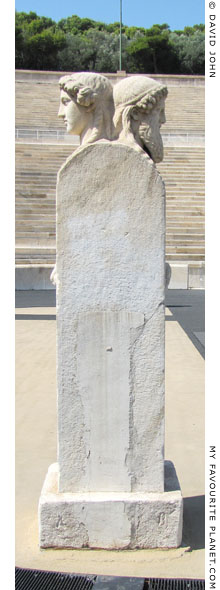
One of the double herms
of Apollo and Hermes in
the Panathenaic Stadium. |
|
| |
Pausanias also mentioned that the stadium was built by Herodes Atticus.
"A marvel to the eyes, though not so impressive to hear of, is a race-course of white marble, the size of which can best be estimated from the fact that beginning in a crescent on the heights above the Ilisus it descends in two straight lines to the river bank. This was built by Herodes, an Athenian, and the greater part of the Pentelic quarry was exhausted in its construction."
Pausanias, Description of Greece, Book 1, Chapter 19, Section 6.
It seems that Pausanias (or his sources) were exaggerating in claiming that the construction of the stadium almost exhausted the suppply of marble at the quarries on Mount Pendeli. Marble is still quarried there today. Pentelic marble was used to restore the stadium at the end of the 19th century, and more recently other ancient monuments such as the Parthenon.
After the prohibition of pagan religious festivals and games by Emperor Theodosius I in the late 4th century AD, the stadium was abandoned. During the Middle Ages most of its marble was plundered for use as building material elsewhere, and its remains gradually became covered in earth and forgotten. It was excavated and partially restored in 1869. The Zappas Olympics, financed by the wealthy Greek benefactor Evangelis Zappas (Ευάγγελος Ζάππας), were held here in 1870 and 1875. Following a more complete restoration in 1895 (work continued until 1900) by the architects Ernst Ziller and Anastasios Metaxas (Αναστάσιος Μεταξάς), it was the venue for the opening and closing ceremonies of the first modern Olympic Games in 1896, and four of the nine sports were contested here.
Two of the four ancient herms found by archaeologists during excavations still stand at the near turn of the racetrack (see photo above right). Another of the herms is displayed in the National Archaeological Museum, Athens (see photos on Pergamon gallery 2, page 15).
Entrance to the stadium used to be free, but the Athens municipality now charges for admission. There is a small museum beneath the east side of the stadium, accessed through the tunnel whose entrance can be seen on the right of the photo, just above the curved turning of the track. The permanent exhibition includes a collection of Olympic torches (see Come on, baby, light my fire at The Cheshire Cat Blog).
The Panathenaic Stadium, Pangrati, Athens
Tickets (from 1 January 2022): €10; reductions (students and visitors over 65 year old) €5.
Free Admission: children under 6 years; visitors with disabilities and person accompanying them.
Opening hours:
March - October 8:00 - 19:00;
November - February 8:00 - 17:00.
Website: www.panathenaicstadium.gr
Herodes Atticus also financed the rebuilding of the temple of Athena and the cult statue of the goddess in the Attic deme of Myrrinous (Μυρρινοῦς), east of Athens. The dedication is known only from an inscription on a statue base, discovered in the Panagia church at Merenda (Μερέντα), which is in the territory of the ancient deme [24].
Ἡρώδης Ἀττικοῦ
Μαραθώνιος τὸν νεὼν
ἐπεσκεύασεν καὶ τὸ
ἄγαλμα ἀνέθηκεν
τῇ Ἀθηναίᾳ.
Herodes Atticus from Marathon rebuilt the temple and dedicated the statue of Athena.
Inscription IG II² 3191 (also CIG 490). |
|
|
| |
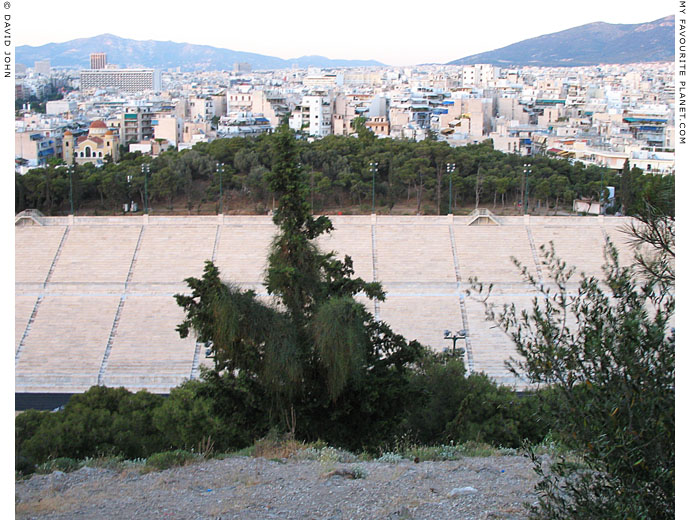
The location of the tomb of Herodes Atticus on the hill east of the Panathenaic Stadium,
Athens, as seen from Ardettos (Αρδηττού) hill to the west, on which the temple of Tyche
(Fortuna) built by Herodes Atticus is thought to have stood. Annia Regilla was the first
priestess of Tyche in Athens. Ardettos is now a wooded public park.
In the background to the the left is Mount Pendeli and on right Mount Ymittos. |
| |
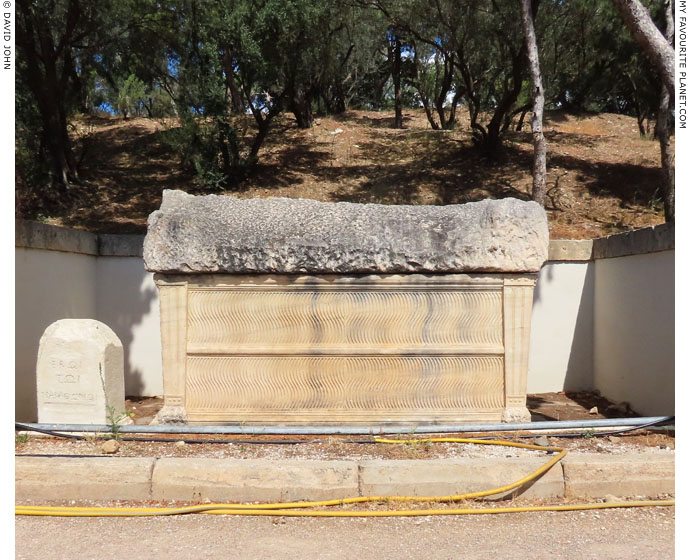
The Roman period marble kline sarcophagus (the lid does not belong), which
it was once believed may have been the tomb of Herodes Atticus, on the hill
east of the Panathenaic Stadium. In Antiquity the hill was known as Agra (Άγρα). |
| |
A wide path runs outside and above the sides and curved rear of the horseshoe-shaped stadium. Its primary purpose is for maintenance of the grounds surrounding the stadium, but it is accessible to the public (free of charge) during the day, and has become a popular place for locals to go strolling or jogging.
On the east side of the path, opposite the retaining wall of the stadium, a small rectangular space surrounded by a low wall has been established for the sarcophagus which was found here. It is not signposted, and there is no indication of what this area represents. It is a sort of unofficial modern monument to Herodes Atticus, the original builder of the marble racecourse.
The sarcophagus is of the type known today as "strigillated", because it is decorated with patterned reliefs of rows of S-shaped curves which have been compared to the shape of a strigil, the ancient metal implement used by athletes to scrape oil and dirt from their bodies. While we may see this decoration quite fitting for a sports venue, it seems rather plain and anonymous, hardly grand enough for the fabulously wealthy Herodes, who was almost obsessively fascinated by the symbolic value of Greek figurative art. It is also described as a kline sarcophagus, designed to resemble a kline (κλίνη, couch, chaise longue) with a separate lid sculpted to resemble a mattress on which a sculpture of the deceased person or couple reclines as if enjoying a symposium (συμπόσιον, symposion, dinner or drinking party) or banquet (see some examples of kline sarcophagi in Homer part 2). At each end of the front of this sarcophagus can be seen a tapering leg with a lion's paw foot, representing the legs of a kline.
To the left of the sarcophagus has been placed a replica of a marble altar, or rather the stump of an altar, with a dedication to "Herodes, hero of Marathon".
Ἑ̣[ρώδει]
ἕρωι
τῶι Μαραθωνίωι.
Inscription IG II² 6791.
The original is said to be in the archaeological site of Hadrian's Library, near the Monastiraki Metro station. However, the area of the small museum within the site, on which the altar stands, has been closed for a number of years (2024). |
|
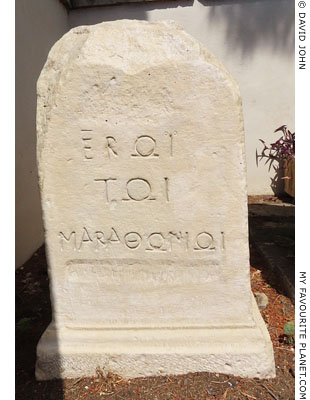
A modern replica of a marble funerary
altar with an inscribed dedication to
"Herodes, hero of Marathon" found at
the Panathenaic Stadium, Athens. |
|
| |

A map of central Athens between Syntagma Square (top left) and the Panathenaic Stadium,
showing the supposed sites of the the temple of Tyche and the tomb of Herodes Atticus
(marked in blue type) on the hilltops either side of the stadium.
|
The hills are part of the slope southeastwards from the Ilissos river up to Mount Ymittos. The river itself now runs undeground beneath the busy Vassileos Konstandino Avenue, which continues southwestwards from the stadium as Ardittou then as Kallirrois. Agrai, the ancient district around the stadium is known today as Mets.
I have also marked in blue the names of Odos Irodou Attikou and Odos Rigillis, the streets named after Herodes Atticus and Annia Regilla. For some reason they are separated by two blocks of housing which include the former palace of the crown prince (Palais du prince royal), now the official residence of the Greek president.
On the east side of Syntagma Square (Plateia tou Syntagmatos, Constitution Square) stands the former Royal Palace (Palais du Roi), now the Vouli, the Greek parliament. Around it the former Royal Garden (Kipos Basilikos, Jardin du Palais) is now the National Garden (Kipos Ethnikos) public park.
Source of map: Greece, Handbook for Travellers. Baedeker, Leipzig, 1894. |
|
| |
Herodes
Atticus |
The Odeion of Herodes Atticus, Athens |
|
 |
|
| |

The restored interior of the Odeion of Herodes Atticus (Ωδείο Ηρώδου του Αττικού), also known
as the Herodeion (Ἡρώδειον), at the foot of the southwest slope of the Athenian Acropolis.
The theatre is named after Herodes Atticus, who financed its construction around 160-174 AD.
It was one of the last major public buildings to be constructed in Athens in antiquity.
For further details see Odeion of Herodes Atticus in the Athens Acropolis gallery. |
| |
Herodes
Atticus |
Herodes Atticus and Delphi |
|
 |
|
| |
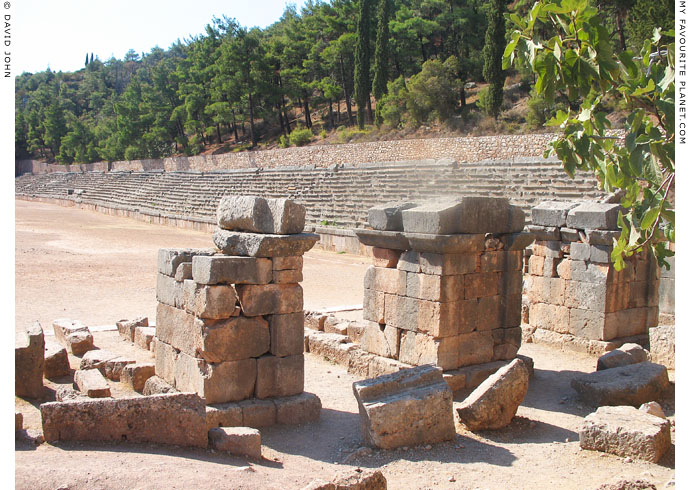
The remains of the stadium of Delphi: the entrance at the east end
of the race track and the twelve tiers of seating along the north side.
|
According to Pausanias, Herodes Atticus renovated the stadium at Delphi, the venue of the Pythian Games, cladding the seating of local Parnassian limestone in Pentelic marble.
"Adjoining the sacred enclosure is a theatre worth seeing, and on coming up from the enclosure ... and here is an image of Dionysus, dedicated by the Cnidians. The Delphian race-course is on the highest part of their city. It was made of the stone that is most common about Parnassus, until Herodes the Athenian rebuilt it of Pentelic marble."
Pausanias, Description of Greece, Book 10, chapter 32, section 1. At Perseus Digital Library.
Philostratus alluded to Herodes' renovation of the stadium among a list of his benefactions at places in Greece and Italy:
"He also dedicated the stadium at Pytho [Delphi] to the Pythian god [Apollo] ..."
Philostratus, The lives of the Sophists, Book II, chapter 1, section 551, page 149 [see note 3].
The Delphi stadium stands to the northwest and above the precinct around the Sanctuary of Apollo, at the highest point of the ancient city (altitude 654 metres). It was used for athletic contests, including footraces. Chariot races were held on the plain below the city.
Work on the stadium, including the construction of a monumental arched gateway at the eastern end, is thought to have been undertaken around 167 AD, and to have been the last large building project at Delphi in Antiquity. The stadium had twelve levels of seating on the north side, six on the south, curved seating at the western end, and had capacity of around 6500-7000 spectators.
The racetrack was 25.5 metres wide and 177.55 metres long , equivalent to 600 Delphian feet which was one Delphic stadion.
The marble was completely removed at some later period. The twelve tiers of seating covered with limestone slabs on the north side of the stadium were cut into the rock of the slope and have survived. However, the six tiers of seating on the south side and the semicircular western end (sphendone) were built on an artificial terrace which has collapsed, and much of it has been washed away over the centuries.
Inscriptions show that statues of Herodes Atticus, Annia Regilla and Polydeukes were dedicated by the city of Delphi, southwest of the Great Polygonal wall of the Temple of Apollo, and that Herodes and Regilla also set up statues at the sanctuary. |
|
| |
Herodes
Atticus |
Herodes Atticus and Patras (?) |
|
 |
|
| |
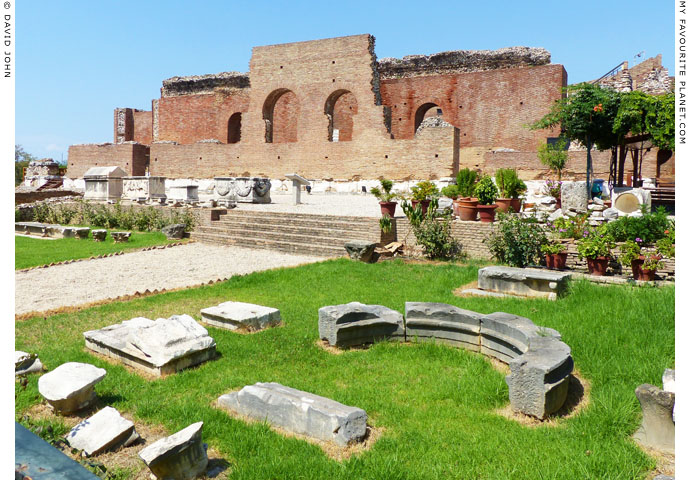
The facade of the Roman Odeion of Ancient Patras (Πάτραι).
|
The Roman Odeion in Ano Polis (the upper city), on the west side of Patras, is thought to be a little older than the Odeion of Herodes Atticus in Athens, and to have been built around the mid second century AD, during the reign of Antoninus Pius or Marcus Aurelius. It is not known who built the theatre, and little information concerning its history has survived in ancient literature or inscriptions.
In the photo above can be seen part of the odeion's outer wall, behind which is the surviving 8 metre high section of the skene (stage house) with three arched doorways. As on the Odeion of Herodes Atticus, arched recesses in the skene wall originally held statues. The semicircular cavea (audience seating area) has a diameter of 48 metres and was supported by a strong retaining wall reinforced by buttresses. The semicircular orchestra (performing area) is 10 metres in diameter.
Pausanias described the odeion as being near the agora (market place) of Patras, and compared it to the larger odeion in Athens:
"Next to the market-place is the Music Hall, where has been dedicated an Apollo well worth seeing. It was made from the spoils taken when alone of the Achaeans the people of Patrae helped the Aetolians against the army of the Gauls. The Music Hall is in every way the finest in Greece, except, of course, the one at Athens. This is unrivalled in size and magnificence, and was built by Herodes, an Athenian, in memory of his dead wife. The reason why I omitted to mention this Music Hall in my history of Attica is that my account of the Athenians was finished before Herodes began the building."
Pausanias, Description of Greece, Book 7, chapter 20, section 6. At Perseus Digital Library.
The spoils (loot) from which the statue of Apollo was made were probably from the battles fought in central Greece in 279 BC by a Greek coalition against the invading Gauls led by Brennus. This was around 439 years before the building of the Roman odeion. We are not told whether an older theatre or odeion stood on the site before. In the agora stood a temple of Olympian Zeus and a sanctuary of Apollo, and nearby were sanctuaries of Asklepios, Athena, Nemesis, Aphrodite and Dionysus. There was also a stadium, the ruins of which can still be seen.
At the end of the third century AD the odeion was destroyed by fire, and gradually disappeared beneath layers of earth. Rediscovered in 1889, it was excavated 1957-1960. It was restored and partially reconstructed 1959-1961, with the addition of tiers of marble seating. The top tiers are brick. It can now seat around 2,200 spectators and is used for performances and concerts in the summer.
Roman Odeon of Patras archaeological site
(Ρωμαϊκό Ωδείο Πατρών)
Paleon Patron Germanou Street and Sotiriadou Street, 26225 Patras.
600 metres southeast of the city centre.
The site takes up a large block between four streets. The entrance is on Sotiriadou Street. Sarcophagi, mosaics and other local archaeological finds are displayed around the site.
Opening hours: Tuesday-Sunday 8:00 - 15:00. Monday closed. Admission free. |
|
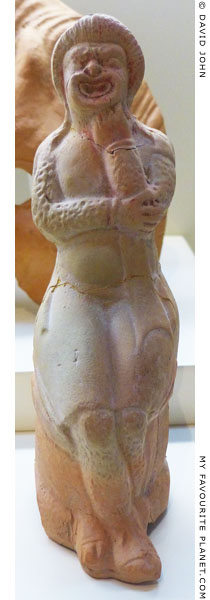
A terracotta figurine of an actor
wearing a mask and the costume
of Papposilenos (see Dionysus).
From Patras. 2nd century AD.
Patras Archaeological Museum. |
|
| |
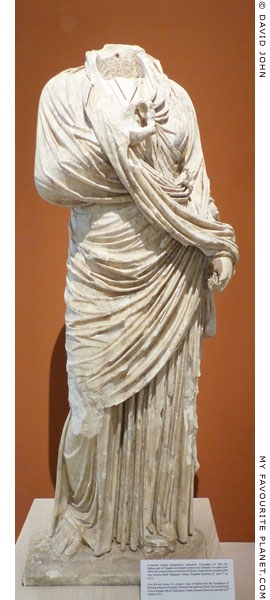 |
|
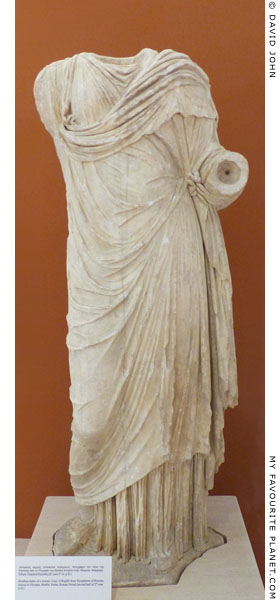 |
Two marble statues of women (both now headless) found in Patras. According
to the museum labelling they are copies of statues of the Nymphaeum of Herodes
Atticus in the Sanctuary of Zeus, Olympia (see above): the statue on the left is
thought to have portrayed Empress Sabina, and that on the right Annia Regilla.
2nd half of the 2nd century AD. Found in a Roman Villa
at Voud Square, Patras, Peloponnese, Greece.
Patras Archaeological Museum, Naples.
|
|
The heads of the statues were made separately then inserted into the holes on the bodies where the neck should be. It was thus possible for sculptors to make portrait heads of specific persons and place them on more generic bodies. It also meant that the statues' owners could change the heads to suit shifting political realities. If, for example, an emperor or politician fell from grace or power, his statue head could be replaced with that of his successor.
The "Large Herculaneum Woman" type statue on the left may be classified as generic, and as can be seen from the photos above, the bodies of most of the statues of mortals on the nymphaeum in Olympia are quite generalized, with no personal attributes, so that they cannot be identified as individuals. Some of the statues have been identified by matching the shape and size of their bases to inscribed pedestals, often found separately. Many identities are tentative or speculative, and remain subjects of debate.
Here we have two generic female statue bodies, similar to those in Olympia, but they are by no means identical, as can be seen by comparing the photos of the "Sabina" statues from Olympia and Patras below.
So far I have not found any further literature on these statues. Information about the archaeology of Patras is generally difficult to find, but considering the great interest in the monuments of Olympia, Roman imperial portraiture and Herodes Atticus and his family, it is surprising that neither the discovery of these statues nor their presence in Patras seem to have been discussed in print. If you have any further information, please get in contact. |
|
| |

The "Sabina" statue from the
Nymphaeum in Olympia.
Altes Museum, Berlin. Inv. No. 1398. |
|

The "copy of Sabina" in Patras. |
|
| |
Herodes
Atticus |
The Odeion of Ancient Corinth |
|
 |
|
| |
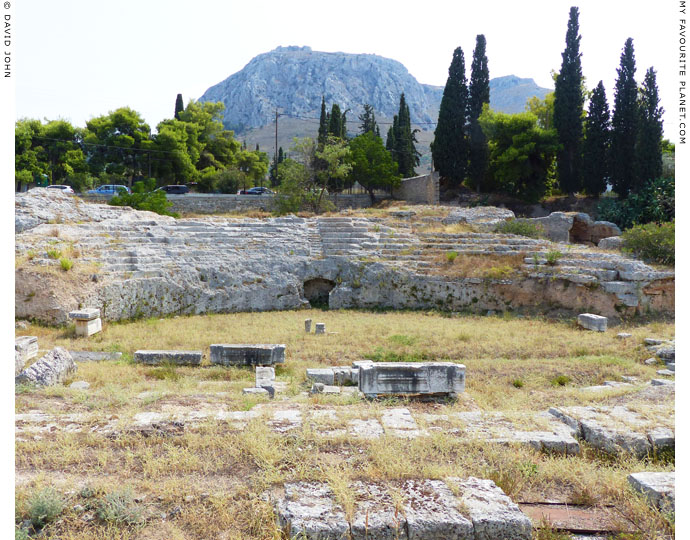
The remains of the Roman Odeion of Ancient Corinth, with Acrocorinth in the backgound.
|
The remains of the Odeion of Ancient Corinth (Αρχαία Κόρινθος) stand to the west of the Forum and the temple of Apollo, and immediately to the south of the larger theatre. Built in the mid-late first century AD of poros limestone, it was reconstructed in the second century, perhaps around 175 AD, by Herodes Atticus, who added a facade and a skene (stage house) and clad the seating, walls and orchestra floor in marble.
It was rediscovered by American archaeologists in 1907 and first excavated in 1927-1928. The roofed concert hall, used for musical events and rhetorical competitions, was built on the natural slope of a hill. In the middle of the 64 metre long facade was a 2.65 metre wide doorway. Between the facade and the skene a long corridor led to two wings at either side, each containing three rooms. The skene was around 63 metres long, 15 metres wide and decorated with opus sectile mosaics. Other parts of the odeion were also decorated with high quality mosaics. The cavea (audience seating area) was slightly less than a semicircle in form, and could seat around 3000 spectators. A large colonnaded courtyard connected the odeion to the nearby theatre, similar to the way in which the Stoa of Eumenes connected the Odeion of Herodes Atticus and Theatre of Dionysos in Athens.
Following damage caused by fire in the early third century AD, the odeion was rebuilt around 225 AD, during the reign of Severus Alexander (222-235 AD), when it was converted into a gladiatorial arena. Some time later it fell into disuse and was destroyed in the late fourth century, perhaps in the earthquakes of 365 AD and 375 AD or during the Gothic invasion of Alaric I in 396 AD.
Although Philostratus wrote that Herodes Atticus built the odeion, archaeological evidence indicates that he remodelled the existing building.
"But I must not neglect to mention also the roofed theatre which he [Herodes Atticus] built for the Corinthians, which is far inferior indeed to the one at Athens [the Odeion of Herodes Atticus] but there are not many famous things elsewhere which equal it."
Philostratus, The lives of the Sophists, section 551, page 149 [see note 3].
Pausanias, who visited Corinth around 155 AD, briefly noted that the odeion was west of the Corinthian agora (Description of Greece, Book 2, chapter 3, section 6), but did not describe it, say when or by whom it was built or mention any involvement of Herodes Atticus in its history. He also failed to mention Herodes Atticus in connection with the Peirene Fountain in Corinth (see below), and he made no mention at all of the Nymphaeum in Olympia (see above) or his villa at Eua (Loukou). As is often the case with Pausanias, he may have simply omitted these from his narrative for the sake of brevity, they may have slipped his mind at the time of writing, he was unaware of their history, or he did not find them sufficiently interesting. Perhaps more probably, his visits to Corinth and Olympia, around 155 AD, were before these works had been completed. As he wrote himself, the Odeion of Herodes Atticus was completed after his stay in Athens (see the note on Athens Acropolis gallery page 32).
See: Oscar Broneer, Corinth, Volume X: The Odeum. Results of the excavations conducted by the American School of Classical Studies at Athens. Harvard University Press, 1932. At the Internet Archive. |
|
| |
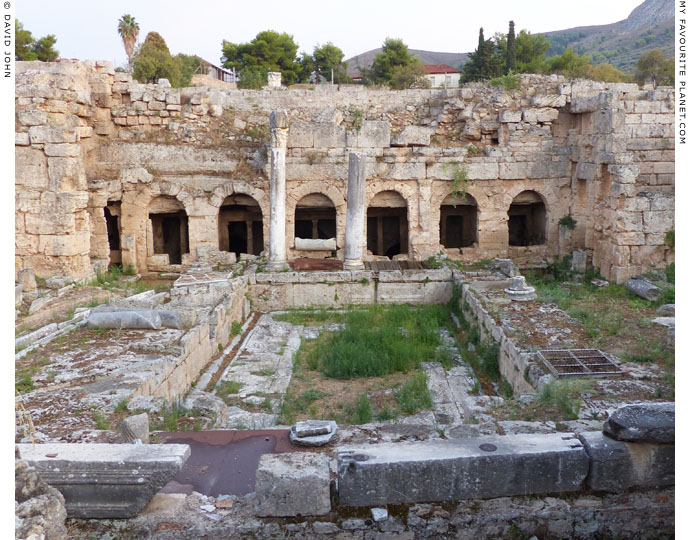
The remains of the Peirene Fountain in the Forum of Ancient Corinth,
perhaps renovated by Herodes Atticus.
|
There are two natural springs named Peirene at Corinth, the upper Peirene spring is at the top of Acrocorinth (its lower slope can be seen in the background). The lower Peirene, in an area of the city which during the Roman period became part of the Forum, was in use from at least the Neolithic period, and the first attempts at water management were made during the Geometric period. It was surrounded by a succession of constructions from the Archaic period. Following the destruction of Corinth by the Roman consul Lucius Mummius in 146 BC, the fountain house was rebuilt with successive further embellishments, including a renovation by Herodes Atticus.
According to one myth, mentioned by Pausanias, the Peirene spring was formed when Artemis accidentally killed Kenchrias, and his mother Peirene (Πειρήνη), daughter of the river god Acheloos and a lover of Poseidon, literally dissolved into tears there. This myth has similarities to that of Niobe.
"On leaving the market-place along the road to Lechaeum you come to a gateway, on which are two gilded chariots, one carrying Phaethon the son of Helius, the other Helius himself. A little farther away from the gateway, on the right as you go in, is a bronze Heracles. After this is the entrance to the water of Peirene. The legend about Peirene is that she was a woman who became a spring because of her tears shed in lamentation for her son Cenchrias, who was unintentionally killed by Artemis.
The spring is ornamented with white marble, and there have been made chambers like caves, out of which the water flows into an open-air well. It is pleasant to drink, and they say that the Corinthian bronze, when red-hot, is tempered by this water, since bronze . . . the Corinthians have not. Moreover near Peirene are an image and a sacred enclosure of Apollo; in the latter is a painting of the exploit of Odysseus against the suitors."
Pausanias, Description of Greece, Book 2, chapter 3, section 2. At Perseus digital Library.
In another tale, the spring was the hoofprint of Pegasus (Πηγασος, Of the Spring, a child of Medusa), formed when the winged horse stamped its foot in irritation as the hero Bellerophon bridled him. As Pausanias pointed out, this legend was also attached to springs in Troezen and Boeotia (Description of Greece, Book 2, chapter 31, section 9). [25]
The theory that Herodes Atticus renovated the Peirene Fountain is largely based on the discovery there in 1899 of an inscribed base of a statue of his wife Annia Regilla. The inscription reads:
[Ν]εύματι Σισυφίης βoυλῆς παρὰ χεύματι πηγῶν
Ρηγίλλαv μ’ἐσοπᾶ(ι)ς, εἰκόνα σωφροσύνης
ψ(ηφίσματι) β(oυλῆς)
By the command of the Sisyphian Boule, beside the streams of the source
You see me, Regilla, an image of moderation [sophrosyne].
By decree of the city council.
Corinth Archaeological Museum. Inv. No. I 62.
Inscription Corinth 8,1 86 (also IG IV 1559).
While a number of scholars have cautiously accepted this idea, some have questioned how many of the additions to the fountain made during this period, known as the Sixth Roman Period or Second Marble Period, may be attributed to Herodes Atticus.
As with the Odeion of Corinth (see above), Pausanias did not mention Herodes Atticus in connection with the fountain, and his possible renovations may not have been completed until after the author's visit around 155 AD, and perhaps after Annia Regilla's death around 158-160 AD. |
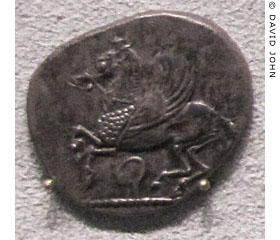
Silver stater of Corinth showing
Pegasus. 550-520 BC.
Altes Museum, Berlin. |
| |
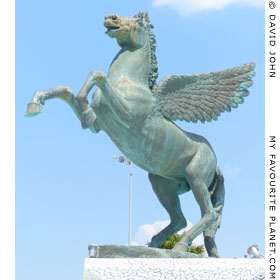
A modern bronze statue of Pegasus
on the waterfront of New Corinth. |
| |
| |
Herodes
Atticus |
Herodes Atticus' villa at Kifissia |
|
 |
|
| |
The location of parts of Herodes Atticus' estate at Marathon, his home deme, have been identified by a substantial number of architectural remains and archaeological finds. The site of his villa in Kifissia (Κηφισιά), northeast of Athens, has not yet been discovered, but it is thought to have been near the Pyrna stream (η Πύρνα) where the portrait bust of Herodes Atticus (see the photo at the top of page) and a bust of Polydeukes (see above) were unearthed in February 1961 in a private garden in Rangavi Street, near the Late Byzantine Panagia Xydou church (Παναγία Ξυδού), and where several inscriptions connected with him have been discovered built into churches.
A marble hypogaeum (tomb) containing four sarcophagi was discovered by builders in 1866 in the modern centre of Kifissia. The area is thought to have been part of Herodes Atticus' Kifissia estate, and the sarcophagi the graves of four of his six children who died at a young age. An inscription (SEG 26:290) found built into the nearby Agia Paraskevi church (Αγία Παρασκευή) around the same time appears to confirm this. (The church, used as a mosque, then a barracks, was later demolished; the present Agia Paraskevi chapel was built in 1950.) The epigram depicts Herodes grieving over the death of a three month old infant son, one of three of his children who lie in coffins. This may refer to his sixth child, thought to have been born prematurely at the time of Regilla's death and to have been buried in the only undecorated sarcophagus found in the tomb.
Ἡρώδης οἳ τήνδε κόμην οὐ πάντα ἐνιαυτόν
οὔτε κόμην θρέψας οὔτε σέ, παῖδα φίλον,
μηνὶ τρίτῳ κείρας ὑπὸ κεύθεσι θήκατο γαίης,
Ἡρώδης, δεύσας ἄκρα κόμης δάκρυσι,
σῆμ’ ἔτυμον παίδων ψυχαῖς τρισίν, ὥς ποτε σῶμα
δέξεσθ’ ἐν θήκαις ὑμετέροιο πατρός.
Herodes set in the depths of the earth this his lock of hair,
Having dampened the tips of the hair with his tears,
When for less than the cycle of a year
He had neither grown his hair nor reared you, dear son,
For he cut this lock in the third month.
May it be a true token to you three childrens' souls
That you will someday receive among the coffins the body of your father.
Inscription SEG 26:290 at The Packard Humanities Institute.
The fourth and largest sarcophagus in the tomb, the "Leda sarcophagus" (see below), is thought to be Elpinike's. A fragmentary inscription found at Kifissia, mentioning Herodes Atticus and Elpinike, and thought to be her epitaph (funerary inscription), appears to confirm that she was buried there (IG II² 12568/9, see note 1).
Athenais is thought to have been granted the unusual right to be buried within the city walls of Athens (Philostratus, The lives of the Sophists, Book II, section 558, see quote above). Atticus Bradua (Αττικός Βραδούας), the only child to outlive his parents, was disinherited by Herodes, and may not have died in Greece.
The sarcophagi are now displayed in situ in a small, purpose-built building on Plateia Platanou, just east of Kifissia Metro station.
See: Ellen E. Perry, Iconography and the dynamics of patronage: a sarcophagus from the family of Herodes Atticus. In: Hesperia, Volume 70, Issue 4 (October - December 2001), pages 461-492. American School of Classical Studies at Athens (ASCSA). At jstor.org.
Spon and Wheler [see note 4] passed through Kifissia on Sunday 1 March 1676, and saw the remains of the tomb (although they did not recognize it as such), near the mosque (the old Agia Paraskevi church) also mentioned by Richard Chandler (see above):
"We parted hence [from Pendeli] the next day about ten in the Morning, and turning about the North-West side of the Mountain; in the Plain of Athens we came into the way that leads to Marathon: wherein we passed first by a Village about two or three Miles from Penteli, called Gevisia, or Cevisia: of which Κεφήσια was the ancient name: Herodes Atticus above-mentioned had here one of his Country-Houses. It is situate upon the stream, that cometh from the Mountain Pentelicus and falleth into the Cephisus. We perceiv'd some ancient Walls of Marble near the Mosque there, as we went thorough the Village."
George Wheler, A journey into Greece in the company of Dr Spon of Lyons, Book VI, page 453. Cademan, Kettlewell and Churchill, London, 1682. At googlebooks.
Aulus Gellius (circa 125 - after 180 AD), a Latin grammarian who studied in Athens (probably in the 140s AD), one of many wealthy Romans who studied in Greece to attain cultural kudos, wrote about Herodes Atticus' personality and philosophical attitudes in his book Attic nights. He began by describing the luxury and elegance enjoyed by Herodes, his pupils and guests at his Kifissia villa.
"While we were students at Athens, Herodes Atticus, a man of consular rank and of true Grecian eloquence, often invited me to his country houses near that city, in company with the honourable Servilianus and several others of our countrymen who had withdrawn from Rome to Greece in quest of culture. And there at that time, while we were with him at the villa called Cephisia, both in the heat of summer and under the burning autumnal sun, we protected ourselves against the trying temperature by the shade of its spacious groves, its long, soft promenades, the cool location of the house, its elegant baths with their abundance of sparkling water, and the charm of the villa as a whole, which was everywhere melodious with plashing waters and tuneful birds."
Aulus Gellius, Attic Nights, Book I, chapter 2. At Perseus Digital Library.
Other references to Herodes Atticus in Book 9, chapter 2 and Book 19, chapter 12.
See also: Sarah McHugh, The villas of Herodes Atticus: a new form of elite self-expression. In: Renewing Athens: the ideology of the past in Roman Greece, pages 186-200. PhD thesis, University of Oxford, 2017. PDF at ORA, Oxford University Research Archive. |
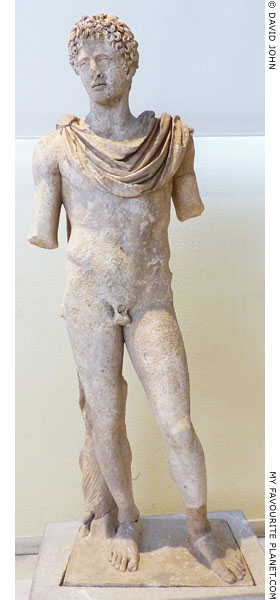
A marble statue of a nude youth
found in Kifissia, perhaps from the
estate of Herodes Atticus. Around 150 AD. Thought to be from
a workshop in Northern Greece.
A copy of a post-Polykleitian
bronze statue of the Hermes type.
Piraeus Archaeological Museum.
Inv. No. 4498. |
| |

A reconstruction drawing of the hypogaeum, the
vaulted tomb in Kiffisia, in which the sarcophagi
connected to Herodes Atticus' family were found. |
| |
| |

A relief of the Dioskouroi and their sister Helen of Troy on the front of the "Leda sarcophagus",
an Attic marble sarcophagus in Kifissia, northeast of Athens. Mid 2nd century AD.
|
Known as the "Leda sarcophagus", this is the largest of four sarcophagi in a marble tomb discovered in September 1866 near the church of Agia Paraskevi (used as a mosque, then a barracks, later demolished) on Platanos Square (Πλατεία Πλατάνου, Plateia Platanou), Kifissia, northeast of Athens. The sarcophagi are now displayed in situ in a small, purpose-built building (see below). The area is thought to have been part of the estate of Herodes Atticus and Annia Regilla, and the sarcophagi the graves of four of their six children who died at a young age. This sarcophagus may have been made for Elpinike (Ἐλπινίκη), their second child and first daughter.
Sarcophagus height 112 cm; length 227 cm (front), 233 cm (back);
width 94 cm (left side), 89 cm (right side). [26]
The fragmentary gabled lid currently on the sarcophagus does not belong to it, and the original lid was probably a kline sculpture, depicting one or more figures lying on a kline (couch). Such sculptures usually depict the deceased (see an example of a kline sculpture on a Roman sarcophagus on the Dioskouroi page, and on Etruscan cinerary urns in Homer part 2), and in this case may have been a portrait of Elpinike, and perhaps also her husband. A marble fragment of a reclining female figure (now missing) found in the tomb was probably part of the lid.
On the front is a relief of the Dioskouroi standing either side of their sister Helen of Troy. The twins are almost mirror images, arranged symmetrically, standing frontally with their heads turned towards Helen in the centre. In the lowered inner hand each holds an upturned, sheathed sword by its hilt, and the raised outer arm originally held a metal spear which was probably stolen by grave robbers. The figures stand in a contrapposto pose, with the weight resting on the outer leg and the other slightly bent. Each is naked apart from a fillet (headband) and a cloak which covers the chest and shoulders, and hangs to behind the mid calfs. On both figures the cloak is fastened at the right shoulder.
Helen faces frontally, with her head turned slightly to her left. She wears a fillet, a long, sleeved chiton girdled at the waist, and a himation (cloak), which rests on her shoulders, with the lower right side crossing in front of her lower torso and draped over her raised left forearm. In her left hand she holds a small object, perhaps an apple or a pomegranate.
The Classicistic relief on the left side of the sarcophagus depicts Zeus, disguised as a swan, attempting to copulate with a nude Leda (see image, above right), who appears to be trying to fend him off. His successful seduction or rape resulted in the birth of Helen and at least one of the Dioskouroi. Instead of webbed feet the huge swan has the talons of a bird of prey, presumably an eagle, a symbol of Zeus. This work has been compared to reliefs of Leda and the swan from Brauron (Athens National Museum, Inv. No. 1499) and Argos (British Museum, Inv. No. 1973,0302.1, Sculpture 2199).
On the right side is a relief of winged infant Eros stringing his bow, perhaps as a prelude to the erotic scene on the other side. The figure is of a type known from a number of other sculptures. The relief on the back shows a Nereid riding on the tail of a Triton.
At each of the four corners of the sarcophagus a "Caryatid", perhaps representing a statue of Helen (see the photo on the Dioskouroi page), stands on a statue base. The top of each figure's polos touches and appears to be supporting the upper moulding of the casket, in the way that Caryatid statues were used as columns to support the roofs of buildings (see, for example, the Caryatids of the Erechtheion on the Athens Acropolis). In this case, the moulding represents the frame of the kline, and the Caryatids its legs. Each figure wears a polos (or kalathos) and peplos, and holds a small object between the forefinger and thumb of one hand which is pressed against her breast. Her other lowered hand holds the side of her garment. The Caryatids at the edges of the front of the sarcophagus are mirrored for the sake of symmetry, so that the figure on the left holds the object in her right hand, and that on the right has it in her left hand. On the back the relative positions are reversed.
As is often the case with such reliefs, those on the front and two sides have been considered to be copied from or influenced by statues. The composition and frame of the Triton relief suggest that it may have been modelled on a two-dimensional work, perhaps a relief, painting or mosaic.
See: Ellen E. Perry, Iconography and the dynamics of patronage: a sarcophagus from the family of Herodes Atticus. In: Hesperia, Volume 70, Issue 4 (October - December 2001), pages 461-492. American School of Classical Studies at Athens (ASCSA). At jstor.org.
Drawings of the sarcophagus made in Autumn 1886 by the Swiss artist and archaeological draughtsman Émile Gilliéron (1851-1924).
Source of drawings: Carl Robert (1850-1922), Die antiken Sarkophag-reliefs, Band II, Mythologische Cyklen, No. 9, pages 9-10 and Tafel III, 9 and 9a. G. Grot'esche Verlagsbuchhandlung, Berlin, 1890. At Heidelberg University Digital Library.
The discovery of the tomb was first published in: Otto Benndorf, Römishes Grab in Kephisia. In: E. Hübner (editor), Archäologisher Zeitung 26, pages 35-40 (Tafel 5, 2). Georg Reimer, Berlin, 1868. At the Internet Archive. |

An early photo of the right-hand Dioskouros on
the front of the "Leda sarcophagus" in Kifissia.
Source: Carlo Anti, Lykios, Fig. 8, page 32. In:
Bullettino della Commissione Archeologica
Comunale di Roma, Anno 47 (1919), pages
55-138. P. Maglione & C. Strini, Rome, 1921.
At Heidelberg University Digital Library. |
| |

Leda and the Swan on the left side of
the "Leda sarcophagus" in Kifissia. |
| |
| |
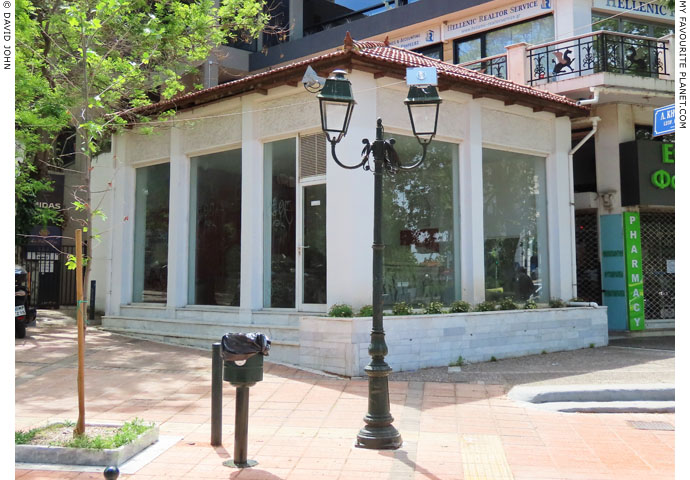
The small modern building constructed to house the sarcophagi
on the corner of Kifissias Avenue and Kassaveti Street, Kifissia.
|
The "Roman tomb monument" in Kifissia, on the corner of Kassaveti Street and the busy Kifissias Avenue, about 10 minutes walk from the metro station. Between the station and Kifissias Avenue is the Alsos Kifisias (Kifissia Woods) public park, named after a former mayor, Dimitri Zomopoulos. The street along one side of the park is named Adrianou, after Emperor Hadian, and along the other side is Irodou Attikou Street, named after Herodus Atticus. As usual in Greece, streetnames use the genitive case, so that this street is called the street of Herodus Atticus.
Standing next to a pharmacy, the small modern building with large windows resembles a shop. It houses the four large sarcophagi, but as can be seen from the old stone wall at the back of the building and the uneven stone floor within, it has been built over the ancient tomb. It is normally locked, and presumably it can only be entered by appointment, although there is no sign informing the public how this might be achieved. From its dusty windows and interior it appears that nobody has been in there for years.
The reflections on the windows make it almost impossible to see inside the dark, unlit single room. There is an information board inside, with a reconstruction drawing of the tomb (see below) and a short description of the "Roman funerary monument" in Greek and English. But it is inside, on the far wall, and is impossible to read without a telescope or zoom lens.
The tomb is dated to the 2nd century AD, "probably belonging to a family related to Herodus Atticus". It consisted of a square, paved chamber with a vaulted roof, and was originally intended for three sarcophagi.
Nearby is a small outside area surrounded by metal railings in which have been placed several ancient stone architectural members, presumably related to the tomb.
A couple of hundred metres away, at the other end of Kassaveti Street, on the corner of Georganta Street, stands a house containing the Archaeological Collection of Kifissia. This small museum is also closed, and appears to have been so for some years. However, there is a plaque at the gateway with a telephone number. |
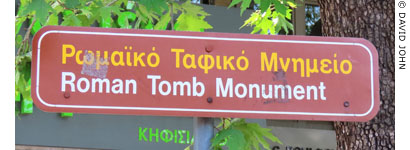
A brown cultural sign near the building
marked as a "Roman tomb monument". |
| |
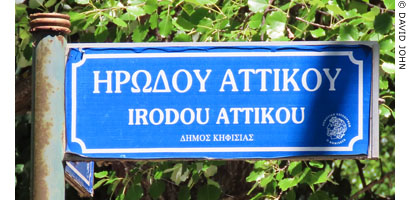
Irodou Attikou Street, Kifissia. |
| |
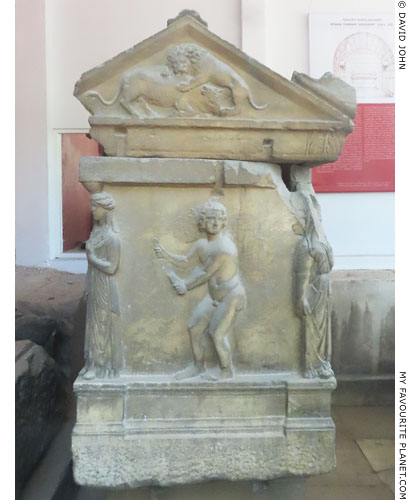
The right side of the "Leda sarcophagus" in Kifissia,
with a relief of Eros and a "Caryatid" at each corner.
The marble lid, with a relief of a lion attacking a bull
on the pediment, does not belong to the coffin. |
| |
| |
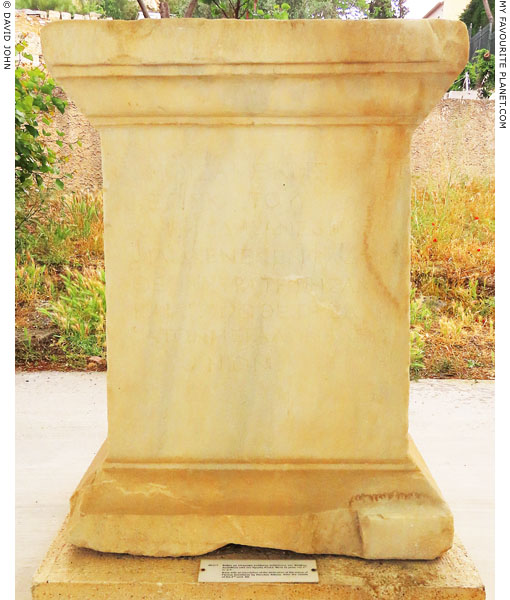
The marble base of a statue of Flavius Dorotheus (Φλάβιος Δωρόθεος) of
Marathon, formerly a general and agonothetes (ἀγωνοθέτης, president
or judge in official competitions) of the festival of the Great Eleusinia.
The now faint inscription the front is a dedication by his friend Herodes
Atticus, which also states that the statue was granted by a decree of
the Polis (city) and Demos (people) of Athens. 156/7 or 157/8 AD.
ψηφισαμένης τῆς πό-
λεως καὶ τοῦ δήμου
Κλ Ἡρώιδης ἀνέθηκεν
φιλίας ἕνεκεν Φλ Δωρό-
θεον στρατηγήσαντα
καὶ ἀγωνοθετήσαν-
τα τῶν μεγάλων Ἐλευσι-
νίων.
Inscription IG II² 3605 at The Packard Humanities Institute.
Theatre of Donysos, Athens. Inv. No. NK 277. |
| |
Herodes
Atticus |
Herodes Atticus and the Iobacchoi |
|
 |
|
| |
 |
|
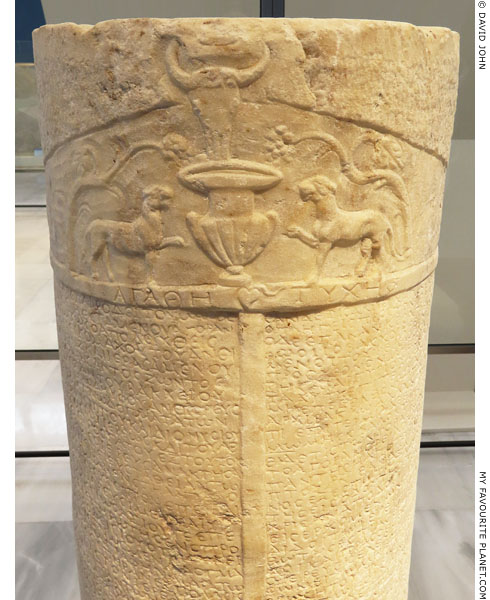 |
A cylindrical marble column inscribed with the regulations of the Iobacchoi
(Ιόβακχοι; a variant on Bacchoi, Βάκχοι, devotees of Bacchos), an association
of worshippers of Dionysus in Athens, for which Herodes Atticus was the priest.
164/165 AD, Roman Imperial period, during the reign of co-emperors Marcus
Aurelius and Lucius Verus. Found to the west of the Athenian Acropolis, in
the apse of a Roman building between the Pnyx and the Areopagus.
Athens Epigraphical Museum. Inv. No. EM 8187.
Inscription IG II² 1368 at The Packard Humanities Institute (PHI).
The long inscription is divided into two columns, taking up most of the height of the front half of the cylindrical stone. The top sixth is taken up by a relief of a triangular space resembling the pediment (gable) of a building, crowned by a bull's head over a large wine vessel. At either side of this stands a panther, facing centre, with one forepaw raised. The two cats are mirrored in heraldic symmetry. From behind each animal a vine rises and bends over towards the centre.
The text is formulated rather like an official decree, announcing a summary of an assembly: the date, principal persons present, one or more proposals for the laws or regulations to be passed and published in the form of an inscription. We learn that this publication in stone is the result of an assembly of the Iobacchoi on the eighth day of the month of Elaphebolion, in the year in which Arrius Epaphroditos (Ἀρρίος Ἐπαφροδείτοs) was eponymous archon in Athens (i.e. 164/165 AD).
For some reason not explained, Aurelius Nikomachos (Αὐρηλίοs Νεικομάχοs), "who had served as vice-priest for seventeen years and as priest for twenty three years", decided to resign in favour of Claudius Herodes ("τῷ κρατίστῳ Κλα(υδίῳ) Ἡρώδῃ"), presumed to be a reference to Herodes Atticus. Thus, around five years after his wife's death, Herodes gained yet another position of honour and cultural influence to add to those held by himself and members of his family. Aurelius was to continue to serve the association as vice-priest.
The assembly then voted unanimously by the raising of hands to ratify and publish the association's regulations, as proposed by its president (πρόεδρος, proedros), Rufus son of Aphrodisios (Ῥοῦφος Ἀφροδεισίου). These rules governed admission of new members, conduct at meetings, costs for membership fees and fines for bad conduct, the appointment of officers such as the treasurer, as well as the frequency of meetings, which are also referred to as banquets. The priests were to appoint bouncers, known as "horses" (ἵπποι), to eject drunken troublemakers from the banqueting hall.
The Iobacchoi appear to have at least played a part in organizing the funerals of deceased members, since those who attended them were to be provided with "a wreath worth up to five denarii and a single jar of wine". It was made clear, however, that any member who did not turn up to such a funeral would receive no wine.
You can read the complete inscription in Greek with an English translation in:
[7] Regulations of the Iobacchoi (164/165 CE) at philipharland.com. |
|
| |
Herodes
Atticus |
Herodes Atticus' final years |
|
 |
|
| |

A marble stele inscribed with an official letter
(generalis epistula) of Emperor Marcus Aurelius
announcing his decisions concerning various
judicial matters between prominent Athenians
who had appealed to him for settlement,
including accusations made against Herodes
Atticus by his rivals and enemies. Herodes was
tried by the emperor at Sirmium, Pannonia.
174/175 AD.
Athens Epigraphical Museum.
Inv. No. EM 13366.
Inscription: Hesperia Supplement XIII.
American School of Classical Studies
at Athens (ASCSA), 1970. |
| |
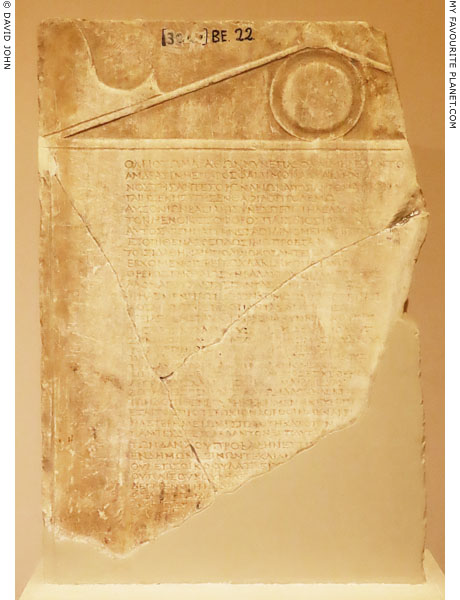
A marble stele inscribed with a poem in Homeric style commemorating
the extravagant welcome given by the Athenians to Herodes Atticus
on his return to Athens, probably in AD 175, after a long absence due
to litigation against him by rivals in Athens and his trial at Sirmium. For
a while afterwards he stayed at Orikon, Epirus, due to exile or illness.
2nd century AD. Found at Marathon.
Marathon Archaeological Museum. Inv. No. BE 22.
The stele is crowned by a pediment (gable) with a round shield at the centre. Only the top left part part of the monument has survived, and much of the text is now missing. But it seems that the Athenians had come to regret the disputes they had with him, and the entire city went to greet his arrival at the lake at the mouth of the Rheitoi streams (today known as Lake Koumoundourou, see Demeter and Persephone part 1), along the Sacred Way from Eleusis to Athens.
Herodes formed a grand procession, led by a statue of Dionysus, with the epithet Eiraphiotes (Εἰραφιώτης), followed by statues of Demeter and Persephone. This was met by the Athenian procession headed by a statue of Athena, followed by long-haired priests, a statue of Aphrodite and priestesses, famous boy singers chanting hymns to Olympian Zeus, ephebes in white cloaks fastend with pin of electrum (an alloy of gold and silver), paid for by Herodes himself, then came the boule (council) of the Areopagos, the boule of the Five Hundred, and finally the other residents of the city, Athenians, metics (foreign residents) and slaves. |
ὄλβιος, ὦ Μαραθών, νῦν ἔπλεο, καὶ μελεδαντός
ἀνδράσιν ἠὲ πάρος, φαίδιμον Ἀλκαΐδην
νοστήσαντ’ ἐσορῶν ἀβίων ἀπὸ Σαυροματάων
γαίης ἐκ νεάτης, ἔνθα φιλοπτολέμῳ
Αὐσονίων βασιλῆι συνέσπετο τῆλ’ ἐλάοντι.
τὸν μὲν ὁ κισσοφόρος παῖς Διὸς ἱρέα ὃν
αὐτὸς ἄγεν πάτρην ἐς ἀοίδιμον Εἰραφιώτης,
ἐξόπιθεν δὲ θεὼ δωσιβίω πρόεσαν.
τοῖσι δ’ Ἀθηναίη πολιήοχος ἀντεβόλησε
ἐρχομένοις Ῥειτώ, Χαλκιδικὼ ποταμώ,
Θρειῶζ’, ἔνθ’ ἁλίω συμβάλλετον οἶδμα ῥόος τε,
λαὸν ἄγουσα ἔτας πάντας ὁμηγερέας,
ἱρῆας μὲν πρῶτα θεῶν κομόωντας ἐθείραις
κόσμῳ τῷ σφετέρῳ, πάντας ἀριπρεπέας,
ἱρείας δὲ μεταῦθι σαόφρονα Κύπριν ἐχούσας,
τῇς δ’ ἔπι κυδαλίμους παῖδας ἀοιδοπόλους
Ζηνὶ θεηκολέοντας Ὀλυμπίωϊ μασικύδρους,
τοῖσι δ’ ἔπ’ ἠϊθέους ἵστορας ἠνορέης,
παῖδας Ἀθηναίων χαλκῷ γανάοντας ἐφήβους,
τοὺς αὐτός, λήθην πατρὸς ἀκειόμενος
Αἰγείδεω, λώβης δ<ν>οφοείμονος ἔσχεθε κούρο[υς]
ἀργυφέαις χλαίναις οἴκοθεν ἀμφιέσας,
δωρηθεὶς γ’ ἐνετῇσι κατωμαδὸν ἠλέκτροιο.
τῶν δ’ ὄπιθεν βουλὴ κεκριμένη Κεκρόπων
ἔξαιτος προτέρω κίον ἀθρόοι, ἡ μὲν ἀρείω[ν],
ἡ δ’ ἑτέρη μείων ἕσπετο τῇ κατόπιν.
πάντες δ’ ἐστολάδαντο νεόπλυτα φάρ[εα λευκά]·
τῶν δ’ ἀνχοῦ προβάδην ἔστιχ[εν ἄλλος ὄχλος]
ἐνδήμων ξείνων τε καὶ αι — —
οὐδέ τις οἰκοφύλαξ λείπ[ετ’ ἐνὶ μεγάροις]
οὐ παῖς, οὐ κούρη λευ[κώλενος, ἀλλ’ ἀγέροντο]
δέγμενοι Ἡρώδην — —
ὡς δ’ ὅτε παῖδα γε̣ — —
ἀμφιπέσῃ μή[τηρ — —]
τηλόθεν ἐ[ξ ἀπίης γαίης — —]
χαιροσύ[νῃ — —]
πλήν — —
ὦ[ρ]σ[ε? — —]
Inscription IG II² 3606. |
|
0 Happy Marathon, now people care about you much more than before, as you behold the illustrious Alkaides, who returned from Abia Sauromata at the ends of the earth, where he followed the commander, the polemarch king of the Ausonians.
And the ivy-wreathed son of Zeus, Eiraphiotes, himself led his priest to the famous fatherland. The two life-giving goddesses came behind. Athena the patron met them, as they were proceeding to the Rheitoi, to the two Chalcidian rivers in Thria, where the swollen sea unites with the flow. She led the assembled people; first the long-haired priests of the gods in official order, all resplendent, then the priestesses with the prudent Cypris (Aphrodite) in their midst; the renowned boy singers followed chanting hymns to Olympian Zeus.
Behind them came the new recruits, the valiant youths, sons of the Athenians, shimmering in bronze, the ephebes, which he, curing the forgetfulness of the father by Theseus, relieved the youths of the dark reproach and at his own (expense) clad them in white cloaks, presenting even fibulae of electrum for the shoulder.
Behind came the elected boule of the Kekropian, the exceptional, further on, gathered together, walked first the noblest; the inferiors followed them behind. All wore freshly laundered white himations; near them proceeded the other folk, locals and foreigners and [slaves]; no one remained behind as guardian of the houses, neither boy nor tender girl, but they gathered to welcome Herodes [- - - - -J as when the son [- - - - - - - -] the mother embraces [- - - - - - - - -] from a distant land [- - - - - - - - -] |
|
| |
Herodes
Atticus |
Notes, references and links |
|
 |
|
1. Herodes Atticus' full name
Various abbreviated forms of Herodes Atticus' name appear on many inscriptions, but only a few state his full name.
Λ Βιβούλλιο[ν Ἵππαρ]-
χον Τιβέρ[ιον Κλαύδιον]
Ἀττικὸν Ἡρώ[δην Μαραθώ]-
νιον τὸν ἄρ[χοντα].
L. Vibullius Hipparchus Tiberius Claudius Atticus Herodes of Marathon, archon.
Inscription IG II² 3603 at The Packard Humanities Institute.
Also a fragmentary epitaph for Herodes' second child and first daughter Elpinike, found at Kiffissia:
[Ἀππία Ἀννία Ἀτ]ειλία [Ῥήγιλλα Ἀγρ]ιππεῖ<ν>α Ἐλπι[νείκη] Ἀτρία Πῶλλα
[Λουκίου] [Οὐι]βουλλίου Ἱππάρχου Τιβε[ρίου] [Κλαυδί]ου Ἀττικοῦ Ἡρώδου Μαραθωνίο[υ] ...
The names have been reconstructed as:
Appia Annia Atilia Regilla Agrippina Elpinice Atria Polla
Lucius Vibullius Hipparchus Tiberius Claudius Atticus Herodes of Marathon ...
(usually rendered as Λεύκιος Βιβούλλιος Ἵππαρχος Τιβέριος Κλαύδιος Ἀττικὸς Ἡρῴδης Μαραθώνιος)
Inscription IG II² 12568/9 at The Packard Humanities Institute. |
|
|
2. Alkia, mother of Herodes Atticus
Several Romans living in Greece around this period with the name Vibullius are believed to be relatives of Alkia, Atticus and their son Herodes. Attempts have been made to construct family trees to connect the known individuals.
Alkia is referred to in inscriptions as the wife of Tiberius Claudius Atticus Herodes, who was previously taken to be Herodes Atticus. She was therefore thought to be Herodes' first wife, and believed to have died in childbirth.
See, for example: Helen McClees, A study of women in Attic inscriptions, pages 9-10 and 16. Columbia University Press, New York, 1920.
The couple are now seen as his parents. See, for example an inscription IG III 674, on the base of a statue of Alkia dedicated by the tribe Pandionis:
Wilhelm Dittenberger (editor), Inscriptiones Graecae, Volume 3, part 1 (Voluminis tertii pars prior), Inscriptiones Atticae aetatis Romanae, No. 674, page 140, but also Addenda et corrigenda, page 499. George Reimer, Berlin, 1878. At the Internet Archive.
The subject of Herodes' "first wife" appears to have disappeared from more recent scholarship, although it is often remarked that he married Regilla at the relatively late age of 40. |
|
|
3. Philostratus on Herodes Atticus
Lucius Flavius Philostratus (Λούκιος Φλάβιος Φιλόστρατος) is often referred to as Philostratus "the Athenian" to distinguish him from other ancient authors named Philostratus. He may have been a member of a family of professional Sophists from the island of Lemnos in the northeastern Aegean. He was a member of the Second Sophistic (Δεύτερα σοφιστική), a philosophical and cultural movement which flourished from the 1st century AD to around 250 AD. The dates of his life are unknown, but he is thought to have lived between 160/170 and 244/250 AD, and to have studied and taught in Athens before going to live in Rome. It has been suggested that he may have attended a rhetorical performance by Herodes Atticus or even been at his funeral.
The lives of the Sophists (Βίοι Σοφιστών), known in Latin as Vitae Sophistarum, is thought to have been written in the 230s or 240s AD, according to other opinions between 231 and 237 AD. The biography of Herodes Atticus appears in the first section of Book II, referred to as Section a or Section 1, depending on the modern edition.
Quotes and references by Philostratus concerning Herodes Atticus and the Odeion are taken from:
Philostratus and Eunapius; The lives of the Sophists, Philostratus, Book II, chapter 1 (sections 545-566), pages 138-183 (also references to Herodes on following pages and in the introduction). Loeb Classical Library edition, in ancient Greek and English, translated by William Cave Wright. William Heinemann, London and G. P. Putnam's Sons, New York, 1922. At the Internet Archive.
See also:
Joseph L. Rife, The burial of Herodes Atticus: Élite identity, urban society, and public memory in Roman Greece. Journal of Hellenic Studies, Volume 128 (2008), pages 92-127. At academia.edu.
Jennifer Tobin, Some new thoughts on Herodes Atticus's tomb, his stadium of 143/4, and Philostratus VS 2.550. American Journal of Archaeology Volume 97, No. 1 (Jan., 1993), pages 81-89. Archaeological Institute of America. At jstor.org.
Frederick William Faber, A biographical notice of Atticus Herodes, prefect of the free cities of Asia. Davison, Simmons, 1832. E-book at googlebooks. To modern readers this may seem more like an uncritical sermon in praise of Herodes Atticus than a historical appraisal of his life and achievements. |
|
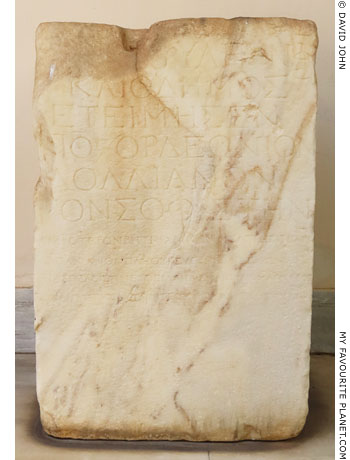
An inscribed marble base for a statue set up by
the Council of the Five Hundred and the Demos
of the Athenians in honour of the Sophist
Poplius Ordeonius Lollianus from Ephesus.
Mid 2nd century AD.
Epigraphical Museum, Athens. Inv. No. EM 466.
Inscription IG II² 4211. |
|
|
4. Inscriptions mentioning Herodes Atticus discovered in the 17th century
Jacob Spon and George Wheler, who travelled through Italy to Greece, Constantinople (Istanbul) and the Levant in 1675-1676, recorded discoveries of inscriptions mentioning Herodes Atticus and Annia Regilla, including two found at Rome at the beginning of the 17th century. Wheler provided drawings and translations of two inscriptions from Athens, one dedicated by the tribe of Antiochis (Ἀντιοχίς) and the other by the demos, for his "munificence and good will" respectively "to his country" and "to the city".
See: George Wheler, A journey into Greece in the company of Dr Spon of Lyons, Book V, pages 375-377. Cademan, Kettlewell and Churchill, London, 1682. At googlebooks.
The dedication by the Antiochis tribe was also mentioned in a note to the second edition of Stuart and Revett's The antiquities of Athens.
"The following inscription, seen at Athens, on a pedestal, which probably bore a statue of him.
The tribe of Antiochis have
dedicated this to the Priest
of the Caesars, Tiberius Claudius
Atticus Herodes, the Marathonian,
on account of his benevolence
and beneficence to his country."
James Stuart and Nicholas Revett, The antiquities of Athens, measured and delineated, Volume II, Chapter III, page 77. Priestley and Weale, London, 1825. At Heidelberg University Digital Library.
5. Cassius Dio on the education of Marcus Aurelius
"His education was of great assistance to him, for he had been trained both in rhetoric and in philosophical disputation. In the former he had Cornelius Fronto and Claudius Herodes for teachers, and, in the latter, Junius Rusticus and Apollonius of Nicomedeia, both of whom professed Zeno's doctrines."
Cassius Dio (Δίων Κάσσιος, circa 155-235 AD), Roman History, Book 72, chapter 35, section 1.
At Bill Thayer's LacusCurtius website, University of Chicago. |
|
|
|
6. Herodes Atticus and the cult of Antinous
A bust of Antinous (Inv. No. 173) was found in 1977 at the Villa of Herodes Atticus, near Loukou, and the torso of a sitting statue of Antinous was discovered there in September 1996. Both are in the Archaeological Museum of Astros (see above).
Herodes Atticus built the sanctuary of Isis and Osiris on a man-made islet at the edge of the small marsh of Brexiza (Αιγυπτιακό ιερό στην Μπρεξίζα, the Egyptian Temple at Brexiza), near Marathon, Attica, in which was found an Egyptianizing statue of Antinous as the Egyptian god Osiris. National Archaeological Museum, Athens. Egyptian Collection. Inv. No. 1. It has been pointed out that the face of this statue does not resemble other portraits of Antinous, and it has been suggested that it may represent one of the adopted sons of Herodes Atticus, perhaps Achilles or Polydeukes.
7. Portrait bust of Herodes Atticus
This is one of the best preserved portraits of Herodes Atticus. Another is also a draped bust, dated around 161 AD, found in 1789 by Louis-François Sébastien Fauvel near Marathon, now in the Louvre. Also found there were portrait busts of Marcus Aurelius (Louvre, Inv. No. Ma 1161) and joint emperor Lucius Verus (Ashmolean Museum, Oxford, Inv. No. AN 1947.277).
Marble draped bust of Herod Atticus, circa 161 AD.
Height 62 cm.
Louvre Museum, Paris. Inv. No. Ma 1164 (NIII 2536).
Another, similar draped bust, with missing left shoulder, is in the Basel Antikenmuseum, Switzerland. Inv. No. BS 289.
8. The chronology of Herodes Atticus
The chronological table above is partly based on Klaus Jansen's PhD dissertation (see below).
All dates given on this page are based on several sources, some of which have been cited, none of which are definitive. Some dates for buildings and archaeological artefacts generally follow museum labelling and literature, which are based on various theories concerning the dates of events in the life of Herodes Atticus, his family and other people connected with him.
Several scholars have wrestled with the problems concerning the chronology, attempting to correlate mentions by ancient authors (Philostratus, Pausanias, Lucian, Aulus Gellius, Marcus Cornelius Fronto, Cassius Dio) with archaeological evidence, including the large numbers of inscriptions, buildings and artworks directly or indirectly concerned with them, as well as the dates (known, deduced or assumed) for other contemporary events and personalities, including emperors, archons, philosophers and other prominent Greeks and Romans. Attempts have also been made to unravel the knotted threads of genealogies and relationships within and between various families, made even more complicated by adoptions, marriages between close relatives, individuals with similar names and much missing information.
In this case such research has led to several complex calculations and theories. Paul Graindor (1877-1938) wrote key articles on the subject, but although many of his conclusions have since been challenged by a number of scholars, some are still being used in publications.
It may seem surprising that so many questions remain unanswered concerning the biography of a man often described as "famous" or "infamous", and who has left so much evidence of his activities, public, family and personal life. However, this is an excellent illustration of the uncertainties of history in general. Many books, articles and films tell us that a certain person or persons did something at some particular date. But a little research often reveals that such solid-seeming "facts" are the results of speculative theories and interpretations of available evidence, many depending on other theories sometimes concerning other events, personalities and places. In turn such "facts" are used to construct further theories. This may lead to the building of a house of cards, the removal of one card from which may threaten the collapse of the entire edifice. Modern historians are aware of this, and most apply rigorous caution and restraint when examining evidence.
New archaeological evidence concerning Herodes Atticus is still being discovered, and the older theories continue to be reappraised.
See, for example:
Wilhelm Dittenberger (1840-1906), Die Familie des Herodes Atticus. In: Hermes, Zeitschrift für classiche Philologie, dreizehnter Band (Volume 13), pages 67-89. Weidmannsche Buchhandlung, Berlin, 1878. At the Internet Archive.
Paul Graindor (1877-1938), Un milliardaire antique: Hérode Atticus et sa famille. Imprimerie Misr, Societe Anonyme Egyptienne, Cairo, 1938. Available as a PDF at Gallica, Bibliothèque nationale de France.
Also available as HTML pages: Hérode Atticus et sa famille. At mediterranee-antique.fr.
Walter Ameling, Herodes Atticus, in two volumes: Band I, Biographie (Biography); Band II, Inschriftenkatalog (Catalogue of inscriptions). Georg Olms, Hildesheim, 1983.
Jennifer Tobin, Herodes Attikos and the City of Athens: Patronage and Conflict under the Antonines. ΑΡΧΑΙΑ ΕΛΛΑΣ 4. J. C. Gieben, Amsterdam, 1997.
Klaus Jansen, Herodes Atticus und seine τρόφιμοι. PhD dissertation, University of Münster, Westphalia, 2006. PDF document at the University of Münster. Dealing mainly with portraits of Herodes Atticus and his adopted sons, the thesis also examines literary and epigraphical evidence as well as modern scholarship. Illustrated, with bibliography and an attempt at a chronology of Herodes' life and career (pages 22-25).
9. Inscription on the Regilla-Tyche statue base in Corinth
Like the other inscribed statue base found at Corinth (see above), the inscription praises Regilla's sophrosyne (σωφροσύνη), a word that has been variously translated as excellence of character and soundness of mind, moderation, prudence, chastity ... It addresses Regilla as if she was Tyche and states that the statue was set up in front of a sanctuary, which has been taken to be that of Tyche.
Although the base has been dated around 143-160/161 AD, during Regilla's lifetime or shortly after her death, the quality of the lettering has been described as "decadent", "slipshod" and "clumsy" *, which would have been unacceptable to Herodes Atticus. The inscription has thus been dated to the mid 3rd century AD or later, which has led to suggestions that the base was reinscribed and the monument maintained long after the deaths of Regilla and Herodes.
[Ῥηγίλλας τ]όδ’ ἄγαλμα. φυὴν δ’ ἐχάραξε τεχνείτης
[πᾶσαν σ]ωφροσύνην ἐς λίθον ἀραμένην.
[Ἀττικ]ὸς Ἡρώδης μέγας ὤπασεν, ἔξοχος ἄλλων,
[παντ]ο̣ίης ἀρετῆς εἰς ἄκρον εἱκόμενος,
[ὃν π]ό̣σιν Ἑλλήνων ἔλαχεν περίβωτον ἁπάντων
[κρέσ]σ̣ον̣α δ’ αὖτε π<ά>ϊν ἄνθος Ἀχαιϊάδος.
[Ῥηγίλ]λ̣α̣, ἡ βουλή σε Τύχην ὡς εἰλάσκουσα,
[εἰκόνα π]ρ<ὸς> τεμένι στήσατο λαϊνέην.
This is a statue of Regilla. An artist carved her nature
extolling all of her moderation (sophrosyne) in stone.
It was given by Herodes Atticus the Great, whom she took as a companion.
He stands out from all others in all virtues,
much talked about among the Hellenes.
a most excellent son (of Greece), the flower of Achaia.
O Regilla, the Boule as if calling you Tyche,
has set up your statue before the sanctuary.
Corinth Archaeological Museum. Inv. No. I 1658.
Inscription Corinth 8, 3 128 (also SEG 13.226).
John H. Kent (editor), Corinth VIII, 3. The Inscriptions 1926-1950. Princeton, 1966.
* See: Andrea Toma, Le iscrizioni poetiche relative a Erode Attico: testo rivisto, traduzione e commento, pages 28-29. PhD thesis, Albert-Ludwigs-Universität, Freiburg, 2008. PDF in Italian at FreiDok plus, University of Freiburg. |
|
|
|
10. Letters written by Marcus Aurelius and Marcus Cornelius Fronto
Like Herodes, Marcus Cornelius Fronto had been a tutor of Marcus Aurelius [see note 5]. The two men had been adversaries but later became friends. As a closing remark in a letter written (perhaps around 143-144 AD) to Fronto, Marcus Aurelius informs him of Herodes' overwhelming grief at the death of a son. Since the death occurred on the day the letter was written, it seems that Herodes and Regilla were in Rome at this time.
"The son of Herodes, born today, is dead. Herodes is overwhelmed with grief at his loss. I wish you would write him quite a short letter appropriate to the occasion. Fare ever well."
A letter written by Fronto appears to be to Herodes as a consolatio (letter of consolation) in response to Marcus Aurelius' request.
Charles Reginald Haines (editor), The correspondence of Marcus Cornelius Fronto with Marcus Aurelius Antoninus, Lucius Verus, Antoninus Pius, and various friends, Volume 1 (of 2), Marcus Aurelius to Fronto page 162, Fronto to Herodes pages 169-170. Loeb Classical Library edition. Harvard University Press, Cambridge, Mass. and W. Heinemann, London, 1919. At the Internet Archive.
11. Triopas
As is often the case in Greek mythography, the accounts by ancient authors concerning the mythical Thessalian hero Triopas (Τρίωψ or Τριόπας, Three Faces) and his genealogy vary considerably. According to some he was son of Poseidon and Kanake, and founded Knidos, Caria (Diodorus, 5.57.6 and 5.61.2), where the city's island Triopion (today the Datça peninsula) was named after him, and where there was a famous sanctuary of Demeter (see the "Demeter of Knidos" statue). Either he or his son Erysichthon (Ερυσίχθων, Earth Tearer) desecrated the sanctuary of Demeter and was punished by the goddess with insatiable hunger and by being plagued by a snake. Eventually Demeter transformed him and the snake into the constellation Ophiuchus (Ὀφιοῦχος, Ophiouchos, Serpent Bearer *) as a reminder to others of his crime and punishment. Herodes Atticus may also have chosen the name Triopion as a warning to trespassers and thieves.
Pausanias reported that the Knidians set up a statue of Triopas, "founder of Knidos", with a horse at Delphi. Pausanias, Description of Greece, Book 10, chapter 11, section 1. At Perseus Digital Library.
* One of many myths to explain the origin of this constellation. Others associated it with Apollo, Asklepios and Laocoon.
12. The statue of Dionysus found at the Triopion
According to the 1812 British Museum catalogue, the statue found at the Triopion at the same time as the carytids was of the Dionysos-Sardanapalos type.
"In the year 1766, three other female figures, of the same size and subject as the present, were found nearly in the same place, together with a statue somewhat larger, representing the bearded, or Indian Bacchus. Piranesi, who was at the time was on the spot, was of the opinion that these caryatides had supported the portico of a small temple, of which he observed several fragments belonging to the pediment, the frieze, the cornice, and the architrave of the door, together with a piece of a large bas-relief, which he supposed had occupied the centre of the pediment. He has published in his works a representation of this portico, according to the idea which he formed of it. [Raccolta di vasi antichi, tom. ii. tav. 68]
The statue of Bacchus having been found in the same spot with the caryatides, renders it probable that the temple was dedicated to that deity. Winckelmann, however, is of the opinion, that, as the Appian way was on both sides ornamented with tombs, these architectural statues might have been made use of to decorate the sepulchre of some opulent Roman. [Winckelmann, Hist. de l'art chez les anciens, tom. ii. p. 378]
The statue of Bacchus formerly stood in the Vatican, but it is now in the French Collection. On the drapery across the breast is the Greek word ΣΑΡΔΑΝΑΠΑΛΛΟΣ."
Taylor Combe (editor), A description of the collection of ancient marbles in the British Museum, Part 1, Plate IV (the text is on the pages following the plate, but they are not numbered). Longman, Hurst, Rees, Orme and Co., London, 1812.
13. Olga Palagia on "Herodes Atticus' Athenian Caryatids"
See: Olga Palagia, Herodes Atticus' Athenian Caryatids, in ΑΡΧΙΤΕΚΤΩΝ, Honorary volume for Professor Manolis Korres, edited by C. Zambas et al., pages 217-224. Athens 2016. At academia.edu.
14. Dedicatory inscriptions for Herodes Atticus and Claudia Athenais
IG III 664 and IG III 665. See:
Wilhelm Dittenberger (editor), Inscriptiones Graecae, Volume 3, part 1 (Voluminis tertii pars prior), Inscriptiones Atticae aetatis Romanae, Nos. 664 and 665, page 139. George Reimer, Berlin, 1878. At the Internet Archive.
Some scholars have believed that the inscription refers to an older sister of Atticus (Herodes Atticus' father), also named Claudia Athenais.
Paul Graindor argued that this inscription must refer to Atticus and his older sister (Herodes Atticus' father and aunt), rather than Herodes and his daughter, on the grounds that the Boule of the 600 had been reduced to 500 members by 124/125 AD ("or 128/9 at the latest"). He also pointed out that the "Tib. Claudius Atticus Herodes of Marathon" in the inscription is described as a high priest of the imperial cult for life, an office held by Atticus until the end of the reign of Hadrian. Referring to the marble slab as a statue base, Graindor wrote: "If Athenais was supposed to be Atticus' older sister, it is because her statue was placed to the left of his, that is to say, she occupied the place of honour on the common base."
Paul Graindor, Un milliardaire antique: Hérode Atticus et sa famille, chapter 2, page 19. Imprimerie Misr, Societe Anonyme Egyptienne, Cairo, 1938. Available as a PDF at Gallica, Bibliothèque nationale de France.
Herodes is also thought to have had a grandaughter or great granddaughter named Athenais. |
|
|
|
15. Herodes' aqueduct and the water supply at Olympia
The first studies of Olympia's water supply were written by the German architect Friedrich Graeber (1848-1917) for the reports of the German archaeological campaign 1892-1896.
See: Ernst Curtius, Friedrich Adler (editors), Olympia: die Ergebnisse der von dem Deutschen Reich veranstalteten Ausgrabung, Textband II: Die Baudenkmäler. A. Asher & Co., Berlin, 1892. At Heidelberg University Digital Library.
The volume includes the following relevant articles:
Friedrich Adler, XXV. Exedra des Herodes Atticus,
pages 134-139, Tafel LXXXIII-LXXXVI;
Friedrich Graeber, XXVI, Therme am Kladeos,
pages 139-140, Tafel LXXXVII;
Friedrich Graeber, XXXIV, Die Wasserleitungen,
pages 170-180, Tafel CI-CIV.
The Kladeos (Κλάδεος) river is a tributary of the Alpheios (Αλφειός). It flows north to south through a channel below the level of the west side of the area of the Sanctuary of Zeus in Olympia, before merging with the Alpheios, which flows from east to west along the southern edge of the site. It was diverted and channelled in antiquity to control the water supply and prevent flooding in winter. As can be seen from the photo, right, taken in August 2018, the Kladeos sometimes remains a substantial stream in summer. Water from the Alpheios was apparently not drinkable.
The first baths at Olympia are thought to have been built near the Kladeos in the 5th century BC. The Leonidaion (Λεωνίδαιον), the largest building in Olympia, financed by Leonidas of Naxos and built around 330 BC as a residence for official guests, was rebuilt and enlarged during the reign of Hadrian. In its inner courtyard was an artificial pool in which rainwater and water from the Kladeos was treated and stored. At its centre was an island on which stood a well. It has been estimated that the facility could supply water for 800 people during the five-day Olympic Games.
See: Efstathia Odysseos Valiantza, Examples of environmental engineering infrastructure works from Greek antiquity. In: John G. Dellis, Stephanos A. Paipetis (editors), The Influence of Hellenic philosophy on the contemporary world, pages 243-245. Cambridge Scholars Publishing, Newcastle upon Tyne, 2019.
So far I have found little detailed information about the aqueduct that fed the Nymphaeum at Olympia, its history, construction or materials. Most of the modern sources I have seen are quite vague on the subject, which suggests that the archaeological evidence has not been discovered or thoroughly researched. Some sources state that it was 4 km long, while others say 2 miles (3.2 km). It appears to have been a pipe conduit, perhaps of stone, which ran for at least part of its course underground. According to Graeber and others water was brought from the valley of Miraka (Μιράκα), a village today known as Archea Pisa (Αρχαία Πισα, Ancient Pisa), 4 km east of Olympia. One or more springs are usually mentioned vaguely as the water source(s).
"The nymphaeum was a monumental termination of an aqueduct, which brought fresh spring water from a southwestern spur of Mt. Erymanthus to the north side of the Altis.
The water came from the side valleys of the Alpheus and was carried by an aqueduct (a pillar of which still stands near Miraka, about two miles from Olympia) and by a tunnel through the Hill of Kronos to a reservoir just north of the treasuries."
Harry Carracci Rutledge, Herodes Atticus: world citizen, AD 101-177, 17. The Nymphaeum at Olympia, pages 124-126. PhD thesis, Ohio State University, 1960.
It should noted that the southwestern side of Mount Erymanthos (Ερύμανθος) is in the northeast of Elis, and lot further than 4 km from Olympia.
The rhetorician and satirist Lucian of Samosata (Λουκιανὸς ὁ Σαμοσατεύς, circa 125 - after 180 AD; see the note on the Ateion page), a contemporary of Herodes Atticus, wrote that the Cynic philosopher Peregrinos Proteus (Περεγρῖνος Πρωτεύς, circa 95-165 AD), while at Olympia criticized Herodes Atticus (Lucian does not mention his name) whose water supply (the Nymphaeum) "prevented the visitors to the festival from dying of thirst". Peregrinos claimed that such a luxury made the Greeks effeminate, for which he was almost stoned to death by the crowds attending the games.
"Coming at last to Greece under these circumstances, at one moment he [Peregrinos] abused the Eleans, at another he counselled the Greeks to take up arms against the Romans, and at another he libelled a man outstanding in literary attainments and position because he had been a benefactor to Greece in many ways, and particularly because he had brought water to Olympia and prevented the visitors to the festival from dying of thirst, maintaining that he was making the Greeks effeminate, for the spectators of the Olympic games ought to endure their thirst - yes, by Heaven, and even to lose their lives, no doubt, many of them, through the frequent distempers which formerly ran riot in the vast crowd on account of the dryness of the place! And he said this while he drank that same water!
When they almost killed him with stones, mobbing him with one accord, he managed to escape death at the moment by fleeing to Zeus for sanctuary (stout fellow!), and afterwards, at the next Olympiad, he gave the Greeks a speech which he had composed during the four years that had intervened, praising the man who had brought in the water and defending himself for running away at that time."
Lucian of Samosata, The passing of Peregrinus (Περὶ τῆς Περεγρίνου Τελευτῆς; Latin, De Morte Peregrini), sections 19-20. In: Austin Morris Harmon (translator), Lucian, Volume V (of 8), pages 20-23. Loeb Classical Library edition (in Greek and English). Harvard University Press, Cambridge, Mass. and W. Heinemann, London, 1936. At the Internet Archive.
Philostratus also mentioned the Cynic philosopher Proteus' continual insults of Herodes Atticus and his self-immolation at Olympia, and quotes Herodes' pithy riposte to the irksome Cynic. Philostratus, The lives of the Sophists, Book II, sections 563-564, pages 176-177, see note 3).
Peregrinos' attack on Herodes Atticus is thought to have occurred at the Olympic Games of either 153 AD or 157 AD, and his apparent change of heart at the next Olympiad, 157 AD or 161 AD. On the day after the end of the Olympic Games of 165 AD he publicly burnt himself to death in a pyre after delivering his own funeral oration.
In the notes to this edition (note 1, page 24) Harmon agreed with Paul Graindor's theory, estimated from the apparent ages of the statues of the children represented on the exedra, that the Nymphaeum was completed in 153 AD, and that Peregrinos made his speech criticizing Herodes Atticus during the Olympics of that year. He also maintained that the events reported by Lucian concerning Peregrinos occurred at four separate Olympics: 1. his attack on Herodes Atticus, 153 AD; 2. his contradictary praise of Herodes, 157 AD; 3. "... he devised this ultimate venture of the pyre, and spread a report among the Greeks immediately after the last [previous] Olympic games that he would burn himself up at the next festival" (Peregrinus, section 20), 161 AD; 4. his suicide, 165 AD.
See: Paul Graindor (1877-1938), Un milliardaire antique: Hérode Atticus et sa famille, pages 86-88. Imprimerie Misr, Societe Anonyme Egyptienne, Cairo, 1938. At Gallica, Bibliothèque nationale de France.
However, this theory is questionable on several grounds. Firstly, the Lucian's mention of the "last" (previous) and "next" Olympics is somewhat vague, and does not necessarily mean fours year had passed between events 2 and 3. Secondly, the identities and ages of the many of the individuals represented on the statues from the exedra are still far from certain, as are dates in which the statues were made and dedicated. Thirdly, Peregrinos' criticism of the Nymphaeum does not necessarily indicate that its construction was completed (or the statues installed) when he delivered his attack. Even today people protest against building projects (airports, road and railway schemes, luxury apartment projects...) from the time they are announced, and long before a stone has been laid (or concrete poured).
Lucian claimed to have been present at Peregrinos' suicide, which he said took place at Harpina (Ἁρπίνα), 20 stades (around 4 km) east of Olympia (Peregrinus, section 35). This is around the location of Archea Pisa (formerly Miraka), north of which are remains believed to be those of the ancient city. Strabo called Arpina (Ἆρπινα) one of the eight cities of Pisatis, a district of Elis, and wrote that the river Parthenias (Παρθενίας, thought to be river now called the Bakireiko, Μπακιρέικο) flowed through it (Geography, Book 8, chapter 3, section 32). Pausanias wrote that the ruins of the city Harpinna (Ἅρπιννα) stood on a river called Harpinates (Αρπινάτης ποταμός), and that the Parthenias was nearby (Description of Greece, Book 6, chapter 21, sections 6-8). Both rivers are thought to have been tributaries of the Alpheios. |
|
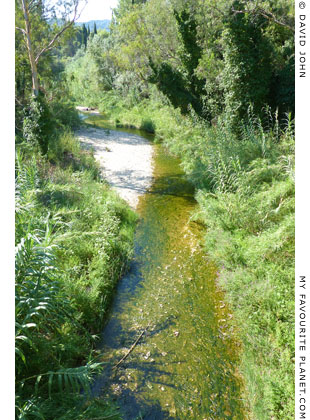
The Kladeos river flowing through Olympia,
west of the Sanctuary of Zeus. |
|
|
16. Monopteros
The form of a monopteros was defined by Vitruvius in his discussion on circular temples.
Vitruvius, On Architecture, Book 4, chapter 8. At Bill Thayer's LacusCurtius website, University of Chicago.
17. Philostratos on the temple of Canobus, near Marathon
Philostratos refers to the sanctuary as "τοῦ Κανώβου ἱερόν", translated here as "the temple of Canobus".
"On this Herodes admired him greatly and begged him to dine with him. 'Tomorrow,' replied Agathion, 'I will come to you at noon at the temple of Canobus, and do you have there the largest bowl that is in the temple full of milk that has not been milked by a woman.'"
Philostratus, Lives of the Sophists Book 2, Herodes the Athenian, section 554. In: Philostratus and Eunapius; The lives of the Sophists, pages 156-157. Loeb Classical Library edition, in Ancient Greek and English, translated by William Cave Wright. William Heinemann, London and G. P. Putnam's Sons, New York, 1922. At the Internet Archive.
18. Lucian on Herodes Atticus and Polydeukes
Lucian of Samosata included two anecdotes concerning Herodes Atticus' excessive mourning for the deaths of Polydeukes (Πολυδεύκης) and Regilla in his Life of Demonax (Δημώνακτος βίος), a biography of the Greek Cypriot Cynic philosopher Demonax (Δημώναξ, circa 70-170 AD), who lived in Athens and was a contemporary of Herodes.
Section 24. "When Herodes, the superlative, was mourning the premature death of Polydeuces and wanted a chariot regularly made ready and horses put to it just as if the boy were going for a drive, and dinner regularly served for him, Demonax went to him and said: 'I am bringing you a message from Polydeuces.' Herodes was pleased and thought that Demonax, like everyone else, was falling in with his humour; so he said: 'Well, what does Polydeuces want, Demonax?' 'He finds fault with you,' said he, 'for not going to join him at once!'"
Section 33. "Touching Herodes he remarked that Plato was right in saying that we have more than one soul, for a man with only one could not feast Regilla and Polydeuces as if they were still alive and say what he did in his lectures."
Demonax (Δημώνακτος βίος). In: Austin Morris Harmon (translator), Lucian, Volume I (of 8), section 24, pages 156-159 and section 33, pages 160-161. Loeb Classical Library edition (in Greek and English). Harvard University Press, Cambridge, Mass. and W. Heinemann, London, 1913. At the Internet Archive.
In Greek only, from the same edition: section 24; section 33. At Perseus Digital Library.
The translation by H. W. Fowler and F. G. Fowler (The works of Lucian of Samosata. Clarendon Press, Oxford, 1905) unhelpfully renders Πολυδεύκης as "Pollux". In many older translations of Greek texts, names are often presented by their Latin counterparts (Zeus as Jupiter, Athena as Minerva, etc). On the other hand, the Fowler translation is generally more lively and readable than Harmon's.
19. Portraits of Polydeukes
Karl Anton Neugebauer first presented his tentative identification of the sculpture type as a portrait of Polydeukes in a paper he delivered in 1931, noted in Archaeologischer Anzeiger, in: Jahrbuch des Deutschen Archäologischen Instituts, Volume 46, page 360. Walter de Gruyter, Berlin, 1931.
He subsequently wrote about the Polydeukes portraits and other artworks connected with Herodes Atticus in two articles.
K. Neugebauer, Herodes Atticus, ein antiker Kunstmäzen. In: Die Antike, 10, 1934, pages 99-100.
Entries in: P. Arndt and G. Lippold (editors), Griechische und römische Porträts, Lieferung 120, text to numbers 1198-1199. Munich, 1938.
So far I have not found these articles online, but see:
Elaine K. Gazda, A portrait of Polydeukion. In: Bulletin, Volume 3, pages 1-13. Museums of Art and Archaeology of the University of Michigan, 1980. At Googlebooks.
Gazda discusses the history of scholarship of Polydeukes portraits and various known examples. She pointed out that Polydeukes is "the most frequently represented youth of the 2nd century C.E. who was not in some way connected with the Roman imperial house". Apart from the portrait in Michigan (Inv. No. 74.6.1, now Inv. No. 1994.06.0001), which "ranks among the finest in artistic quality, expressive subtlety, and preservation", others she mentions include:
12 in Athens
Acropolis Museum, Inv. No. A30 and Inv. No. 2377;
Agora Museum Inv. No. S 224 (fragment of a head from the Agora) and a fragment mentioned by C. C. Vermeule and D. von Bothmer in Notes on a New Edition of Michaelis, Part II, American Journal of Archeology, Volume 60, 1956, page 343;
Benaki Museum, formerly in the A. Pallis collection;
National Archeological Museum, Inv. Nos. 579 (probably from the Asklepieion, Acropolis South Slope), 739, 3468, 4811 (see photo above), 3847 (head reused as a fountain spout at Moni Petraki, in storeroom), 5224 (from Astros?), Karapanos Collection Inv. No. Kar. 977/83 (slightly over-lifesize head, restored);
The portraits in Isthmia (2 heads), Corinth and Berlin (see photos above);
Astros Museum (A. Datsuli-Stavrides, Note on the iconography of Polydeukion, (in Greek) Athens Annals of Archaeology, Volume 10, 1977, page 143, note 27), Inv. No. 201, smaller than lifesize head from the villa at Loukou;
Chalkis, Euboea, New Archaeological Museum "Arethousa", Inv. No. MX 2179, high marble relief with a himation-clad bust and acanthus base, from an unknown location on Euboea (see photo above);
Florence, Palazzo Corsini al Prato (head on a modern bust);
London, Sir John Soane's Museum, Inv. No. M517, marble himation-clad bust on a narrow base, height 54 cm, with pedestal 65 cm, height of head 25 cm;
Marathon Archaeological Museum, Inv. No. BE12 (formerly in the National Archaeological Museum, Athens, Inv. No. 934) (see photo above;
Palermo, Antonino Salinas Regional Archaeological Museum, Inv. No. 951 (now N.I. 1520, head, height 26 cm, Parian marble, probably taken from Greece as part of the Fagan Collection, see Athens Acropolis gallery page 15);
Rome, Palazzo Barberini, an unpublished portrait, perhaps of Polydeukes, mentioned by C. C. Vermeule in American Journal of Archaelogy, Volume 58, 1954, page 255;
Trier, Welschbillig Herm No. 80.
Other portraits and fragments include:
Athens Acropolis Museum, mentions of heads, Inv. No. 2368 and Inv. No. 17965, may refer to heads listed under other numbers by Gazda;
Athens, National Archeological Museum, Inv. No. 14604, head, confiscated by police in Athens, findspot unknown; Inv. Nos. 850, 2144, 4913 and 5247 (see: Gilles Touchais, Chronique des fouilles et découvertes archéologiques en Grèce en 1978. In: Bulletin de Correspondance Hellénique, Volume 103, livraison 2, 1979, pages 527-615, particularly pages 527-528 and figs. 3-4. At Persée. The discovery of (the head in Isthmia is mentioned on pages 553-555, figs. 70-71);
Aphrodisias Archaeological Museum, Inv. No. 83-199, hair fragment of a male portrait found at the gate of the Agora in 1983;
Brauron Archaeological Museum, Inv. Nos. 1062, 1181, 1503, fragmented marble hero relief with a portrait of Polydeukes reclining;
Brindisi, Provincial Archaeological Museum, bronze statue from a shipwreck off Punta del Serrone:
Cambridge, Massachusetts, portrait bust of Polydeukes from the private collection of B. Rowland;
Ionnina Archaeological Museum, head on loan from a private collection;
Kassel, Museum Wilhelmshöhe Inv. No. Sk 30, bust;
London, Victoria and Albert Museum, bust (modern?);
Marathon Archaeological Museum, himation-clad bust on a narrow base;
Oxford, Ashmolean Museum, Inv. No. ANMichaelis 177, inscribed herm shaft (see photo above);
Rhamnous, Attica, excavation storerooms, headless bust from the sanctuary of Nemesis;
Saint Petersberg, Hermitage, "portrait of a Roman boy";
Tripolis (Peloponnese), Archaeological Museum, Inv. No. 21, fragmentary head found at the villa at Loukou in 1990.
The English clergyman and classicist Christopher Wordsworth (1807-1885), who travelled through Greece 1832-1833 (see Athens Acropolis page 4), reported a decree inscribed on a large stone slab found inside the ruins of the Temple of Nemesis at Rhamnous, Attica (the later, larger of two temples in the sanctuary). The Greek inscription refers to a portrait (ιδιων) of Polydeukes dedicated to Nemesis, which may be the headless bust now at Rhamnous. Wordsworth translated the worn and damaged dedication, restoring some missing letters:
"A decree of the Senate and people of Rhamnus: Herodes dedicates a statue of Vibullius Polydeucion an Eques, whom he reared and loved as his own son, at his own cost, to Nemesis, to whom he used to sacrifice in company with him, his own affectionate and ever-remembered foster-child."
Christopher Wordsworth, Athens and Attica: notes of a tour, pages 29-31. John Murray, London, 1855 (3rd edition). At the Internet Archive. (Pages 29 and 30 of this scanned edition have somehow ended up between pages 20 and 21.)
20. Pausanias and Philostratus on Herodes' dedications at the Temple of Poseidon, Isthmia
"A legend of the Corinthians about their land is not peculiar to them, for I believe that the Athenians were the first to relate a similar story to glorify Attica. The Corinthians say that Poseidon had a dispute with Helios (Sun) about the land, and that Briareos arbitrated between them, assigning to Poseidon the Isthmus and the parts adjoining, and giving to Helios the height above the city [Acrocorinth].
Ever since, they say, the Isthmus has belonged to Poseidon.
Worth seeing here are a theatre and a white-marble racecourse. Within the sanctuary of the god stand on the one side portrait statues of athletes who have won victories at the Isthmian games, on the other side pine trees growing in a row, the greater number of them rising up straight.
On the temple, which is not very large, stand bronze Tritons. In the fore-temple are images, two of Poseidon, a third of Amphitrite, and a Sea, which also is of bronze. The offerings inside were dedicated in our time by Herodes the Athenian, four horses, gilded except for the hoofs, which are of ivory, and two gold Tritons beside the horses, with the parts below the waist of ivory. On the car stand Amphitrite and Poseidon, and there is the boy Palaemon upright upon a dolphin. These too are made of ivory and gold. On the middle of the base on which the car is has been wrought a Sea holding up the young Aphrodite, and on either side are the nymphs called Nereids.
I know that there are altars to these in other parts of Greece, and that some Greeks have even dedicated to them precincts by shores, where honours are also paid to Achilles. In Gabala is a holy sanctuary of Doto, where there was still remaining the robe by which the Greeks say that Eriphyle was bribed to wrong her son Alcmaeon.
Among the reliefs on the base of the statue of Poseidon are the sons of Tyndareus [the Dioskouroi], because these too are saviours of ships and of seafaring men. The other offerings are images of Calm and of Sea, a horse like a whale from the breast onward, Ino and Bellerophontes, and the horse Pegasus."
Pausanias, Description of Greece, Book 2, chapter 1, sections 6-9. At Perseus Digital Library.
The chryselephantine (gold and ivory) statues of Poseidon and Amphitrite in a chariot described by Pausanias may have replaced the Pentelic marble statues of these deities, dated to the 2nd century AD, fragments of which have been discovered at the site. The base of this earlier statue group was decorated with marble relief panels depicting the myths of the Kalydonian Boar hunt and the slaughter of the Niobids (see the Niobe page for further details).
Philostratus mentioned Herodes' Isthmian dedications among a number of his works in Greece and Italy:
"... and there are also the statues at the Isthmus and the colossal statue of the Isthmian god [Poseidon], and that of Amphitrite, and the other offerings with which he filled the temple; ; nor must I pass over the dolphin sacred to Melicertes."
Philostratus, The lives of the Sophists, section 551, page 149 [see note 3]. |
|
|
21. Achilles or Polydeukes on the hero relief from Loukou?
A grave stele of Hymettian marble, found in Athens in 1913, is inscribed Ἀχιλλεύς (Achilleus) and has a relief of a youth, shown standing in profile facing left, offering grapes to a sitting dog. The relief, thought to be from the early Roman period, is of poor workmanship, and it has been argued that it can thus not have been set up by Herodes Atticus.
National Archaeological Museum, Athens. Inv. No. 3285. Inscription IG II(2) 10938.
See, for example: Hans Rupprecht Goette, Heroenreliefs von Herodes Atticus für seine Trophimoi, in: Αγαλμα. Μελετες για την αρχαια πλαστικη προς τιμην του Γιοργου Δεσπινη (Agalma: Festschrift für Georgios Despinis), pages 419-427. Thessaloniki, 2001. At academia.edu.
But see also: Klaus Jansen, Herodes Atticus und seine τρόφιμοι, pages 214-219. PhD dissertation, University of Münster, Westphalia, 2006. PDF document at the University of Münster. For discussion of the Achilleus stele Inv. No. 3285, see pages 208-213 and a photo on Tafel (plate) 49. |
|
|
|
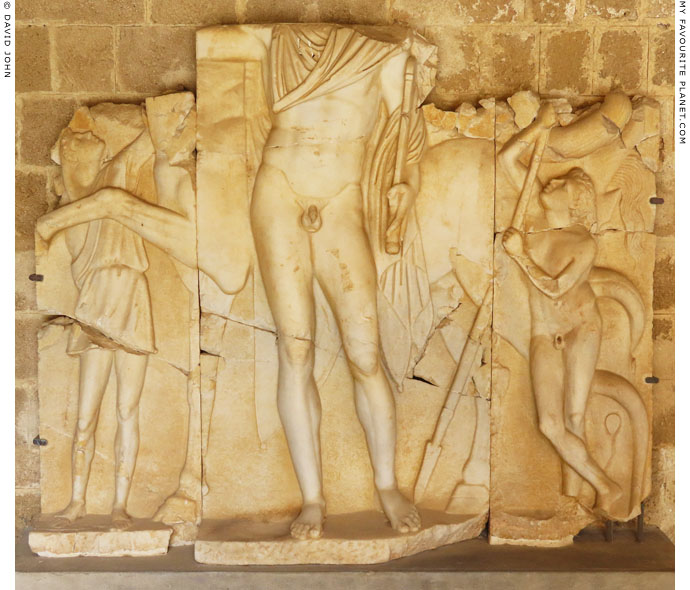
A fragmentary marble hero relief of a youth similar to the one from Loukou (see above).
This larger relief was made on three closely fitting adjacent marble slabs, the tops of
which, including the heads of the youth and horse, are now missing. The youth, naked
apart from a cloak covering his shoulders, chest and upper left arm, stands frontally in
front of his horse, holding a sword in his left hand. As opposed to the Loukou relief,
this figure rests his weight on his right leg. His left upper arm is extended to the left,
and he was probably holding the horse's reins. Behind him stand two boys as grooms,
shown at a smaller scale. The boy on the left wears a short chiton (tunic), while the
boy to the right is naked and holds the hero's spear. Above him is what appears
to be one of the coils of a snake's body.
This relief is exhibited unlabelled in the courtyard of the Palace of the Grand
Master in Rhodes Old Town. So far I have found no further information about it.
Palace of the Grand Master, Rhodes. |
| |
22. Memnon was an Ethiopian
The passing mention of Memnon as an Ethiopian appears in Philostratus the Elder's The Life of Apollonius of Tyana, the long biography of the the 1st century AD Pythagorean philosopher and miracle worker. The Greek text actually refers to "Μένωνα" (Menon), which may be an error by a scribe or copyist.
"And they were about to halt in the neighbouring village , which is hardly distant a single stade from the eminence occupied by the sages, when they saw a youth run up to them, the blackest Indian they ever saw; and between his eyebrows was a crescent-shaped spot which shone slightly. But I learn that at a later time the same feature was remarked in the case of Menon the nursling [τρόφιμον] of Herod the Sophist, who was an Ethiop; it showed while he was a youth, but as he grew up to man's estate its splendour waned and finally disappeared with his youth."
Philostratus the Elder, The Life of Apollonius of Tyana, Volume 1 (of 2), Book 3, chapter 11, pages 250-251. Loeb Classical Library edition translated from Greek by F. C. Conybeare. William Heinemann, London and The Macmillan Co., New York, 1912. At the Internet Archive.
23. Laodicea
The ancient inland city of Laodicea on the Lycus (Greek, Λαοδίκεια πρὸς τοῦ Λύκου, Laodikea pros tou Lykou; Latin, Laodicea ad Lycum), stood on the river Lycus (Turkish, Çürüksu Çayı; a triibutary of the Maeander), between Caria and Lycia, in southwestern Anatolia (Asia Minor, modern Turkey).
Originally named Diospolis (Διοσπολις, City of Zeus), and later Rhodas (Ῥόδας), it is said to have been rebuilt and renamed Laodicea during the Hellenistic period, around 261-253 BC, by the Seleucid king Antiochus II Theos in honour of his wife Laodike (Λαοδίκε). During the Roman period it became part of the province of Phrygia Pacatiana.
See, for example: Pliny the Elder, Natural History, Book 5, chapter 29; Strabo, Geography, Book 12, chapter 6, sections 16-20.
Laodicea was one of the Seven Churches of Asia addressed by The Book of Revelation (see Patmos gallery page 10). Today the archaeological site of Laodicea is 6 kilometres north of Denizli, 10 km south of Hierapolis and 160 km east of Ephesus.
24. The Panagia church at Merenda, east Attica
The inscribed base of the Archaic "Phrasikleia kore" statue by Aristion of Paros was also found in the church. The statue itself was found on the site of an ancient necropolis, 200 metres north of the church (see the Aristion of Paros page).
25. Pegasus and springs
Strabo wrote that Bellerophon was said to have first captured Pegasus at the spring of Peirene, but seems to be implying that this was on Acrocorinth rather than in the lower city of Corinth. He also recounted that Pegasus striking its foot on the rock to create the Hippocrene (Ἵππου κρήνην, Horse Spring) occurred on Mount Helicon (Ἑλικῶνι) in Boeotia.
"And they say that the spring at the base of the mountain is the joint result of pressure from this and other subterranean veins of water - a spring which flows out into the city in such quantity that it affords a fairly large supply of water. And there is a good supply of wells throughout the city, as also, they say, on the Acrocorinthus; but I myself did not see the latter wells. At any rate, when Euripides says, 'I am come, having left Acrocorinthus that is washed on all sides, the sacred hill-city of Aphrodite,' one should take 'washed on all sides' as meaning in the depths of the mountain, since wells and subterranean pools extend through it, or else should assume that in early times Peirene was wont to rise over the surface and flow down the sides of the mountain.
And here, they say, Pegasus, a winged horse which sprang from the neck of the Gorgon Medusa when her head was cut off, was caught while drinking by Bellerophon. And the same horse, it is said, caused Hippu-crene to spring up on Helicon when he struck with his hoof the rock that lay below that mountain."
Strabo, Geography, Book 8, chapter 6, section 21. The Loeb Classical Library edition, edited by H. L. Jones. Harvard University Press, Cambridge, Mass., and William Heinemann, Ltd, London, 1924. At Perseus Digital Library.
The notes to this edition point at that when Euripides wrote that Acrocorinth is "washed on all sides", he probably meant that the rock is surrounded by sea (see Geography of Greece): "The Greek word περίκλυστον is translated above in its usual sense and as Strabo interpreted it, but Euripides obviously used it in the sense of 'washed on both sides', that is, by the Corinthian and Saronic Gulfs (cf. Horace's 'bimaris Corinthi', Horace C. 1.7.2)."
The tale of Pegasus creating the Hippocrene spring in Boeotia with its hoof was also related by the Roman author Hyginus, when describing the mythical origin of the astronomical constellation the Horse:
"This sign Aratus and many others have called Pegasus, offspring of Neptune [Poseidon] and the Gorgon Medusa, who on Helicon, a mountain of Boeotia, opened up a spring by striking the rock with his hoof. From him the spring is called Hippocrene."
Hyginus, Poeticon astronomicon, 2.18, The Horse. At the Theoi Project.
For further information about Hyginus, see the note in Homer part 2.
26. Dimensions of the "Leda sarcophagus" in Kifissia
As with many artworks and archaeological objects, various publications state different dimensions, often without citing their sources, or making it clear whether the authors have measured the objects themselves.
The data provided by Arachne, the central object database of the Deutsches Archäologisches Institut (DAI, German Archaeological Institute) and the Archäologisches Institut der Universität zu Köln (Archaeological Institute of the University of Cologne), often differs from other sources. It gives the following dimensions for the sarcophagus: Height 110.5 cm, width 323 cm, depth 88 cm.
145665: attischer Sarkophag: Helena und die Dioskuren. Leda. At arachne.
|
|
|
| |
Photos on this page were taken during
visits to the following museums:
Germany
Berlin, Altes Museum
Hamburg, Museum für Kunst und Gewerbe
Greece
Athens, Epigraphical Museum
Athens, National Archaeological Museum
Athens, Odeion of Herodes Atticus and Acropolis archaeological site
Athens, Panathenaic Stadium
Chalkis, New Archaeological Museum "Arethousa"
Corinth, Ancient Corinth archaeological site
Corinth Archaeological Museum
Delphi Archaeological Site
Eleusis Archaeological Site
Isthmia Archaeological Museum
Kifissia, Roman Tomb Monument
Marathon Archaeological Museum
Marathon, Sanctuary of the Egyptian Gods, Brexiza
Olympia Archaeological Museum
Olympia Archaeological Site
Olympia, Museum of the History of the Ancient Olympic Games
Patras Archaeological Museum
Patras, Roman Odeion archaeological site
Piraeus Archaeological Museum
Rhodes, Palace of the Grand Master
Italy
Naples, National Archaeological Museum
Rome, Tomb of Annia Regilla, Caffarella Park
United Kingdom
London, British Museum
Oxford, Ashmolean Museum
Many thanks to the staff of these museums. |
|
| Photos and articles © David John, except where otherwise specified. |
 |
Visit the My Favourite Planet Group on Facebook.
Join the group, write a message or comment,
post photos and videos, start a discussion... |
|
|
| |
| Copyright © 2003-2025 My Favourite Planet | contributors | impressum | contents | sitemap |
| |

